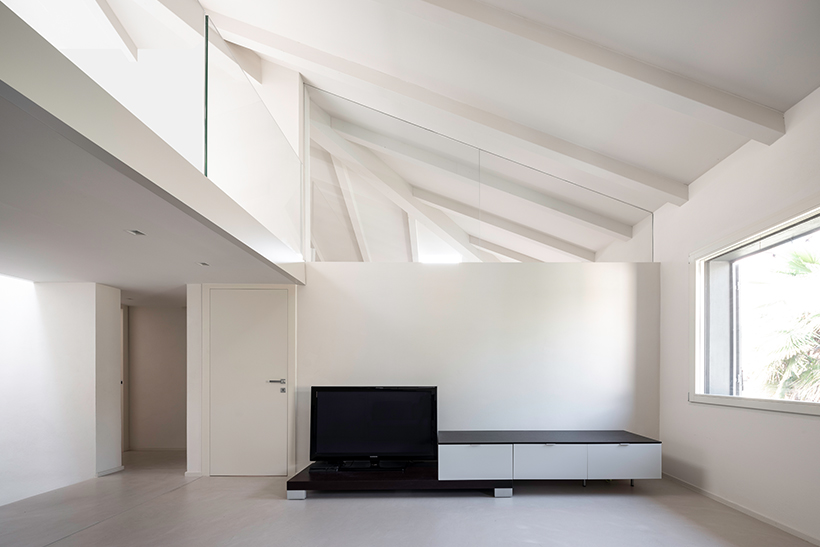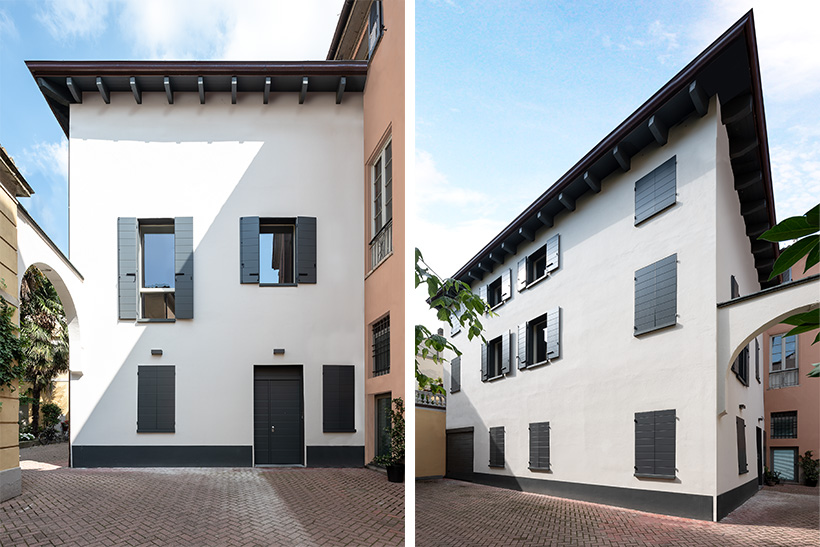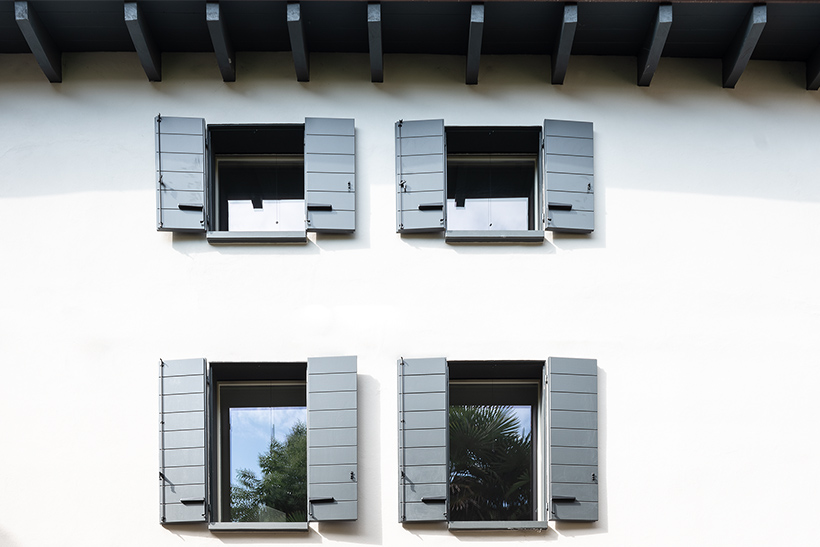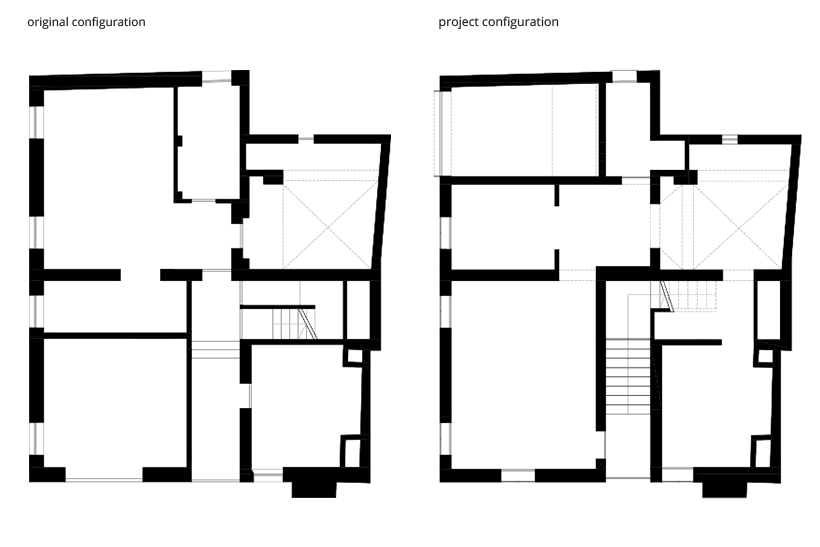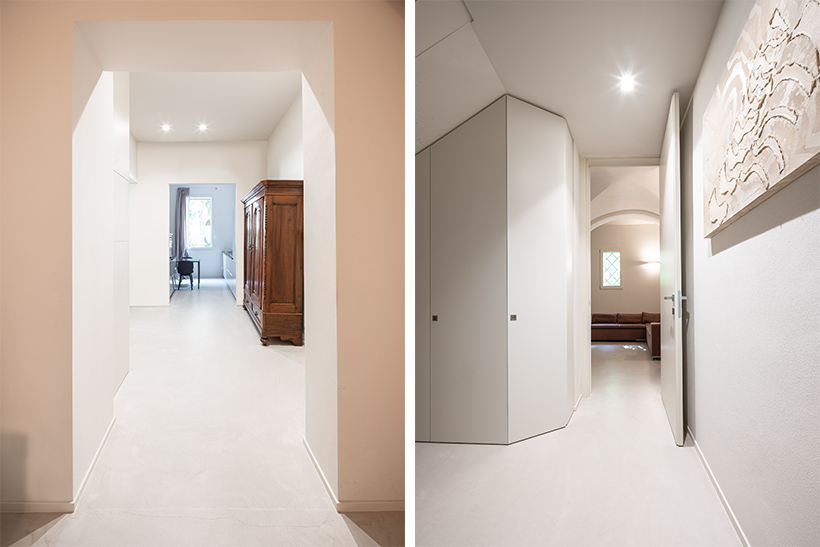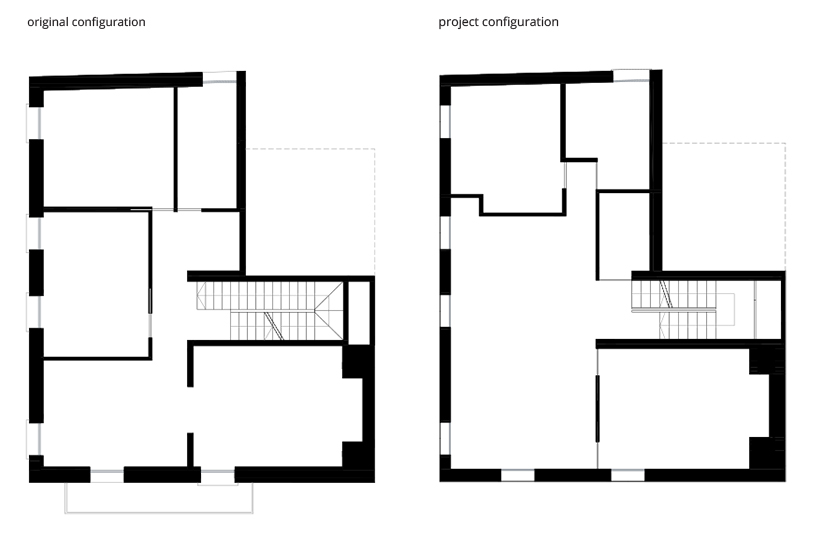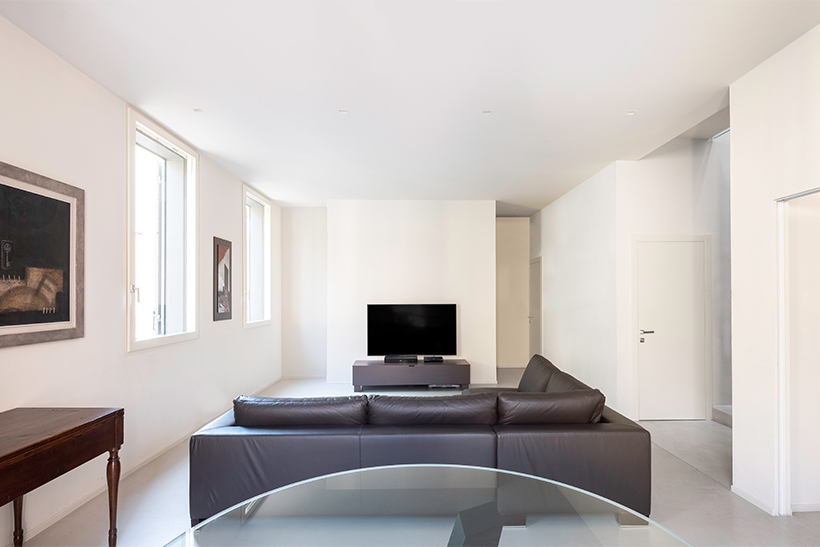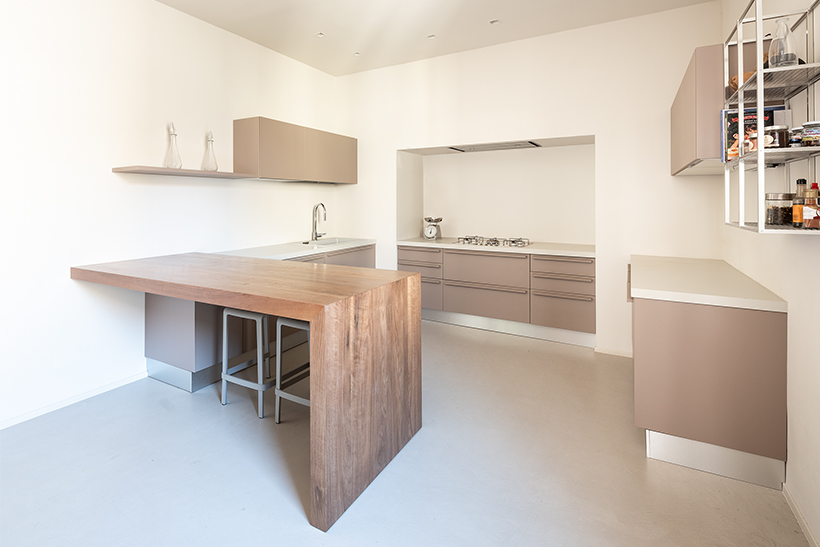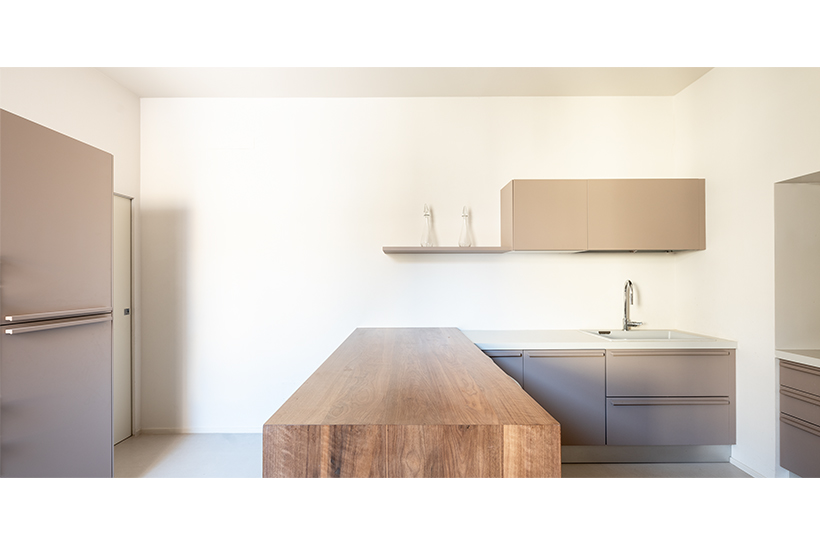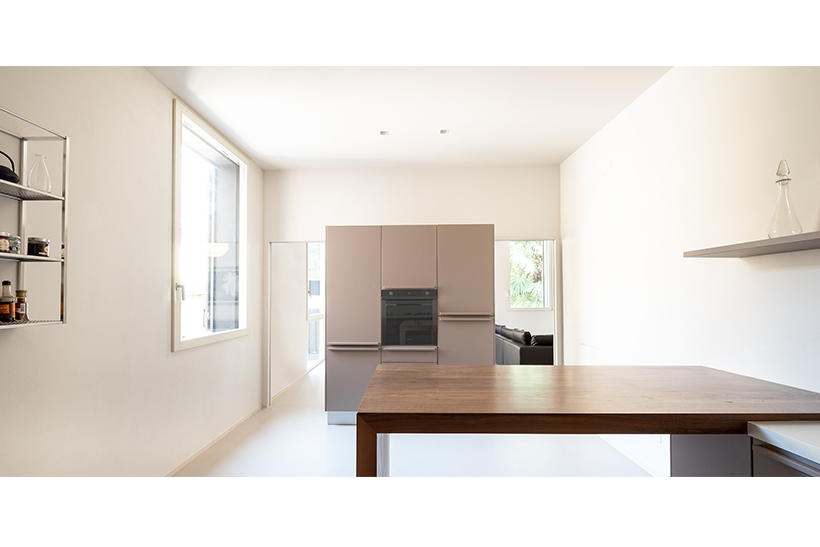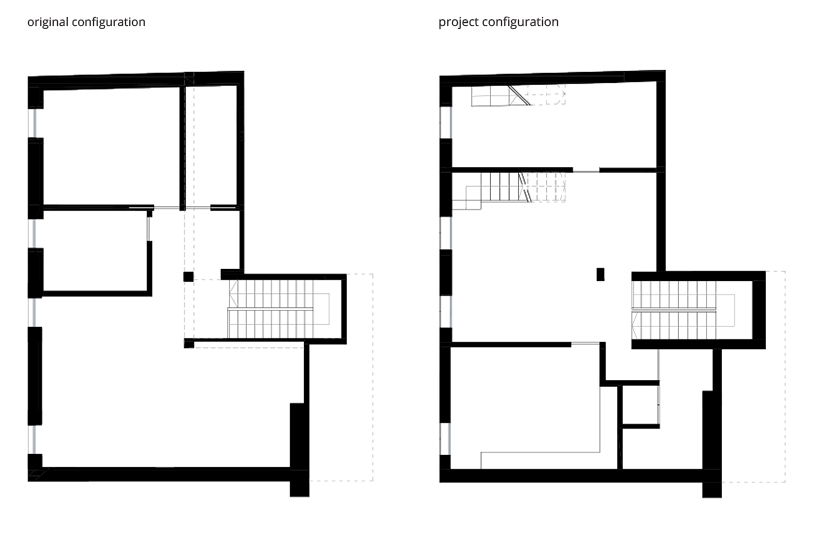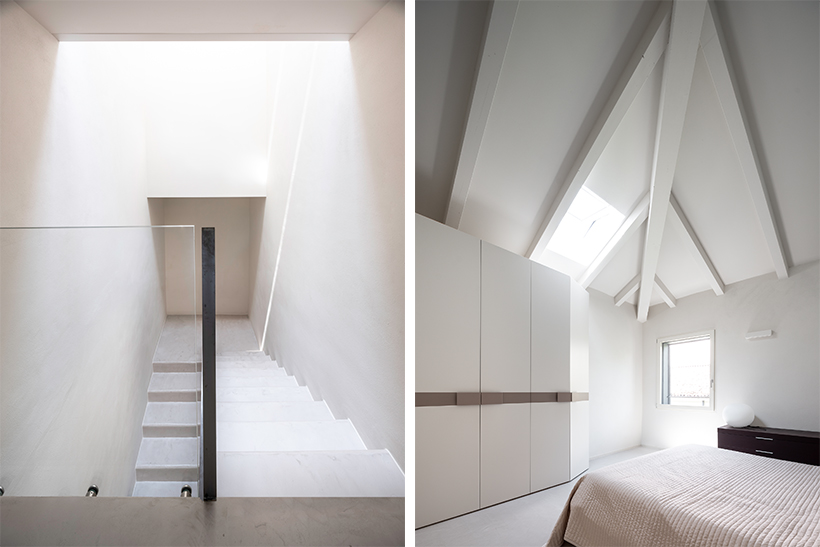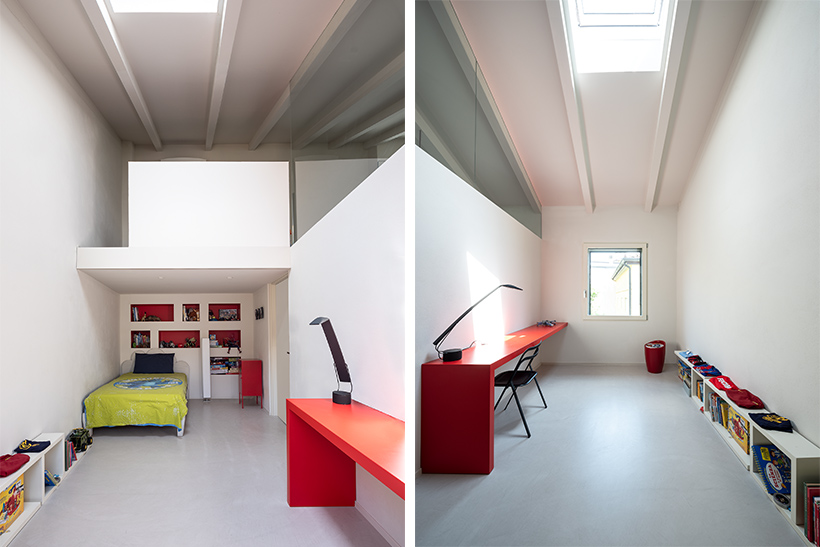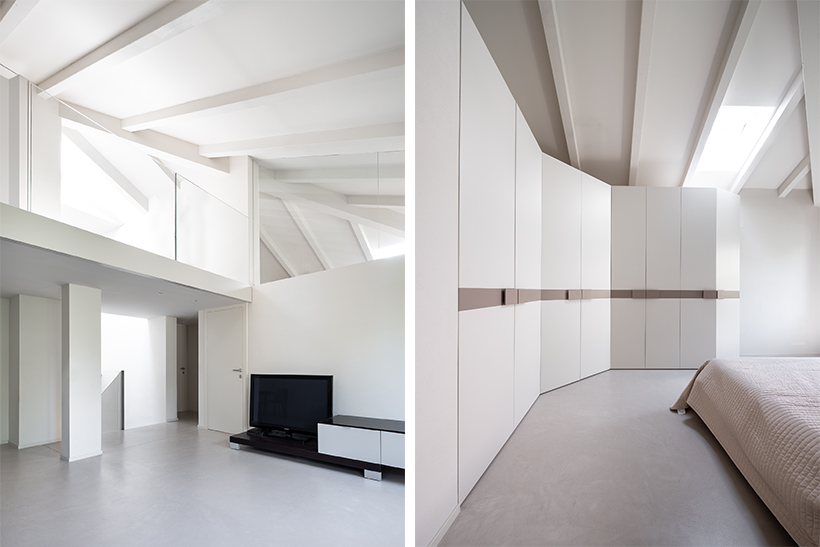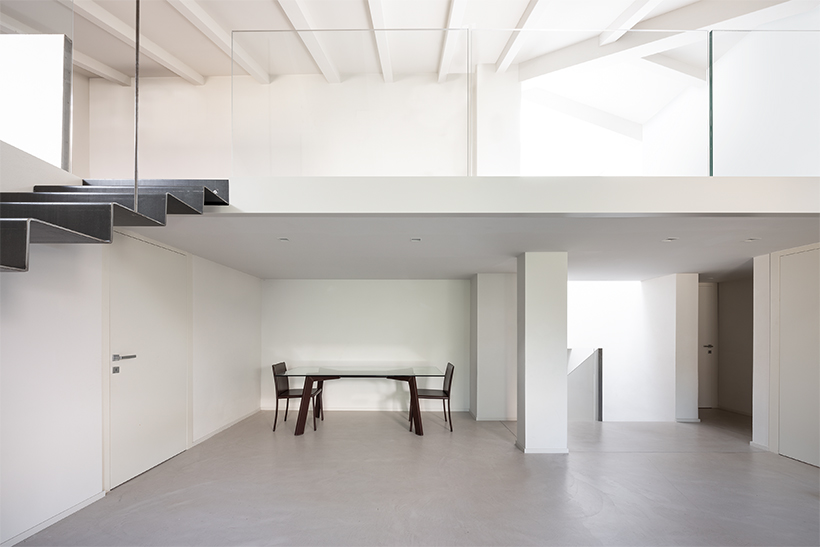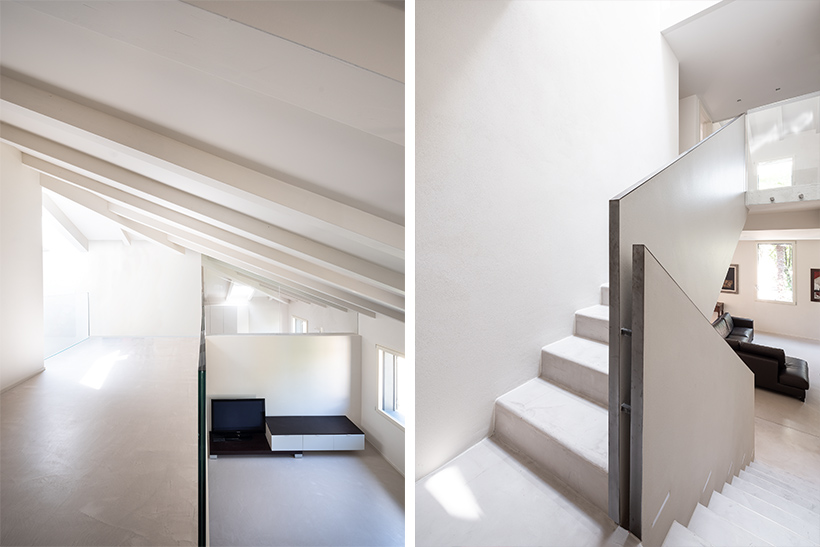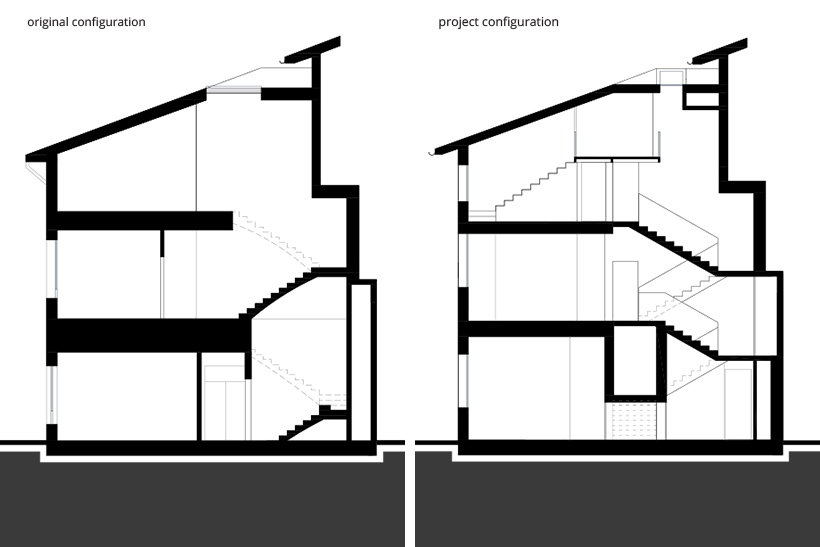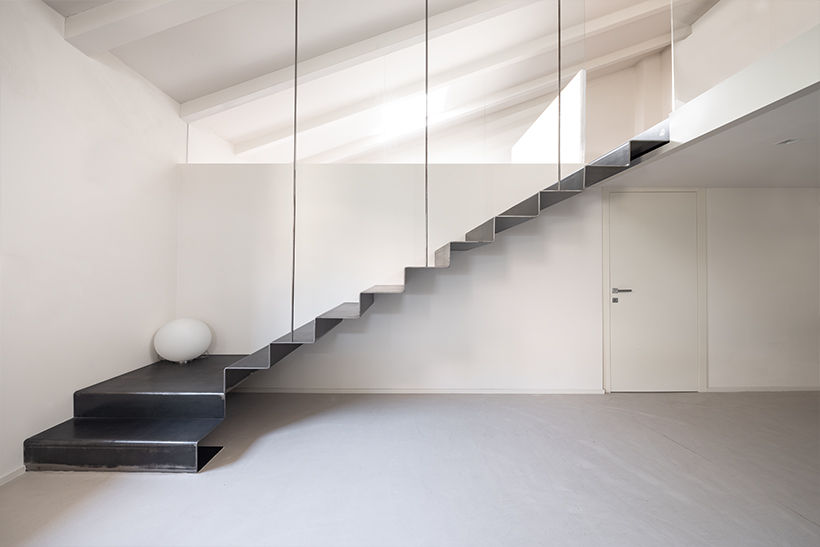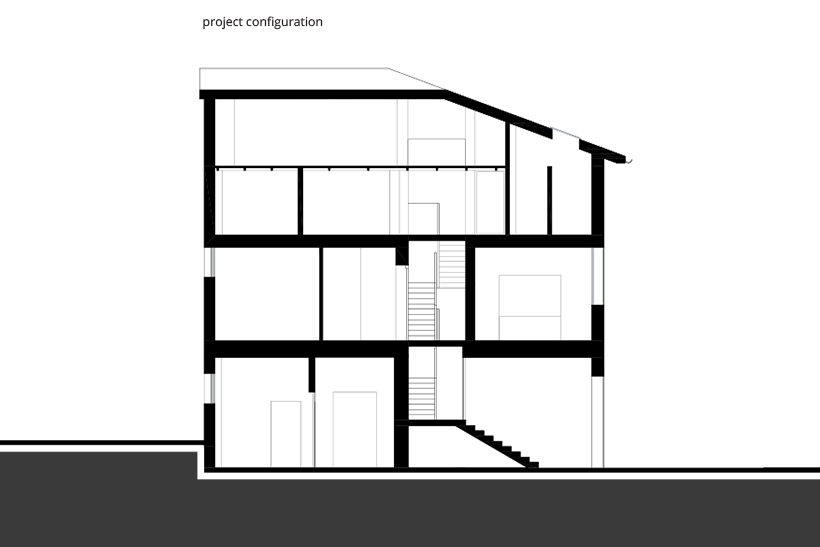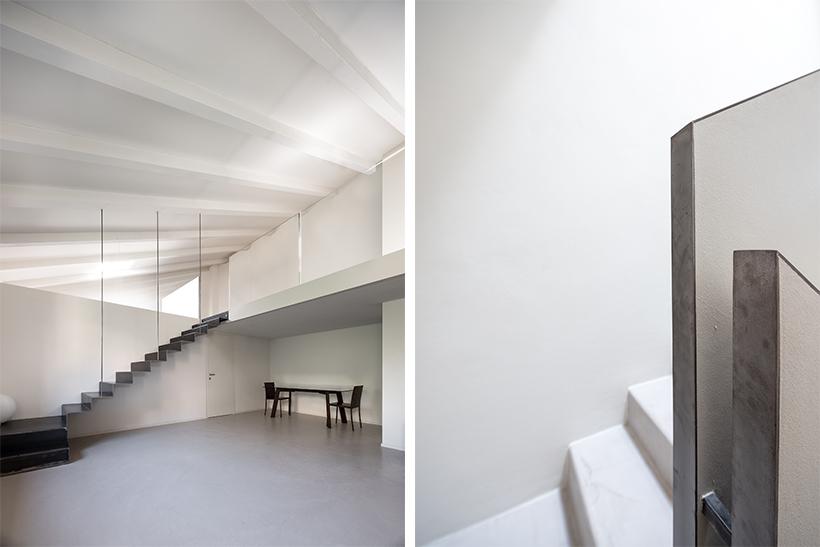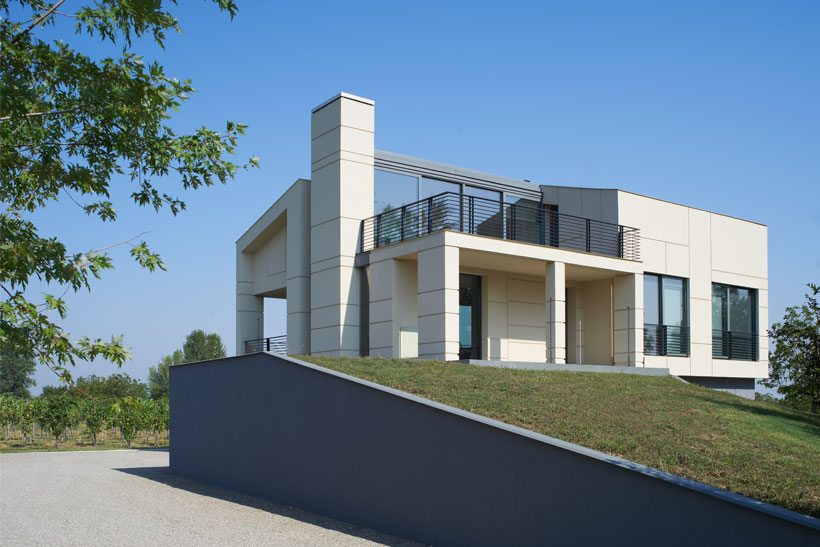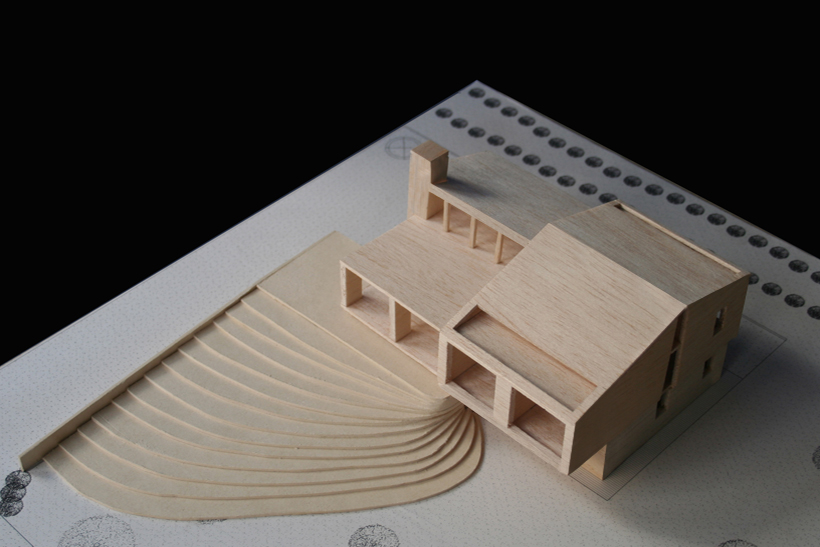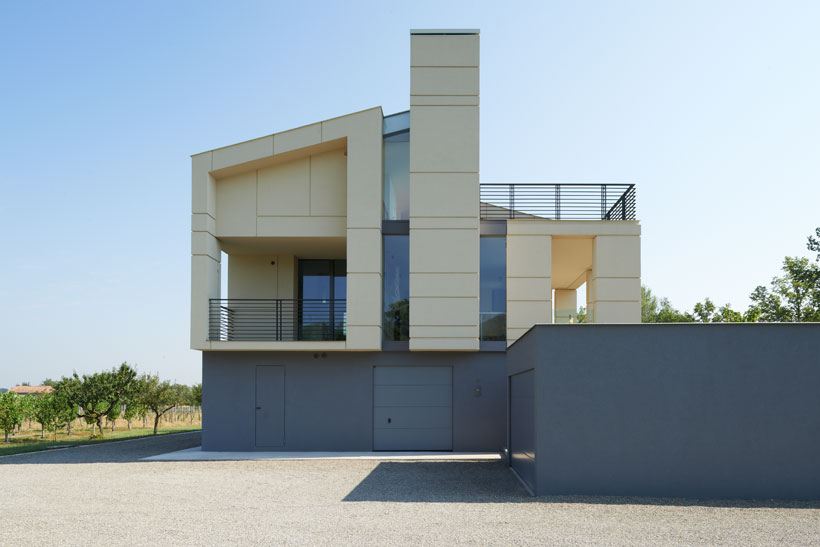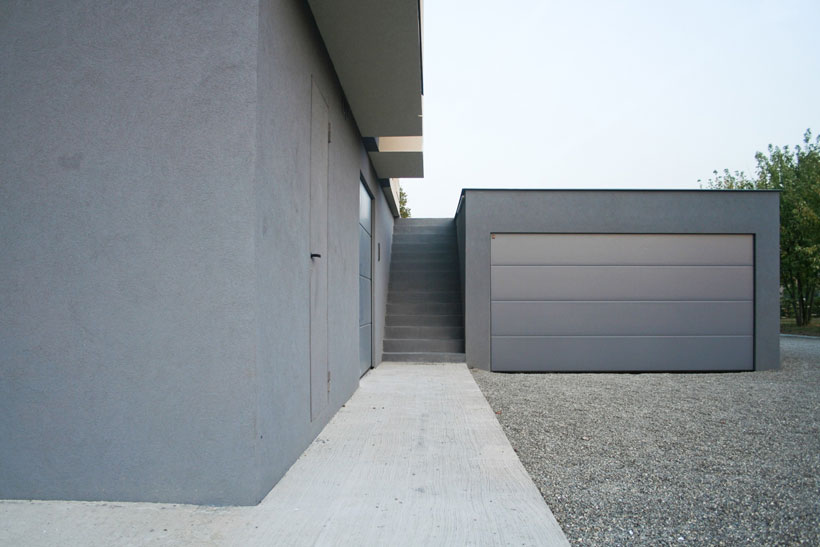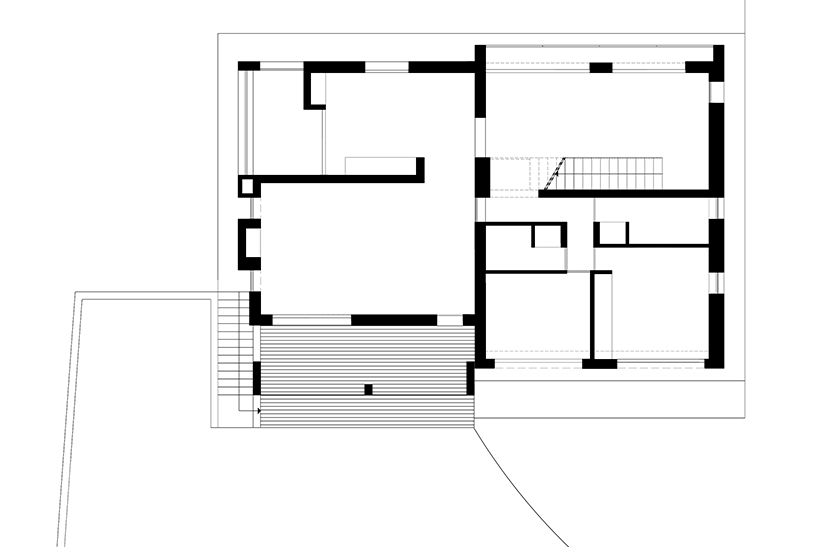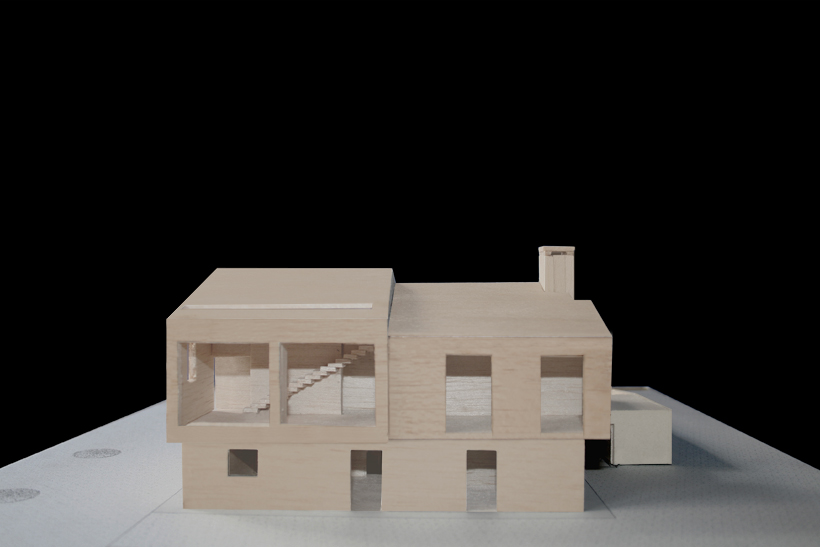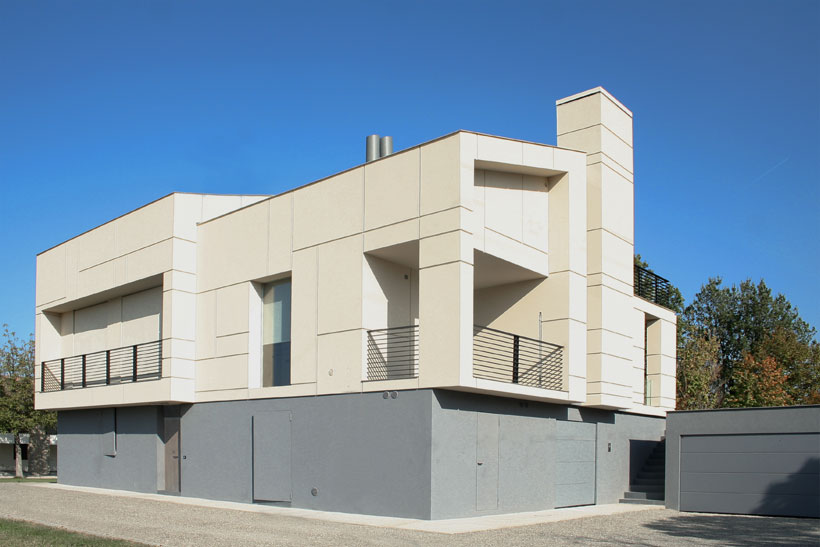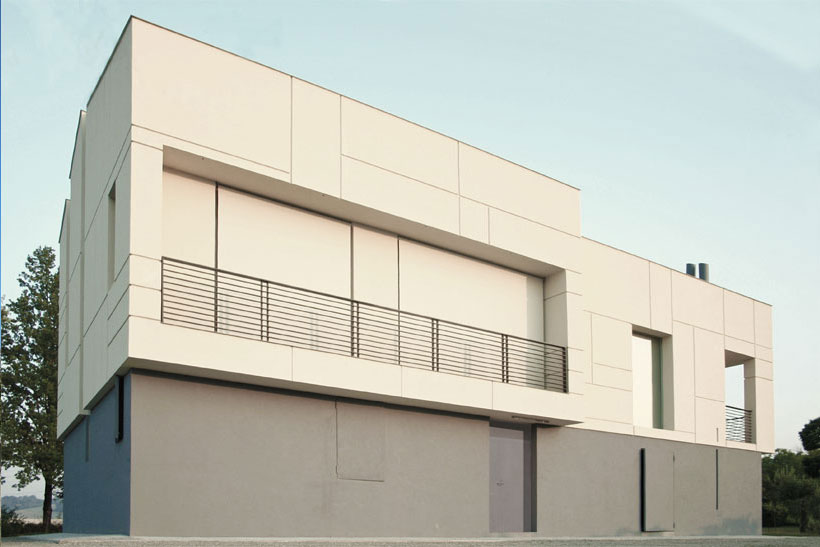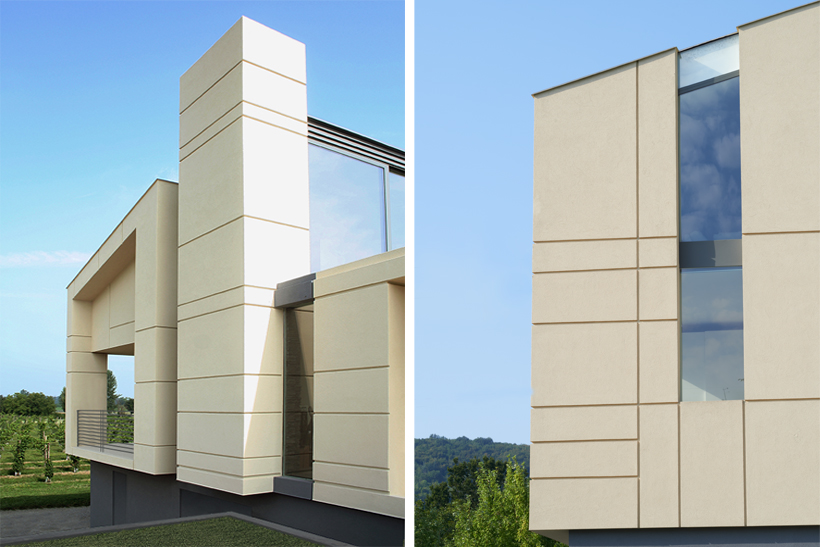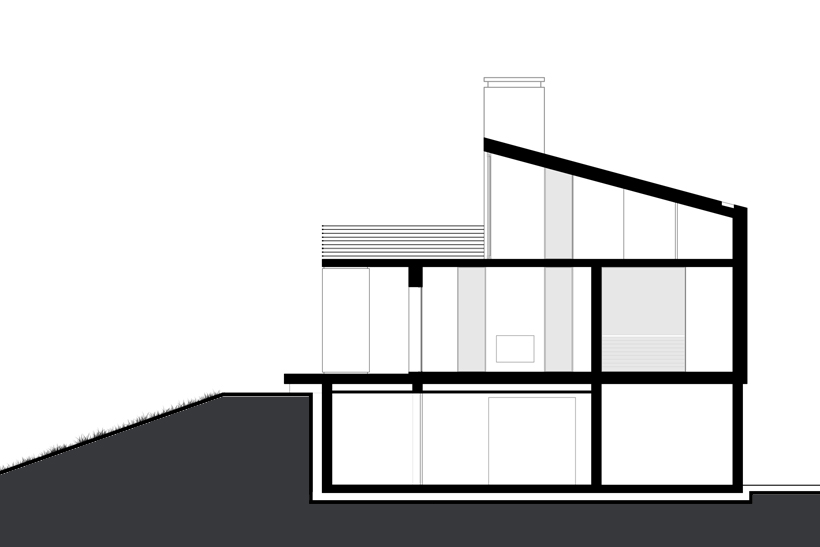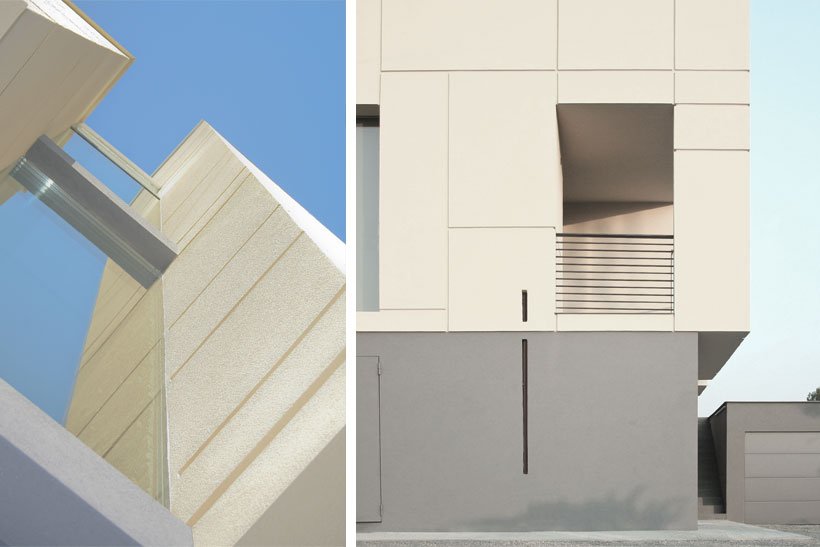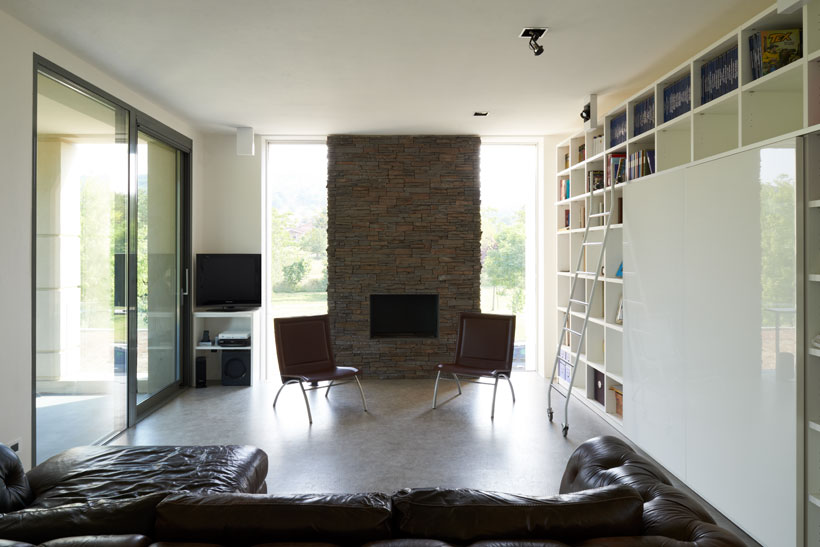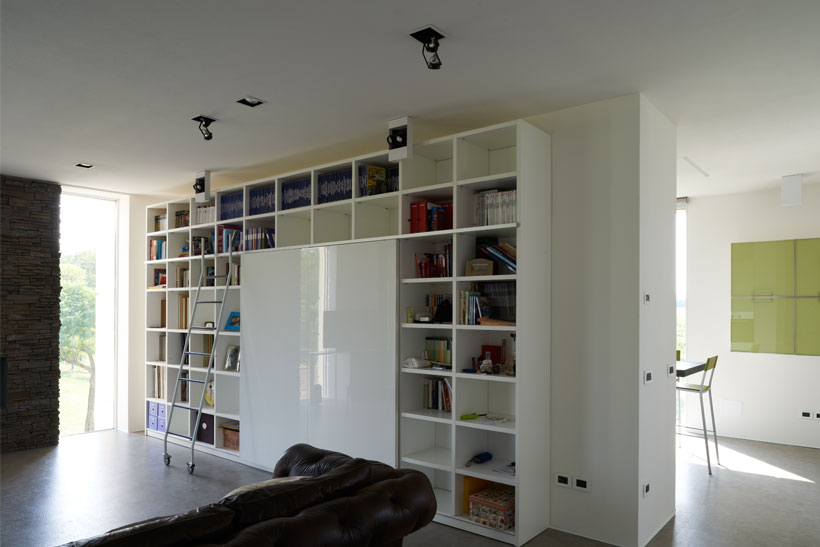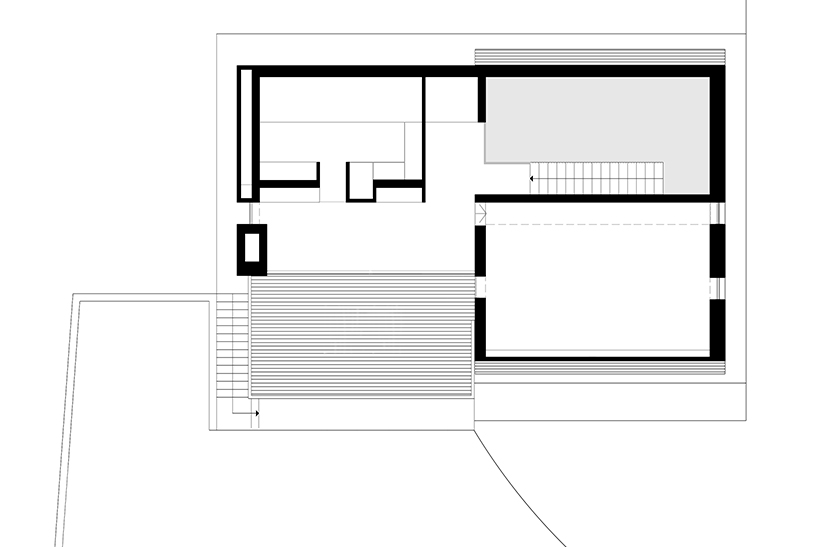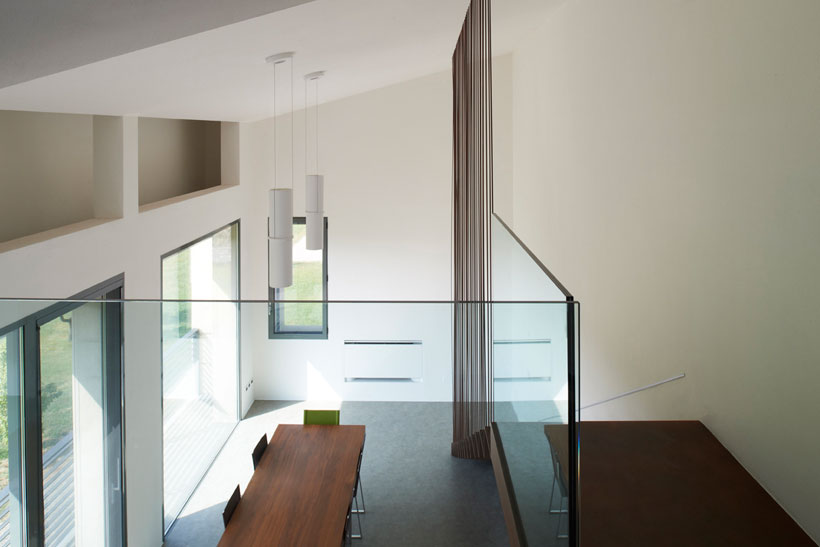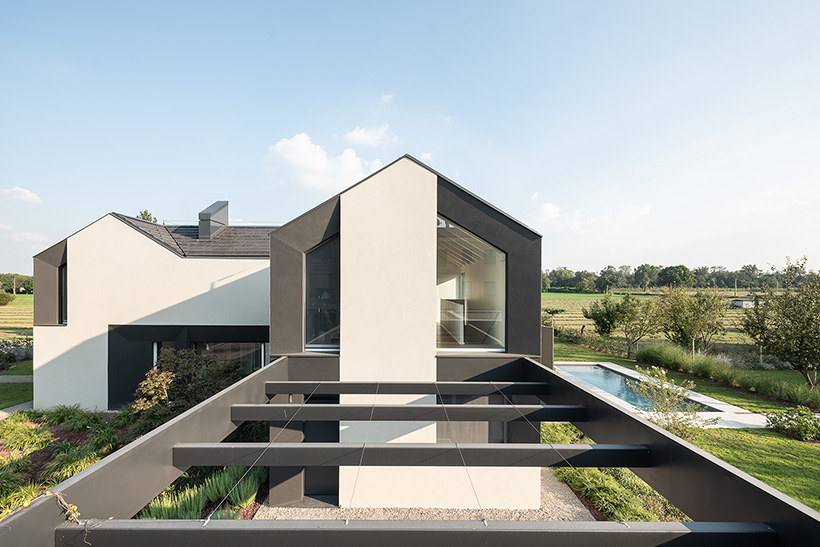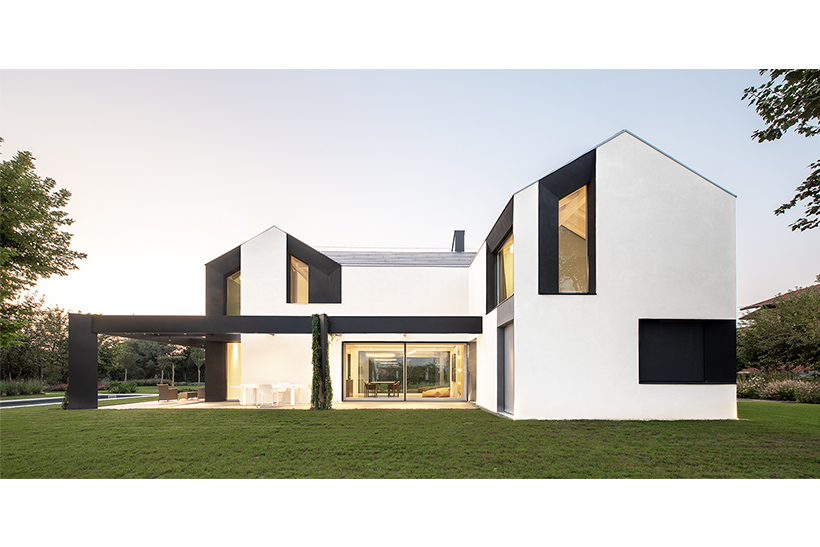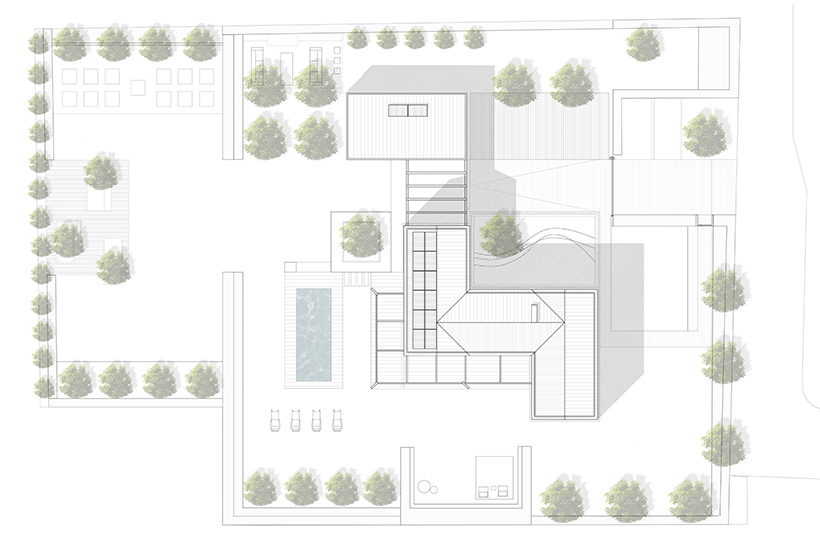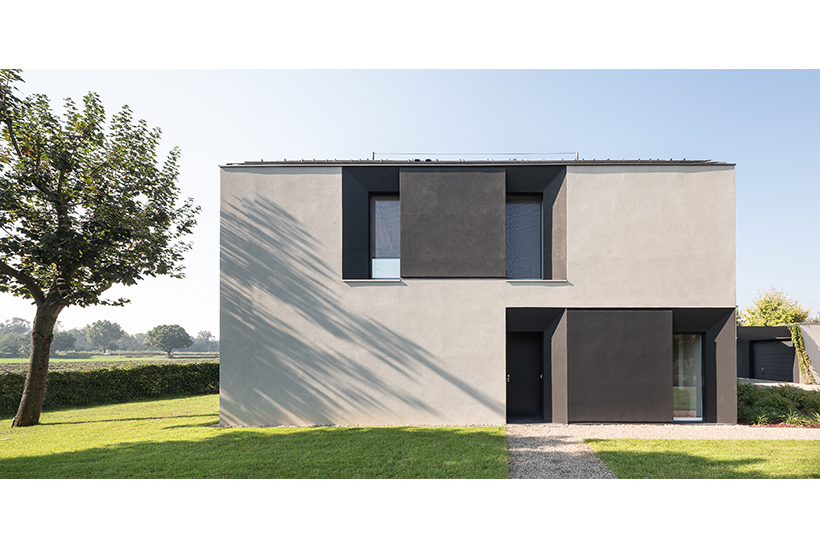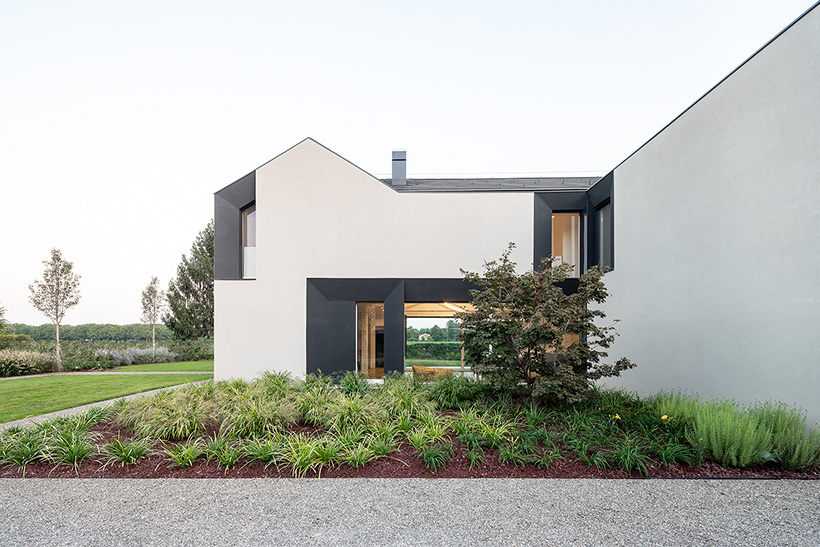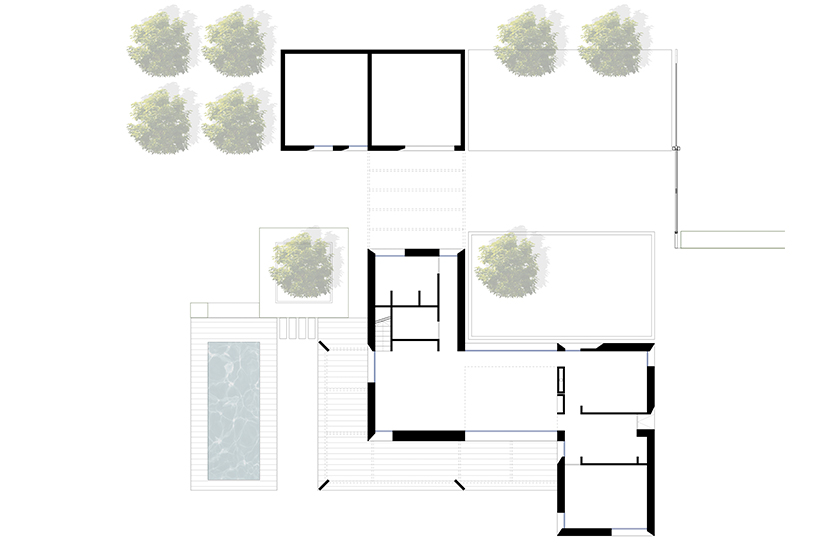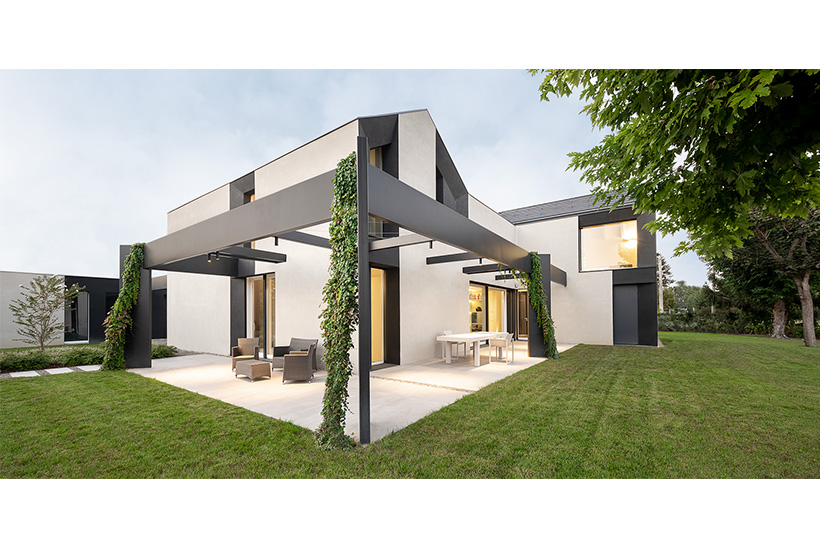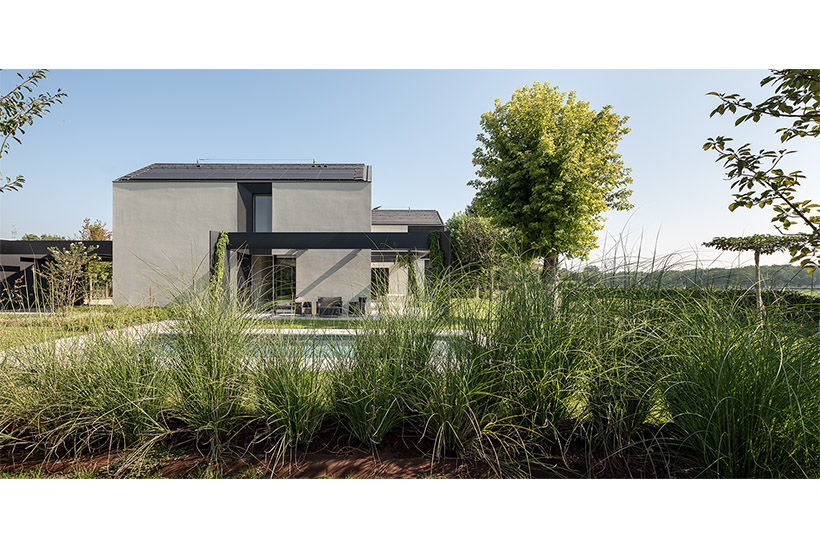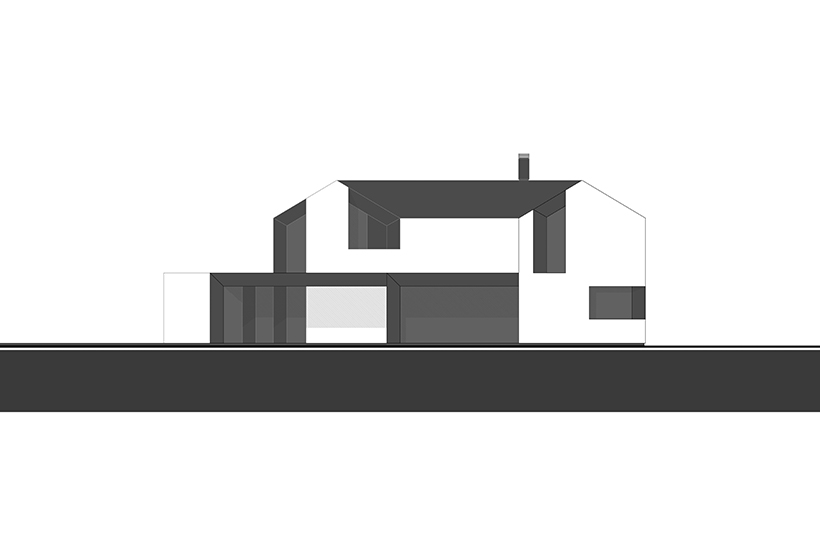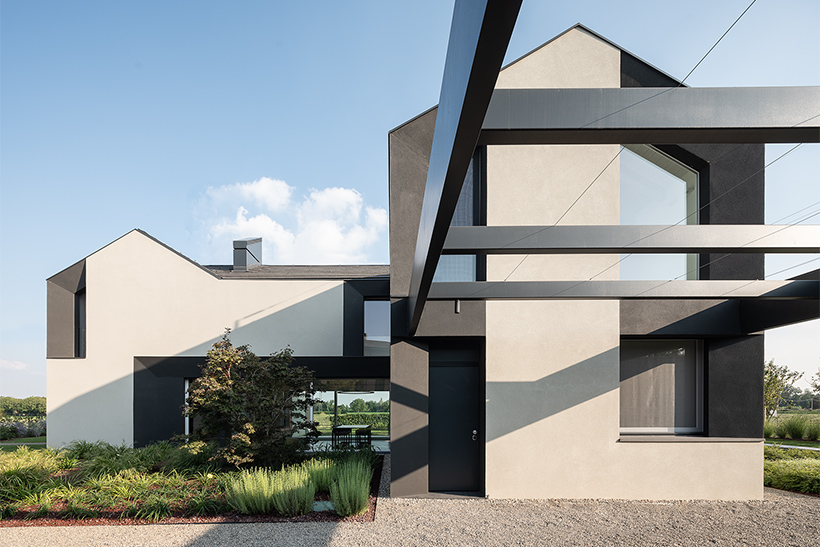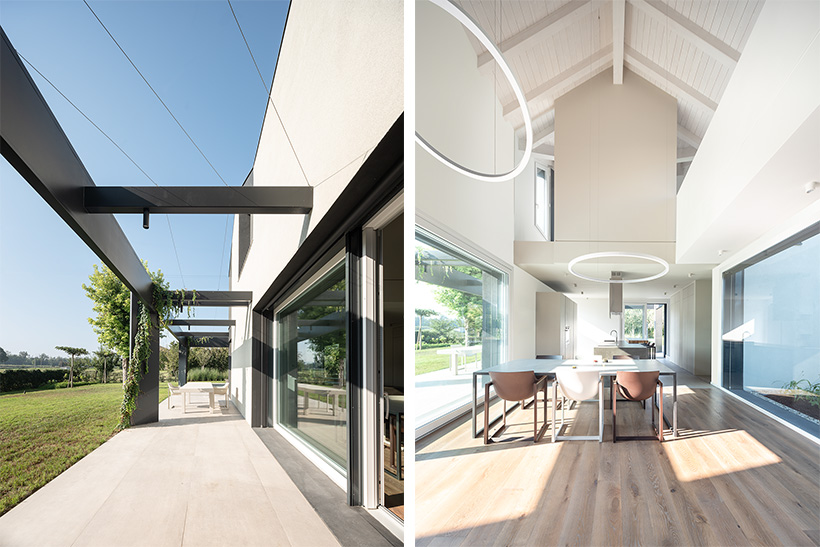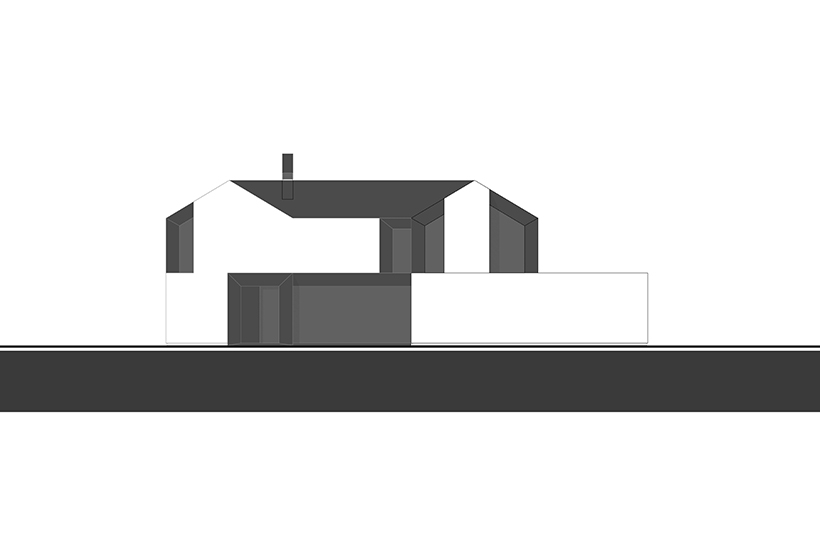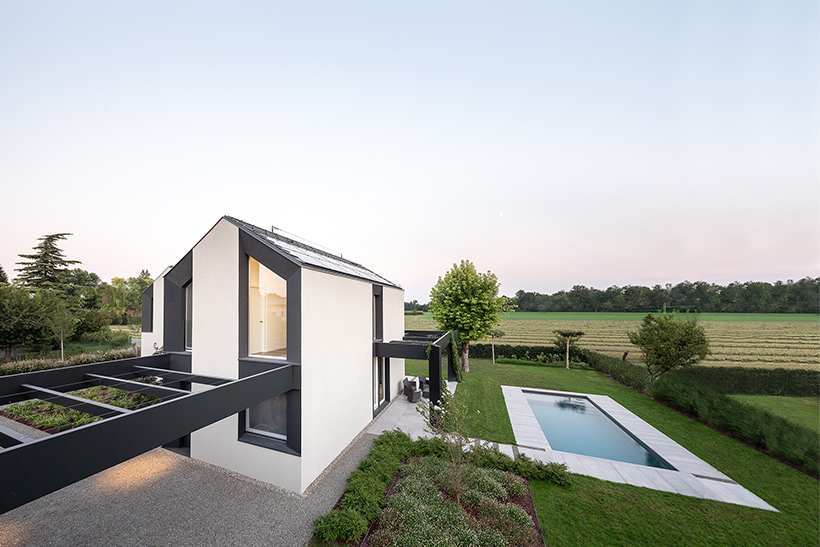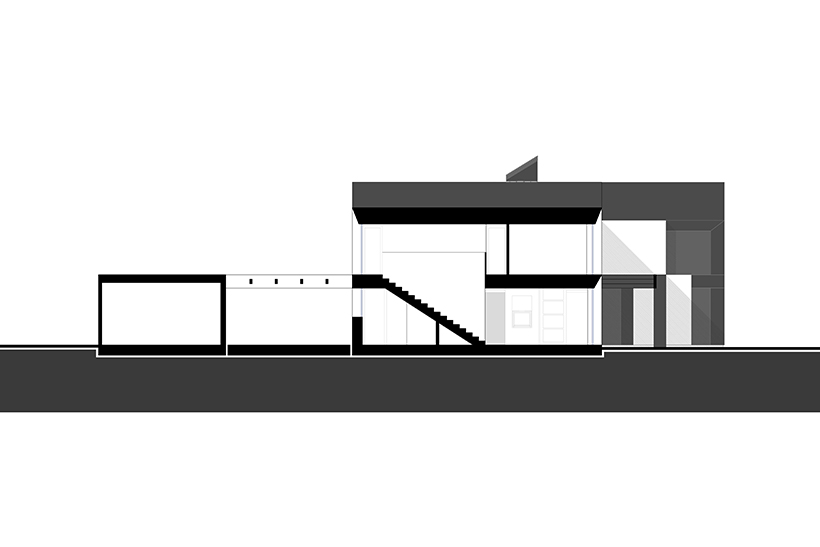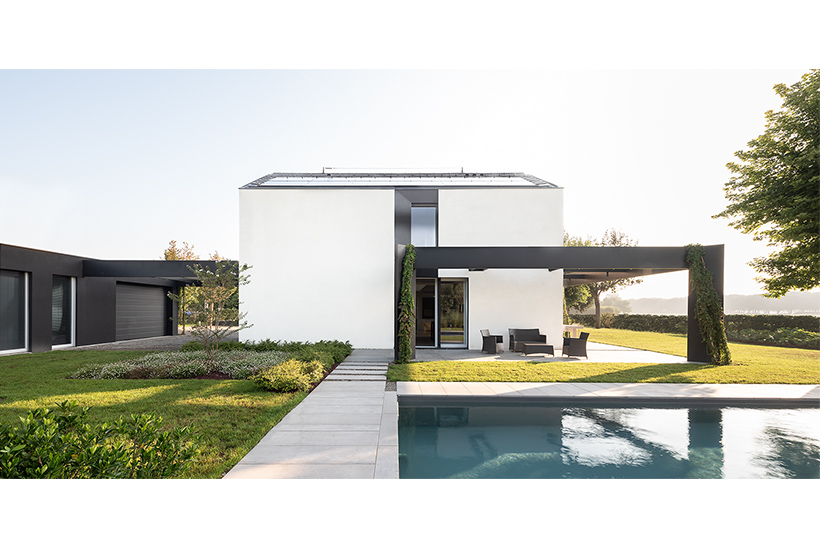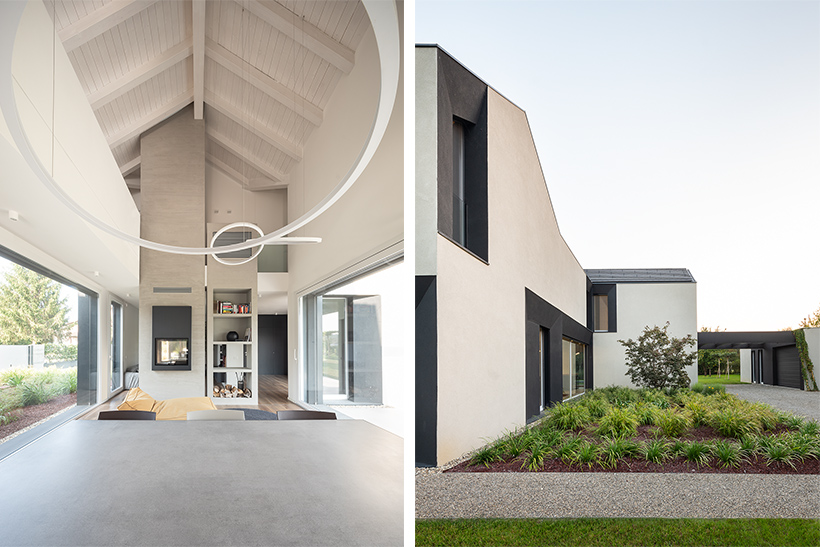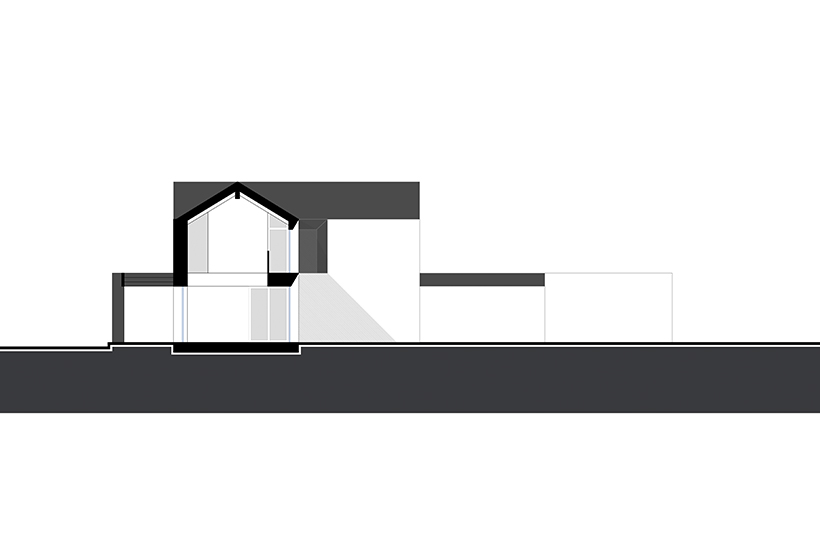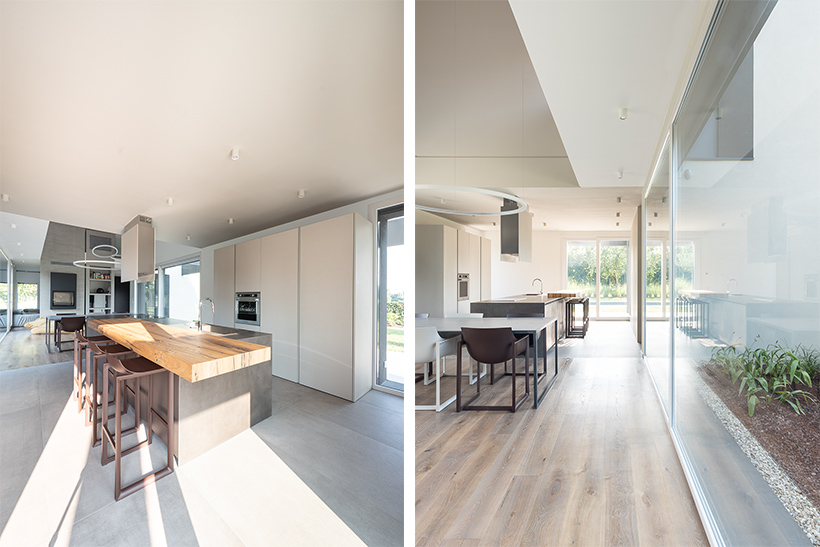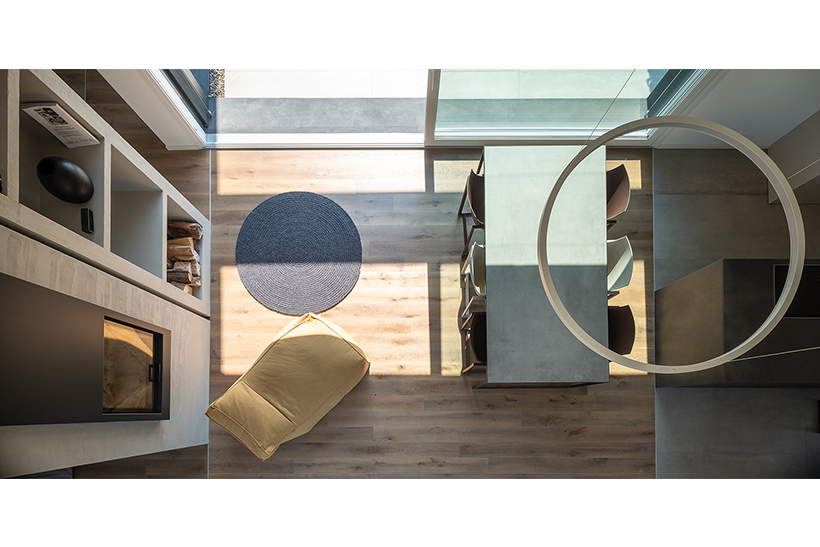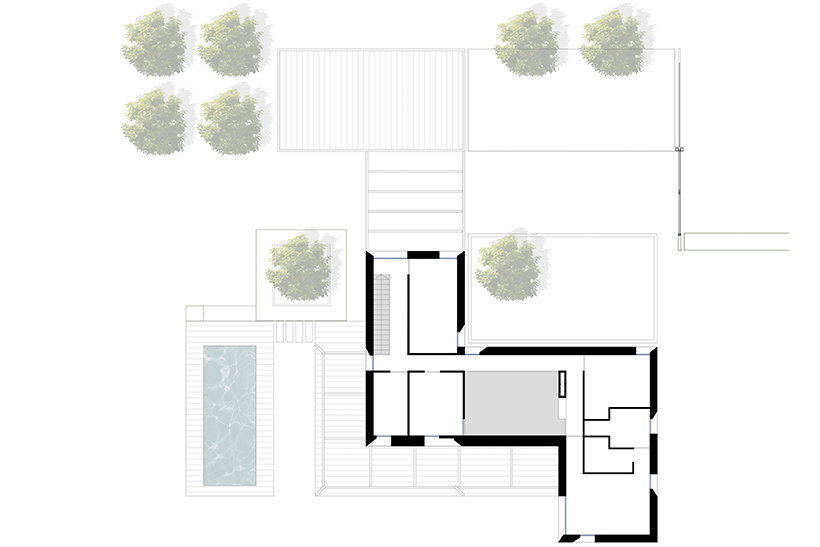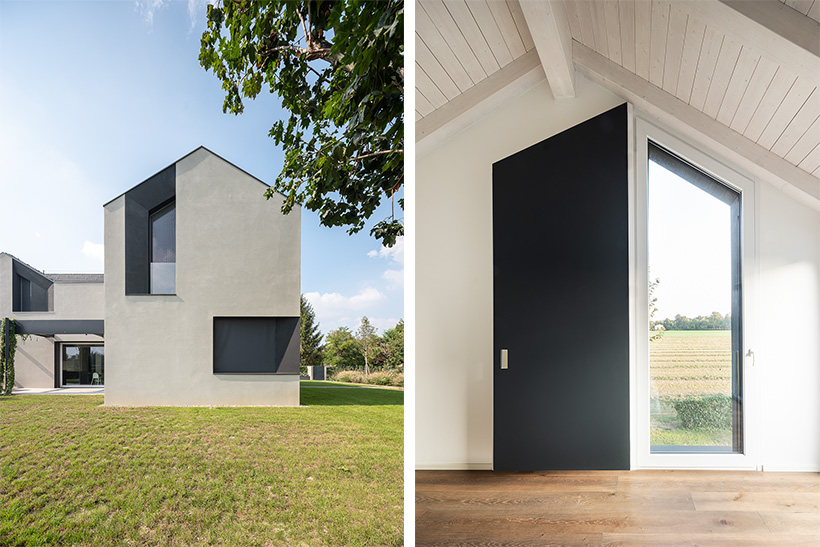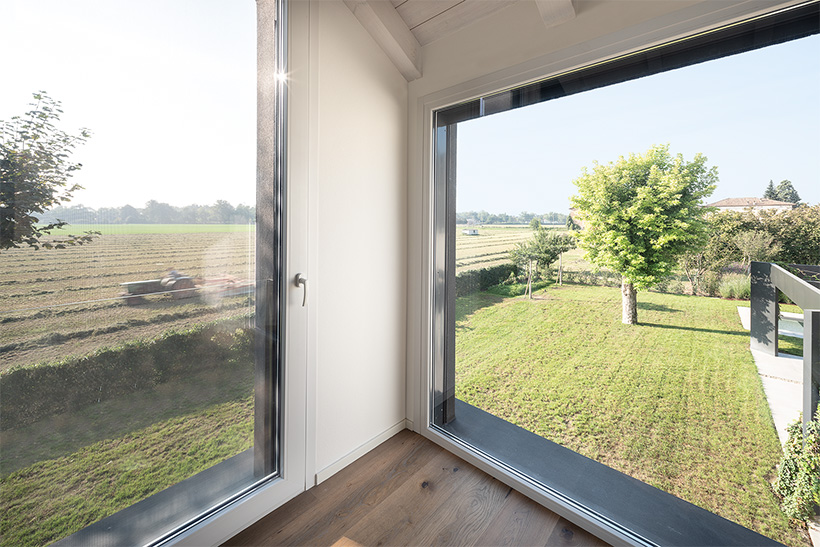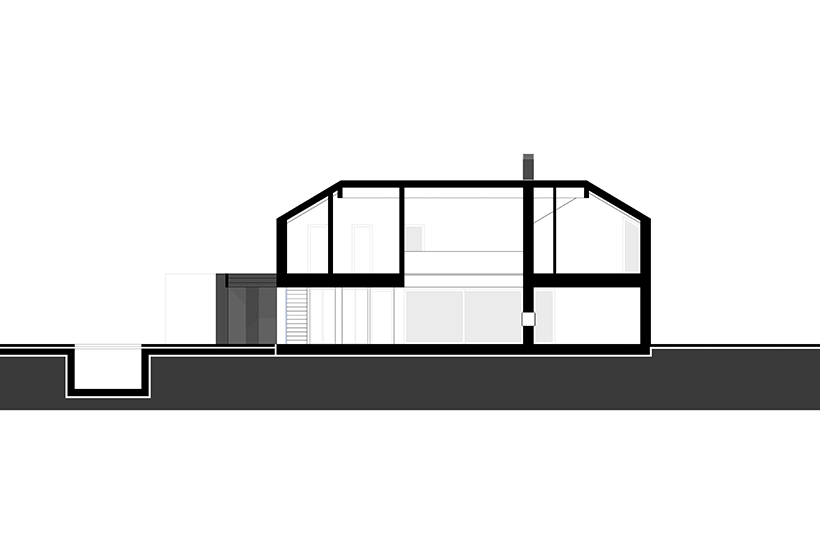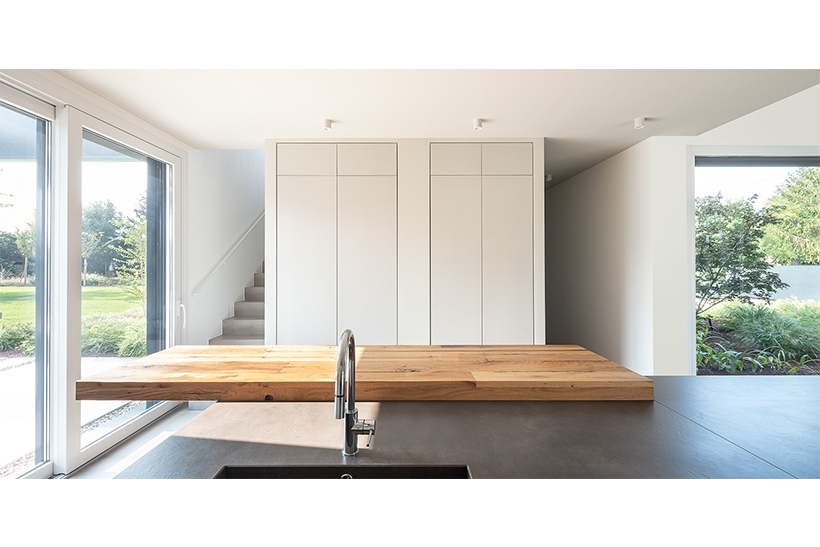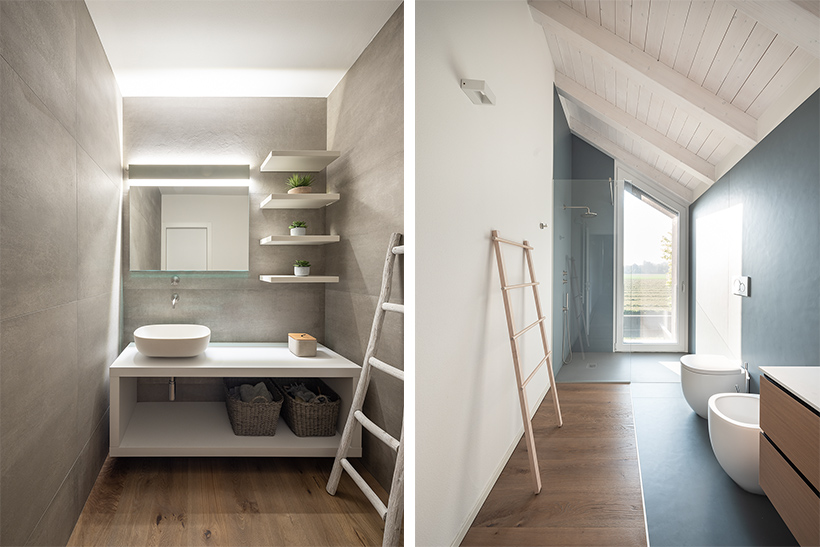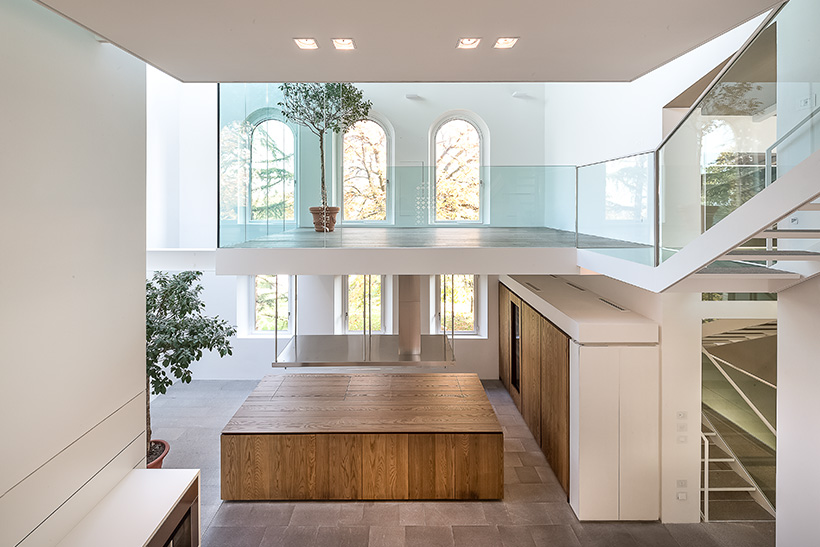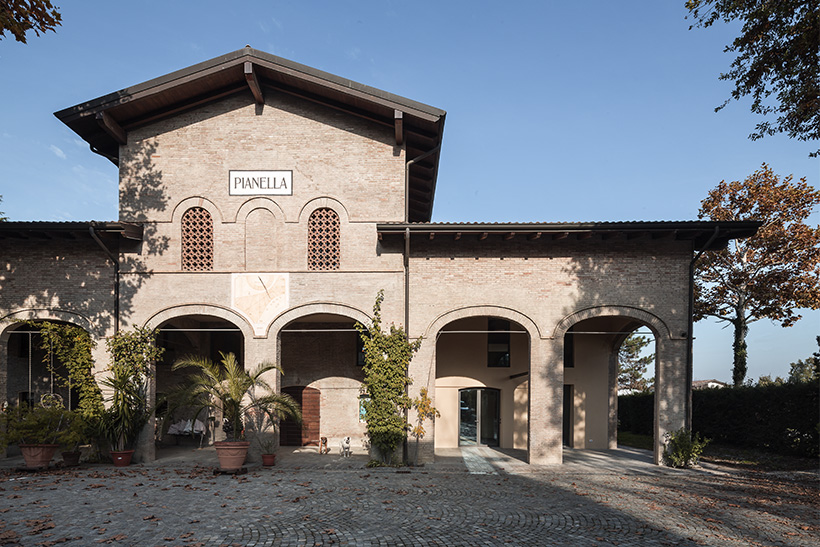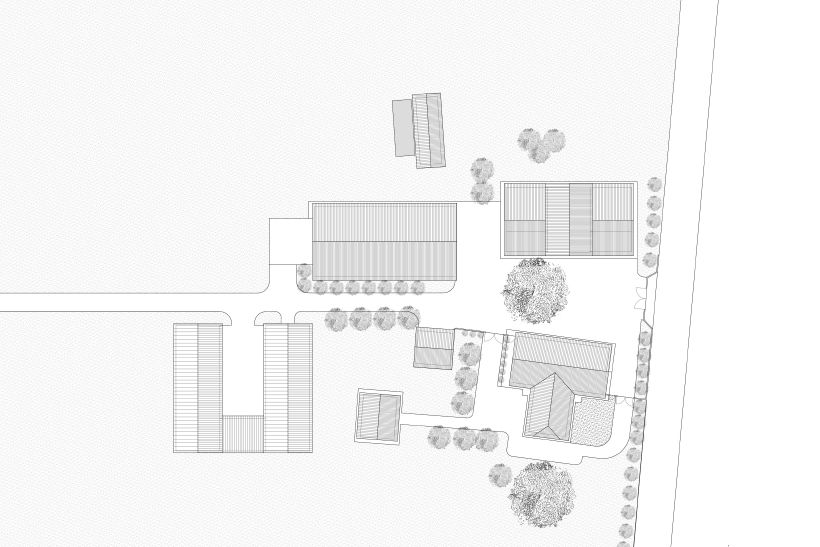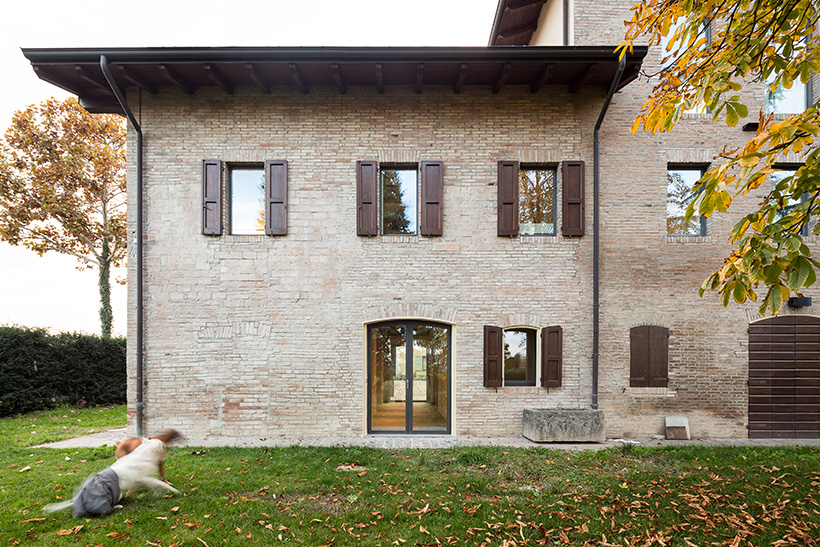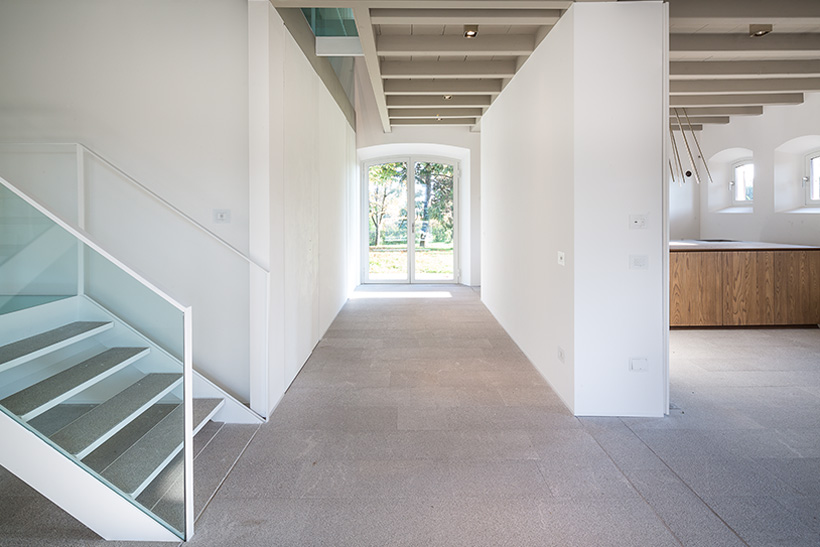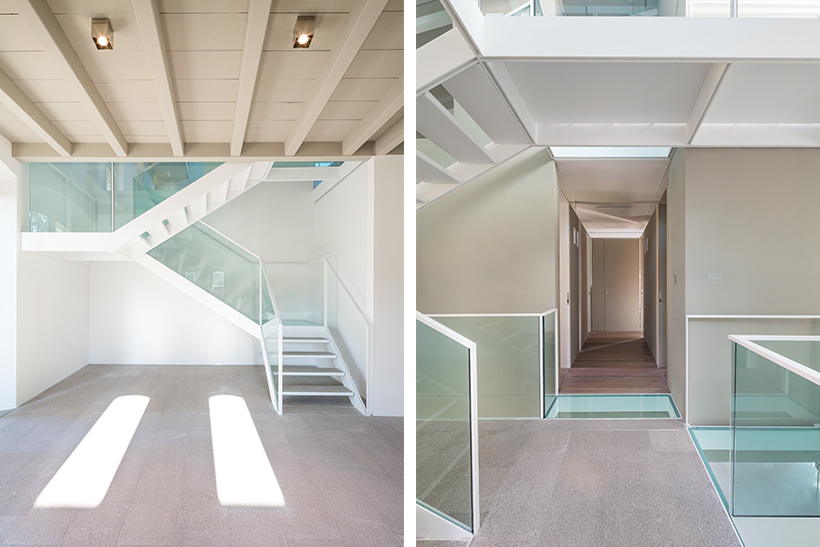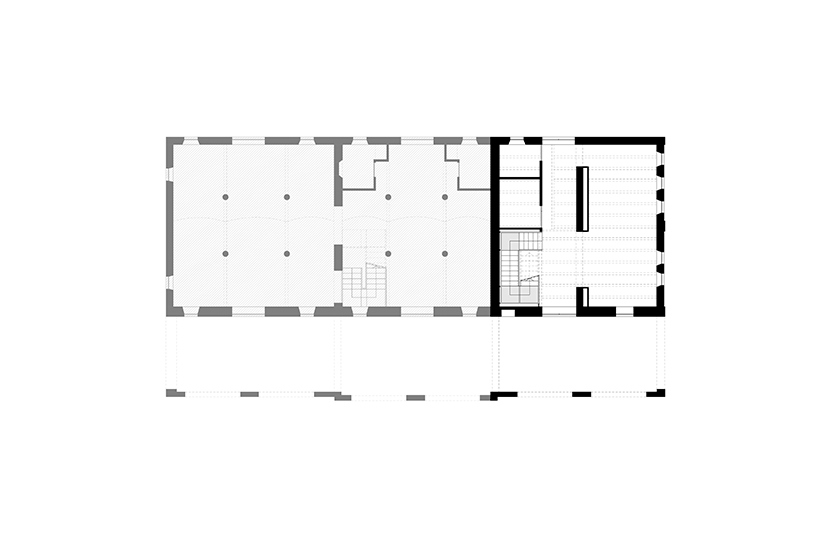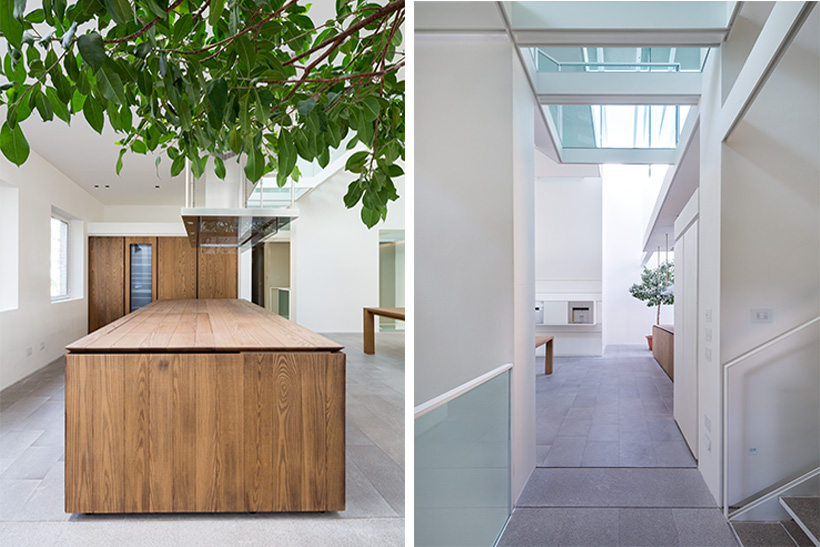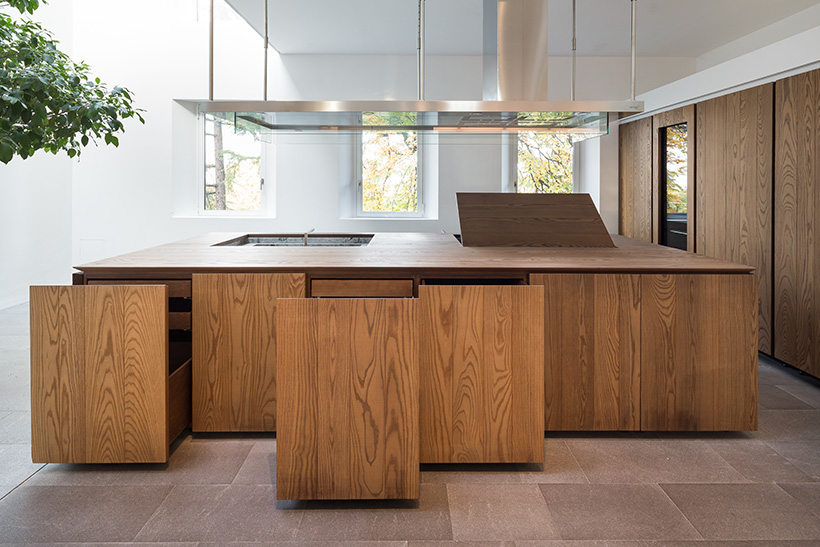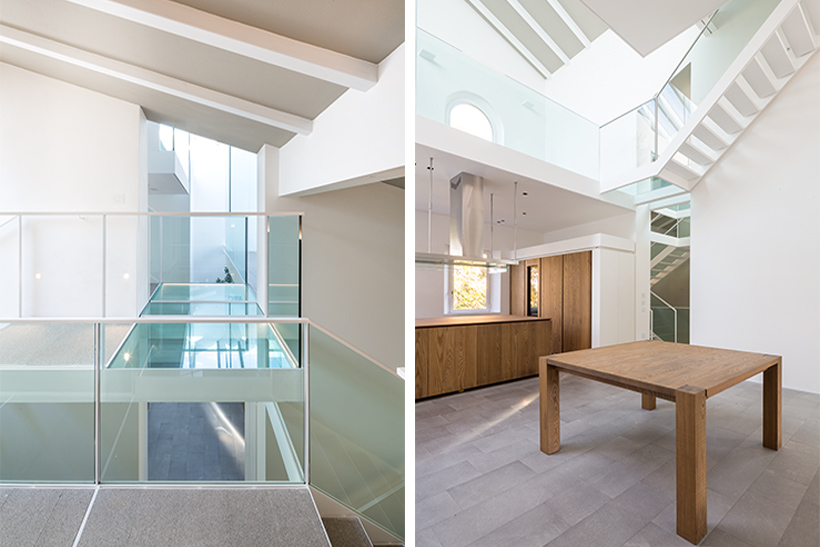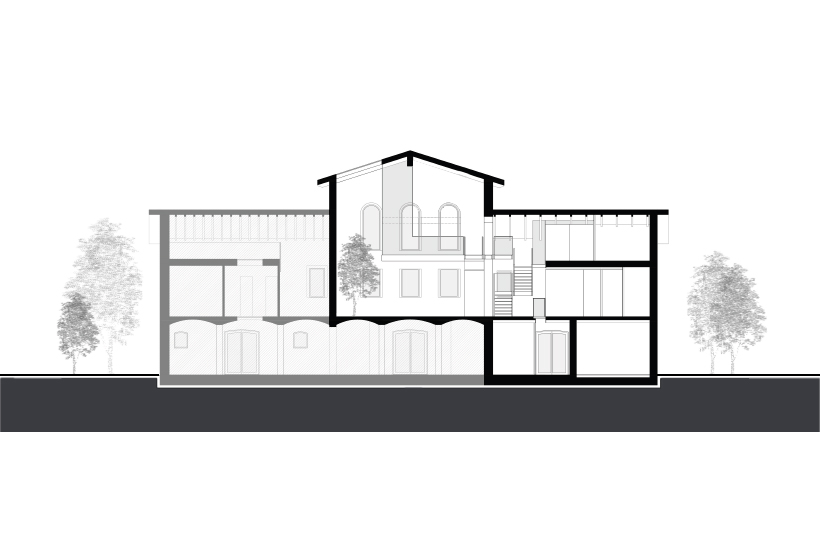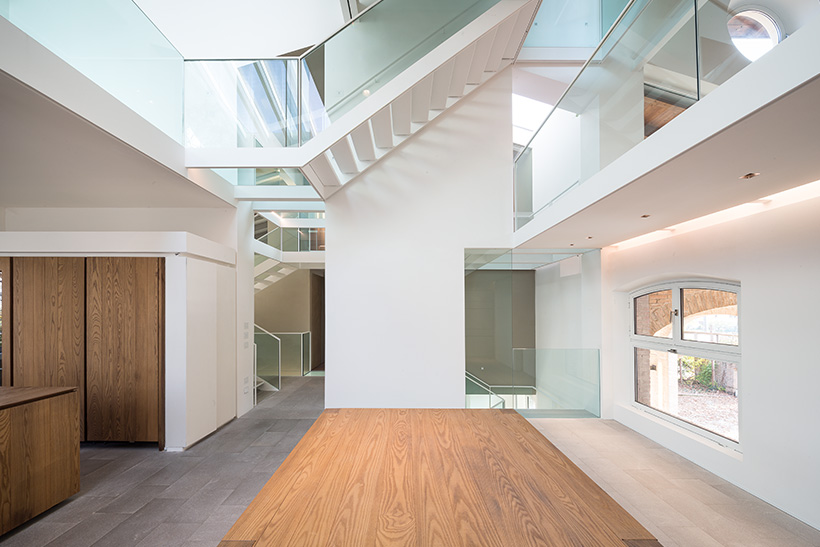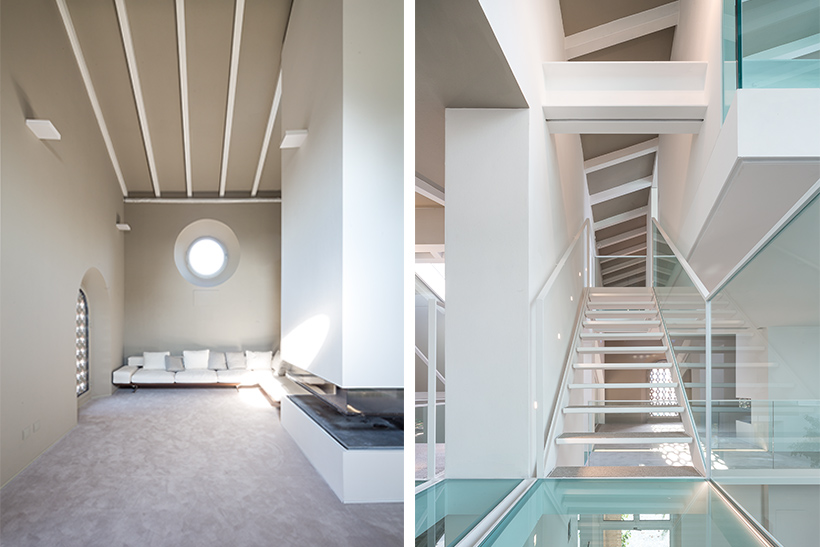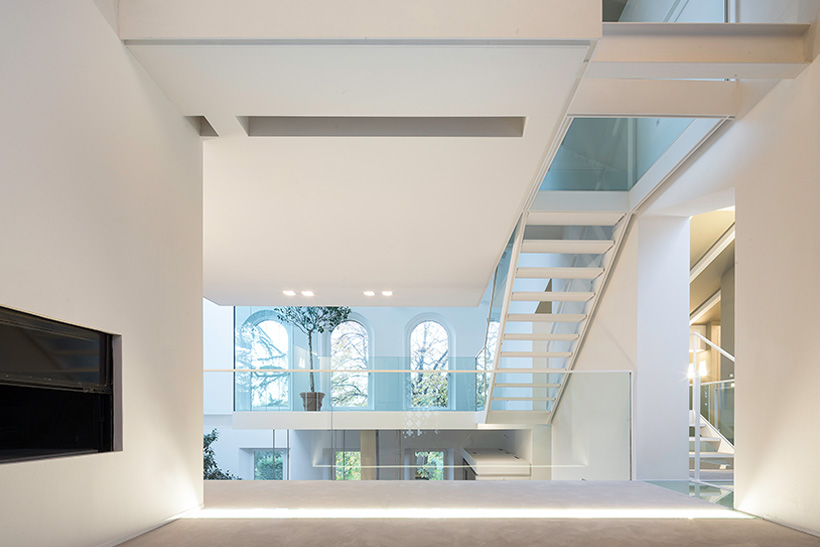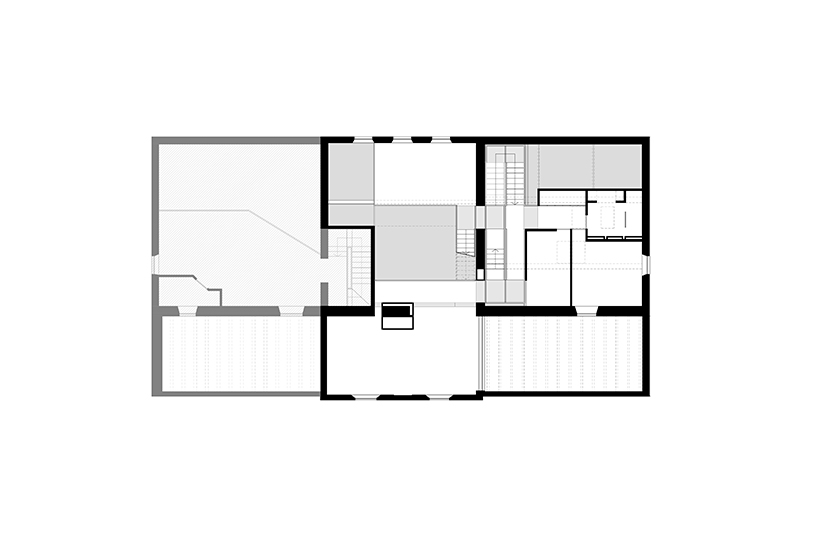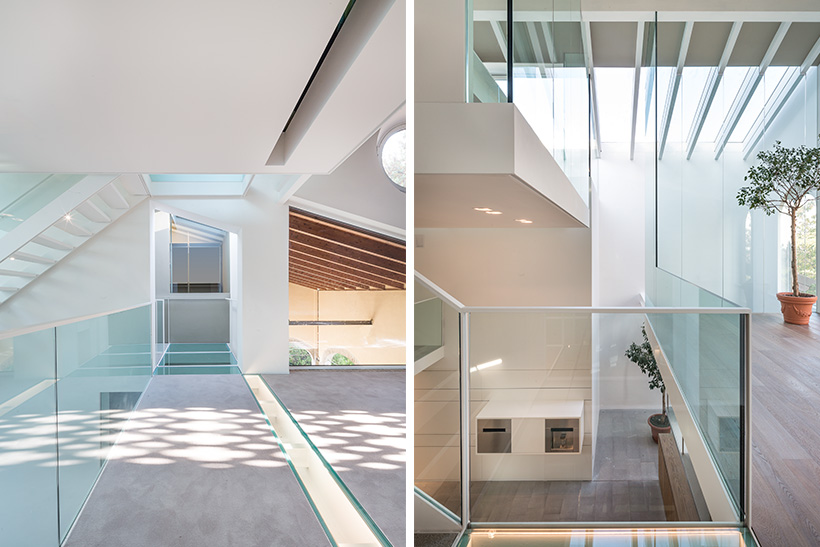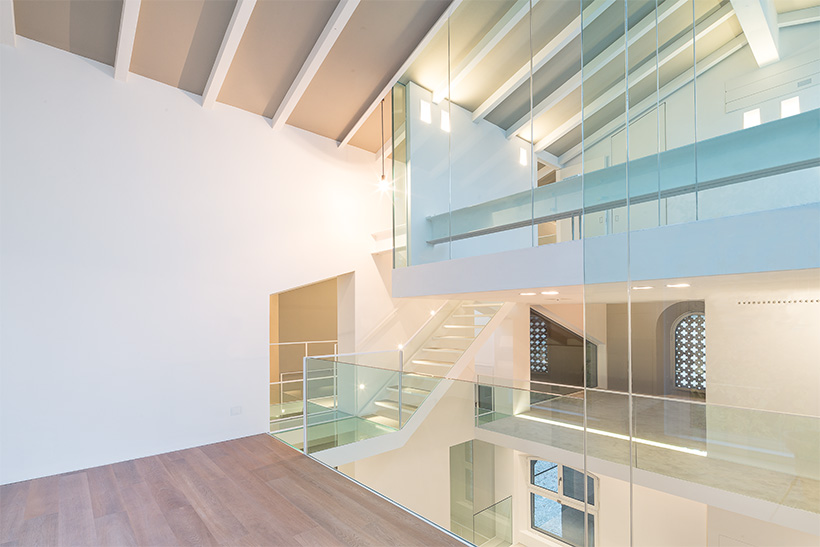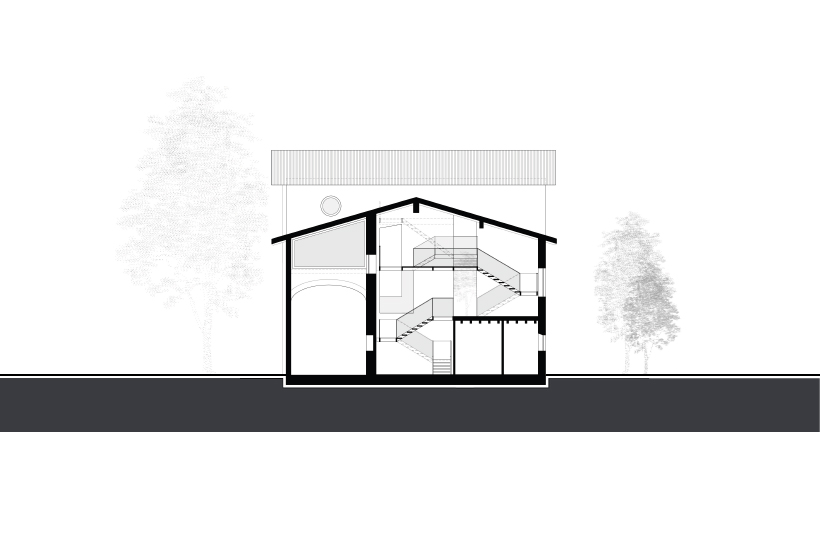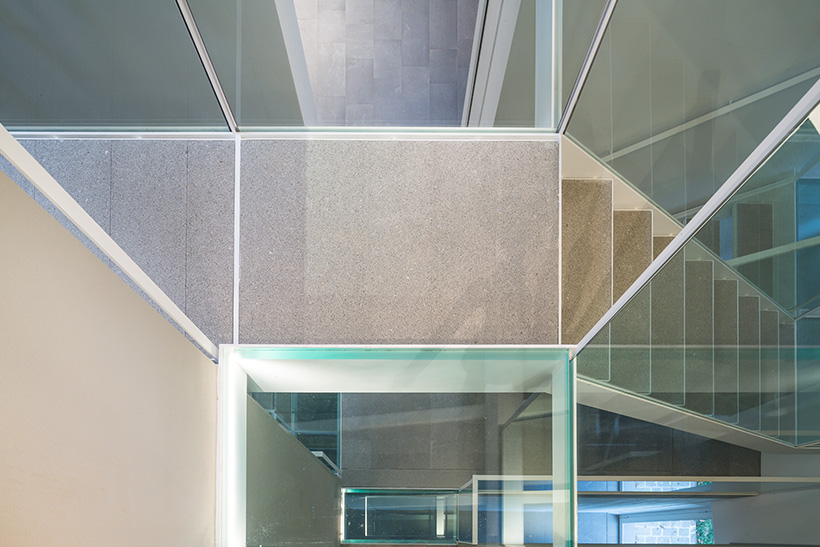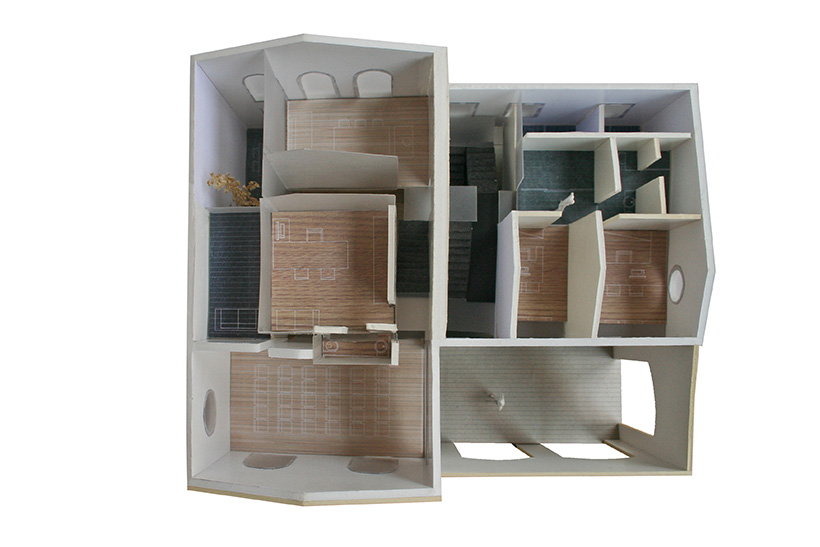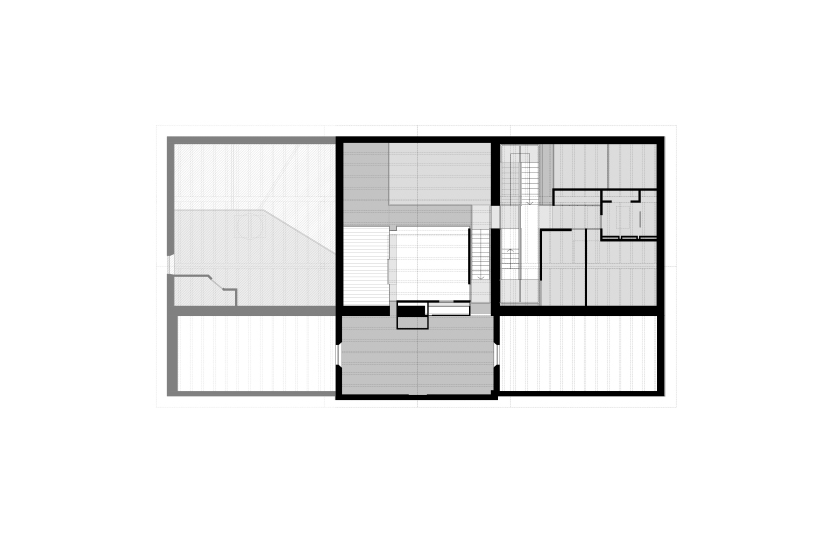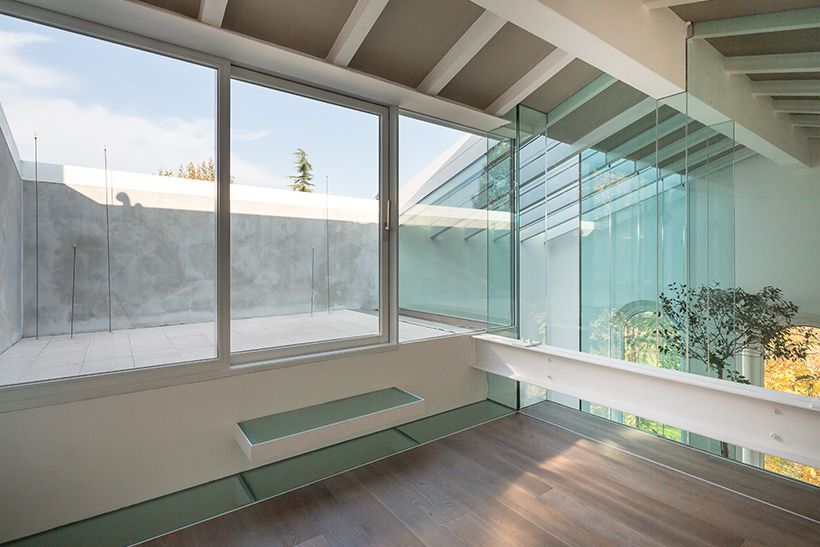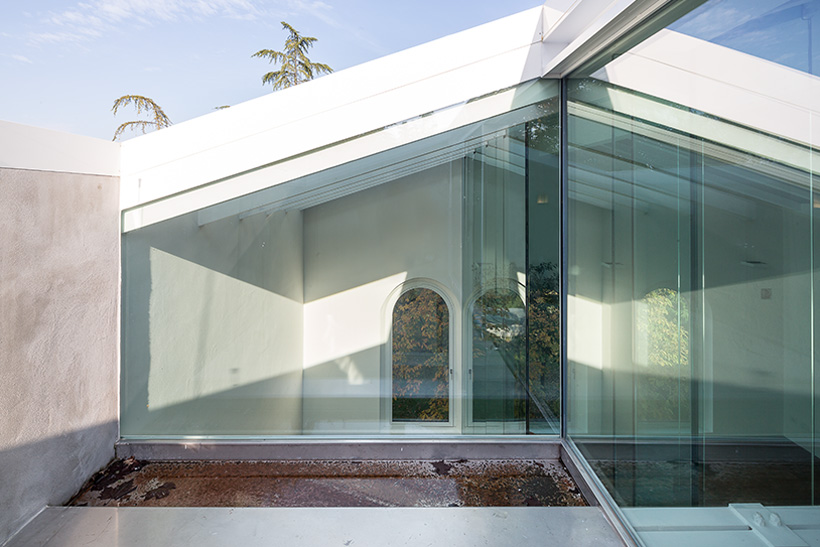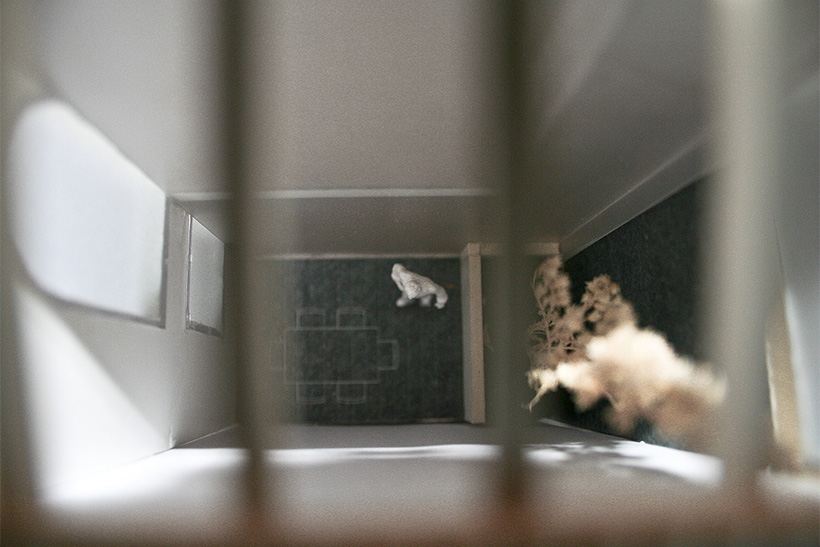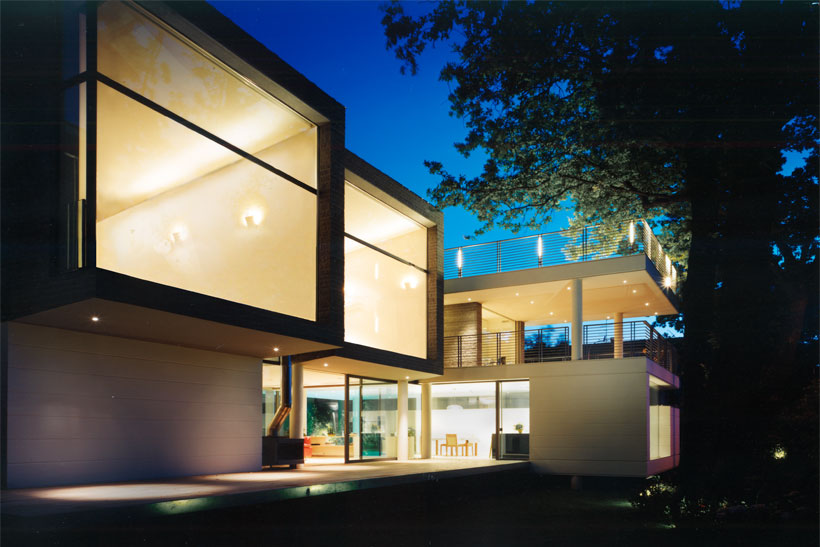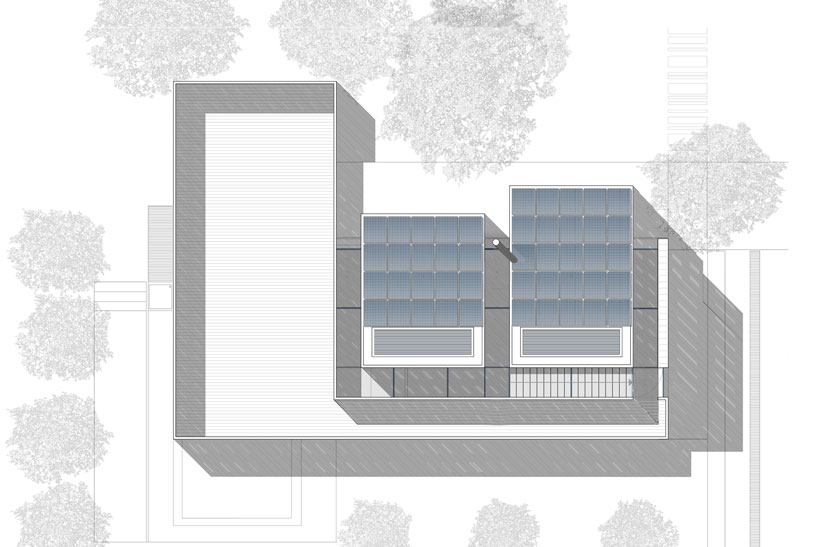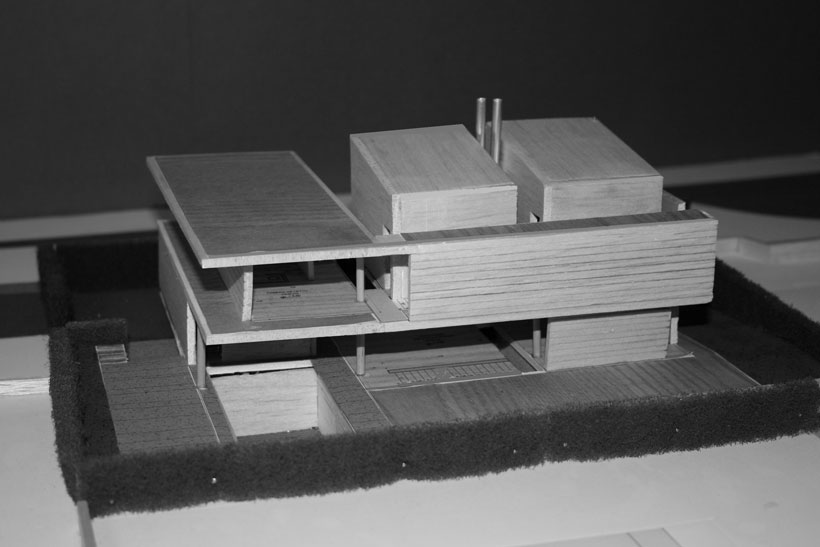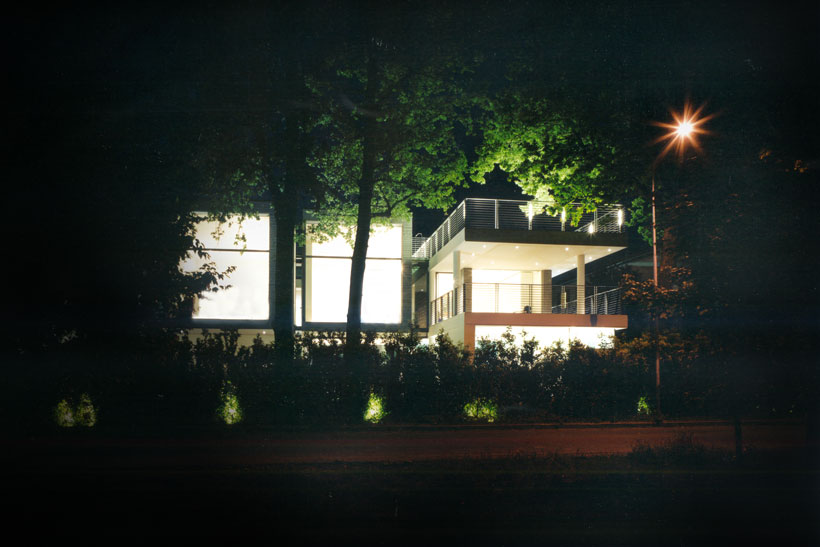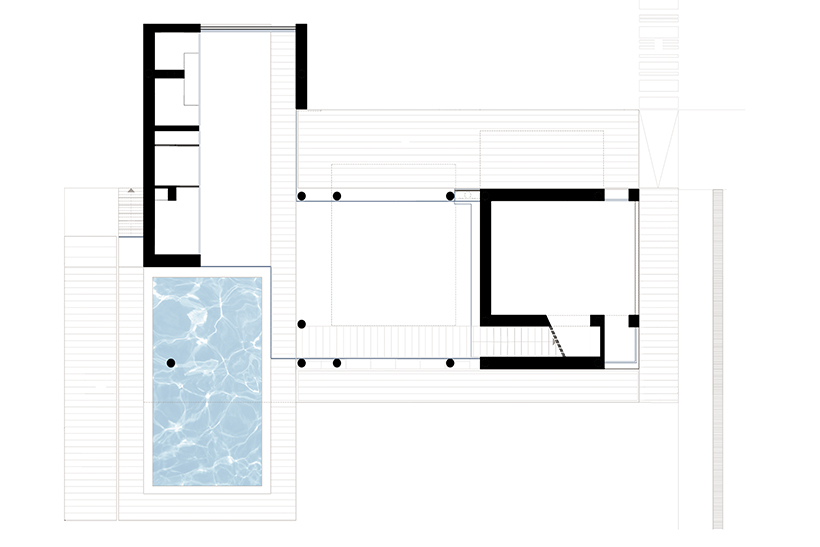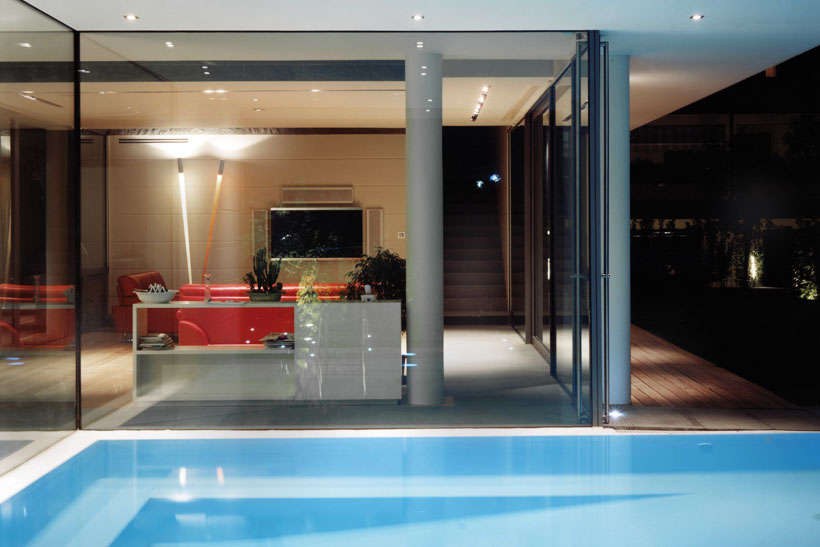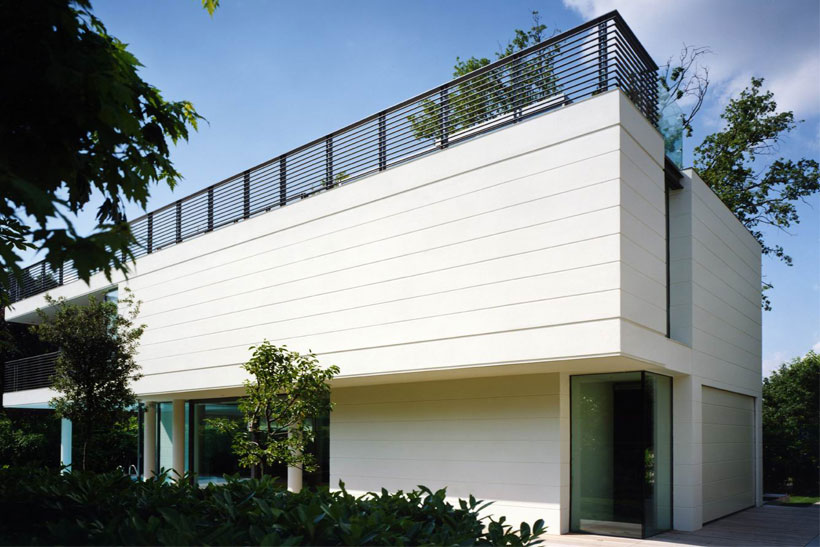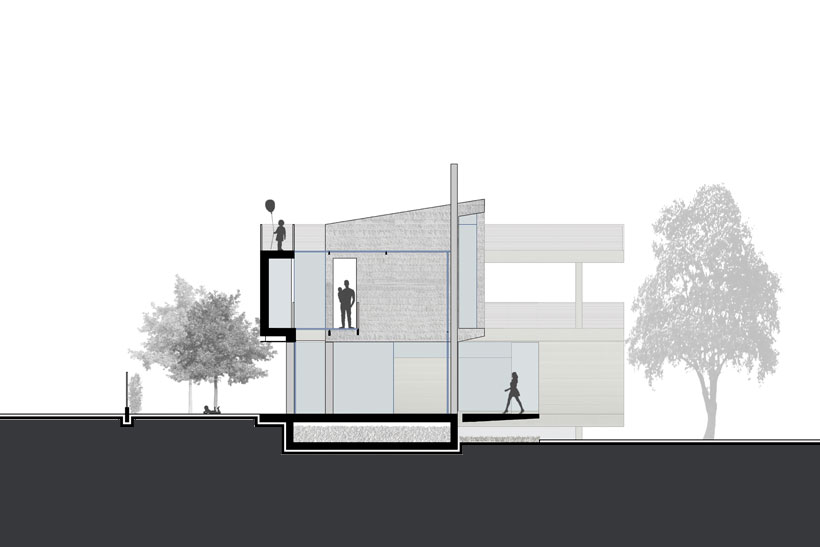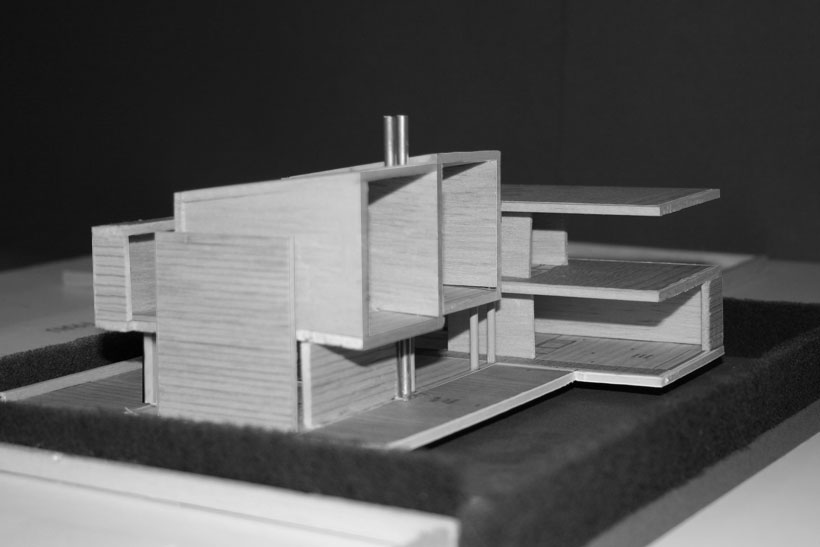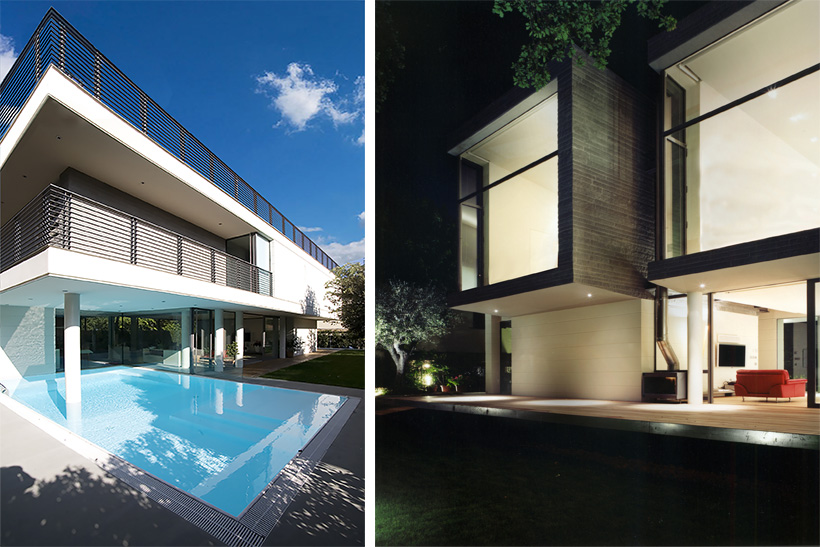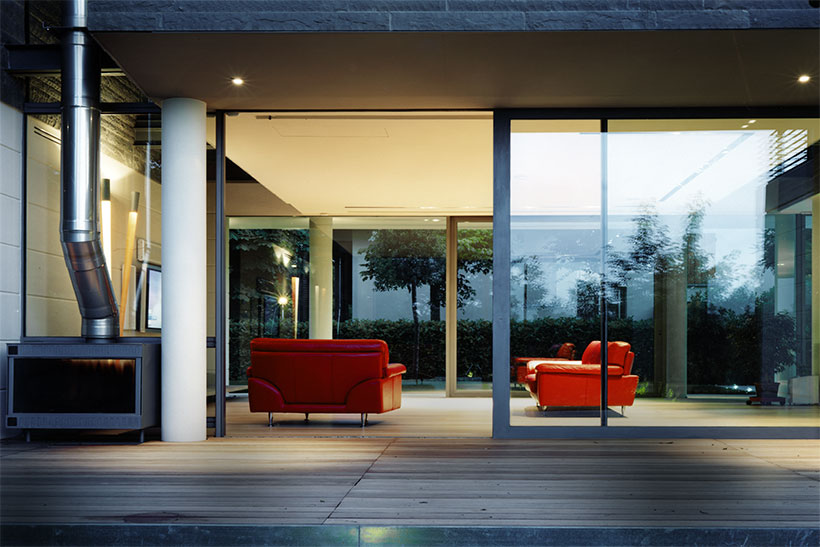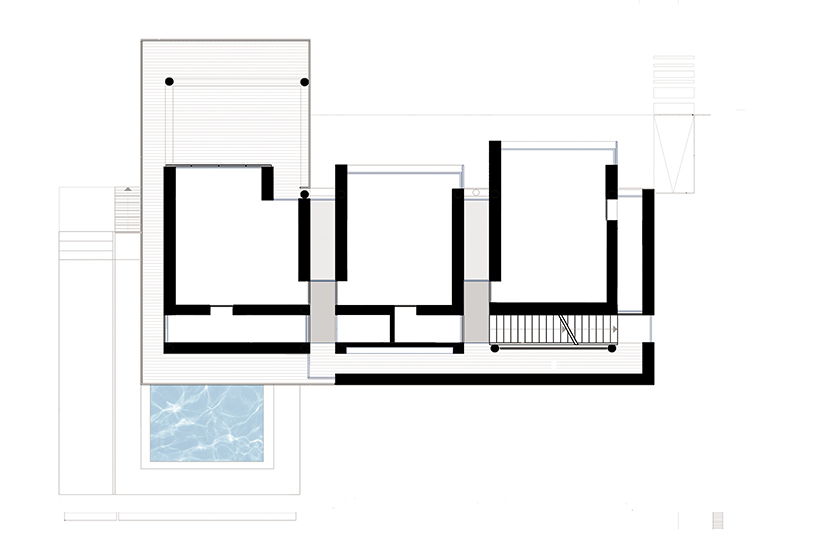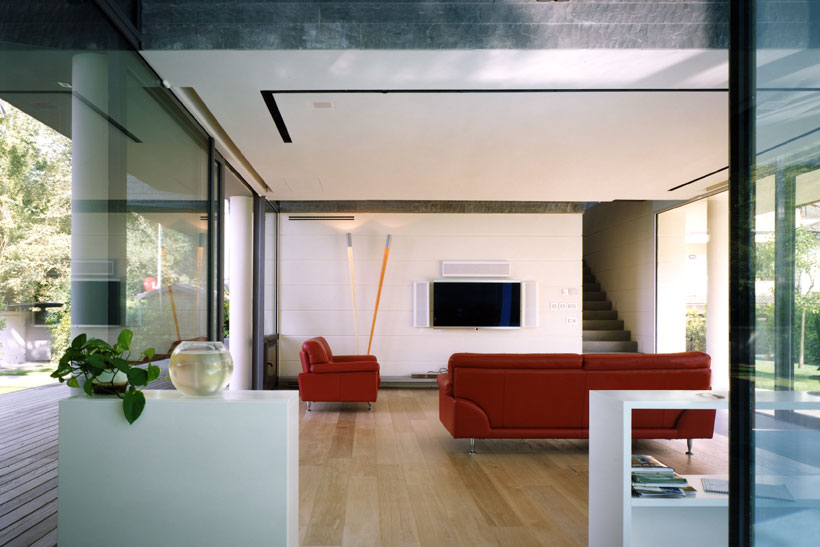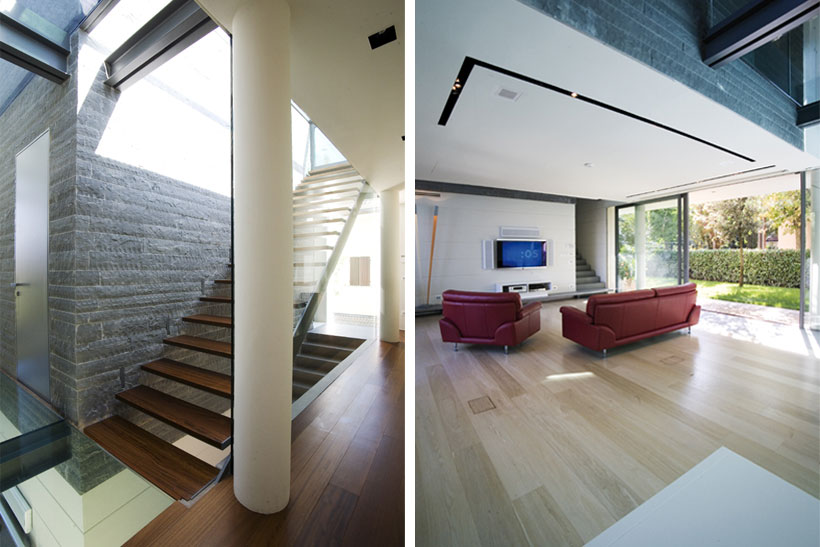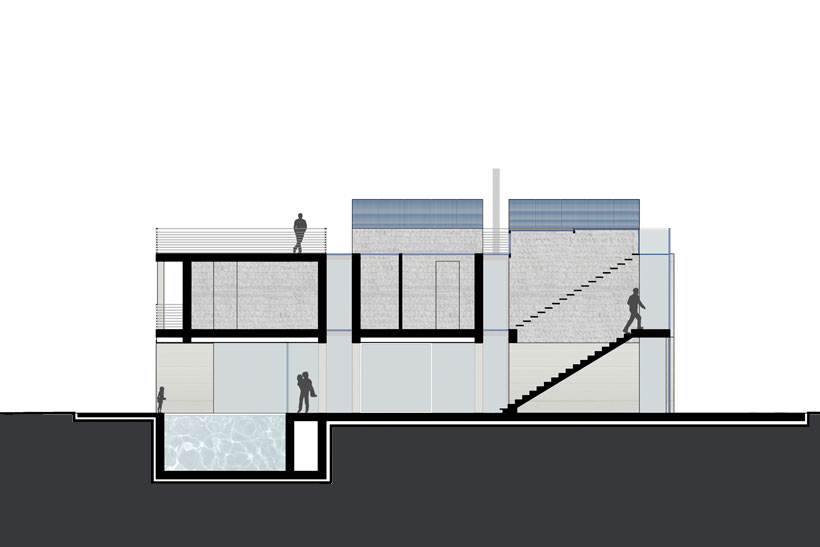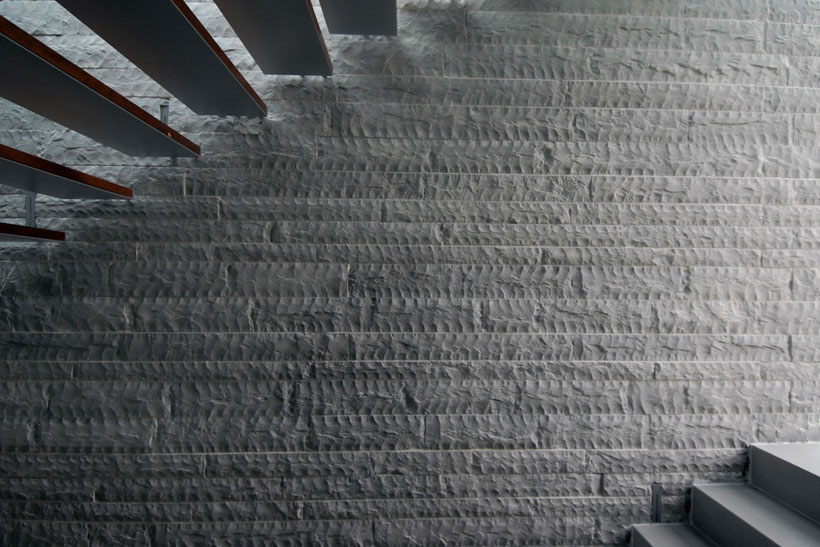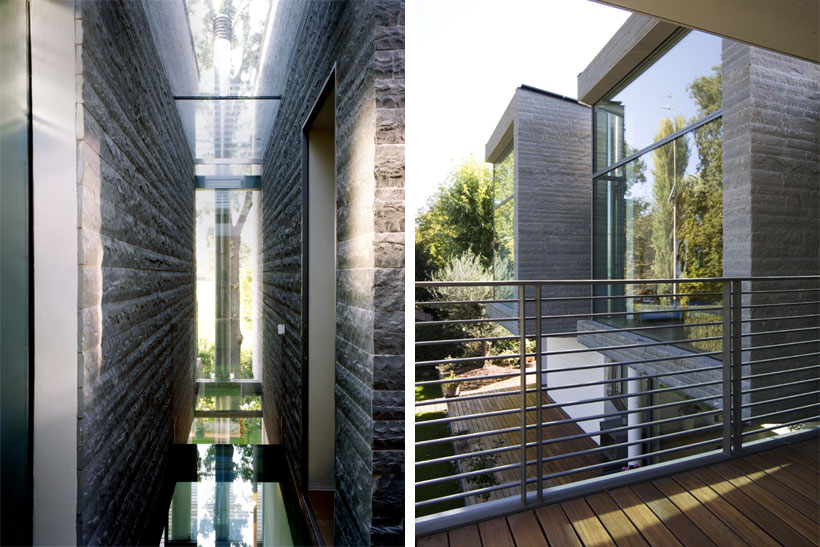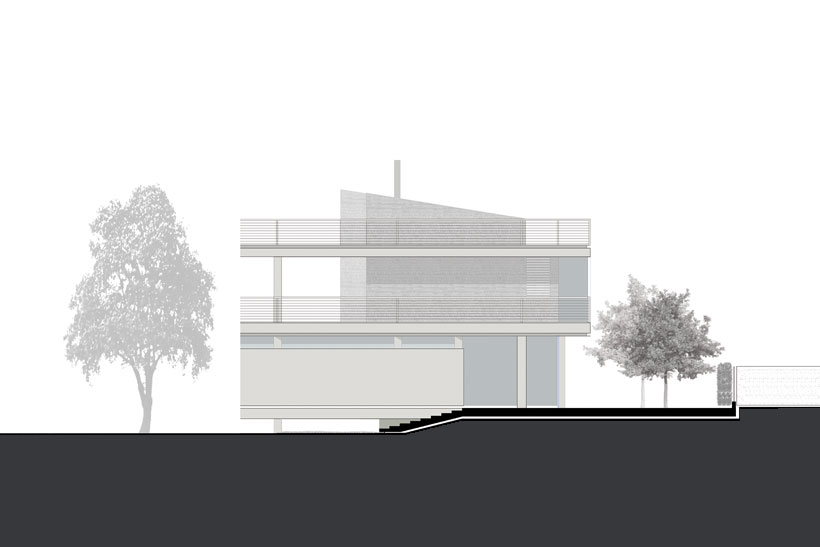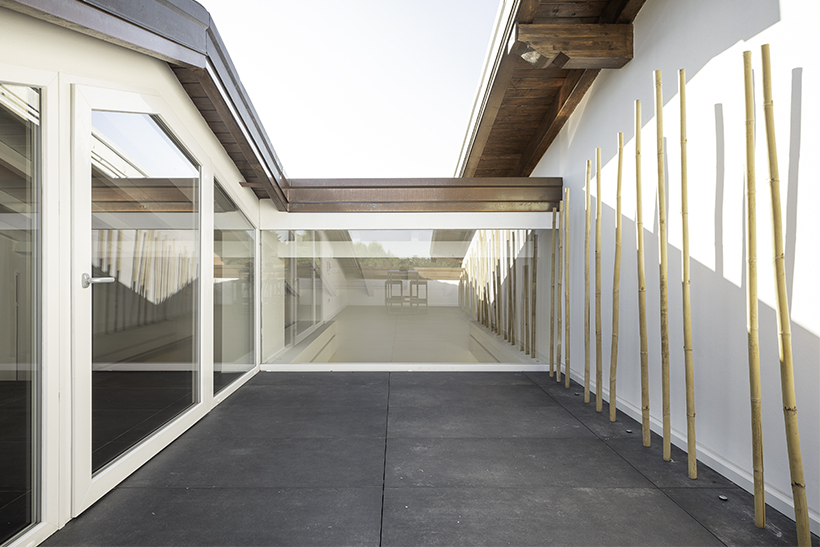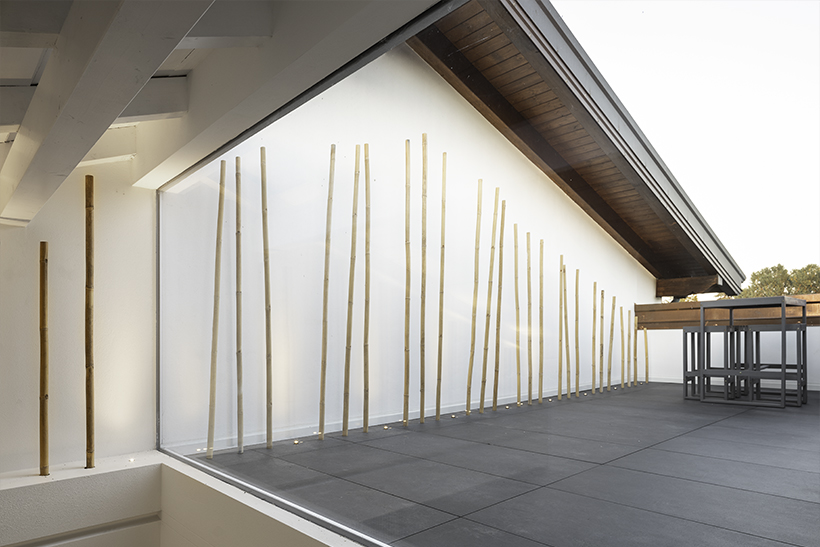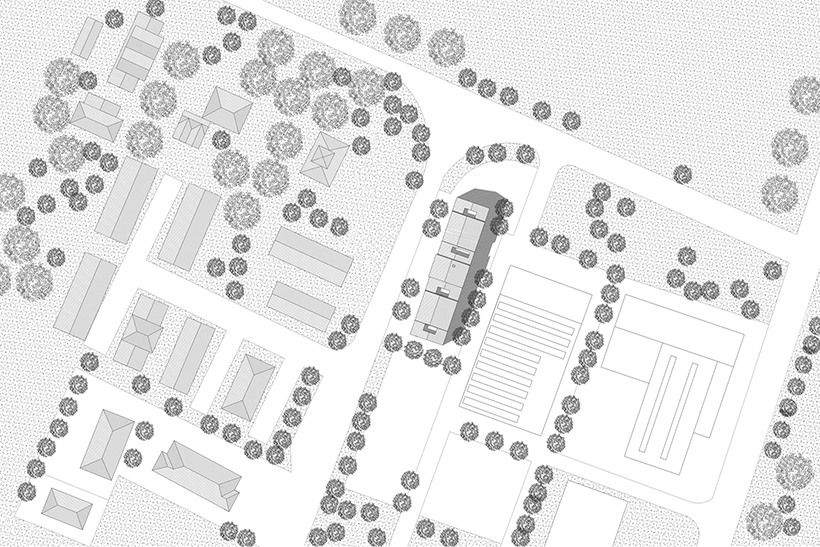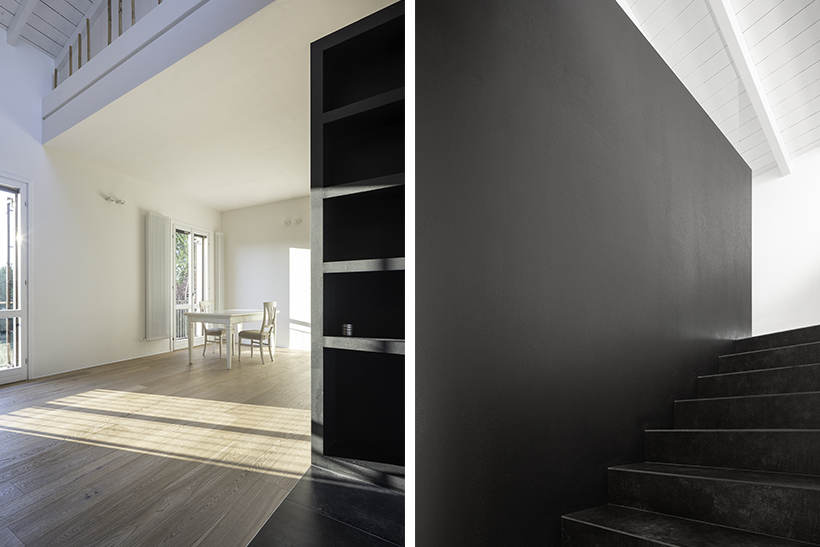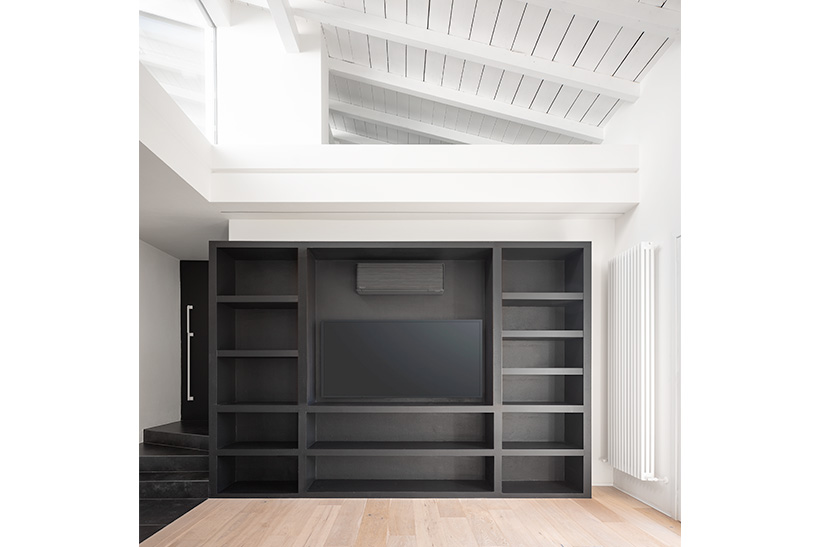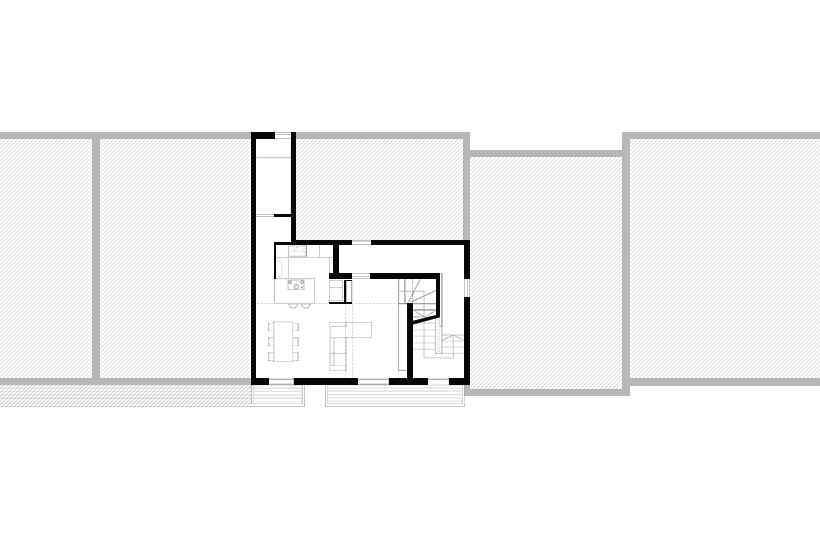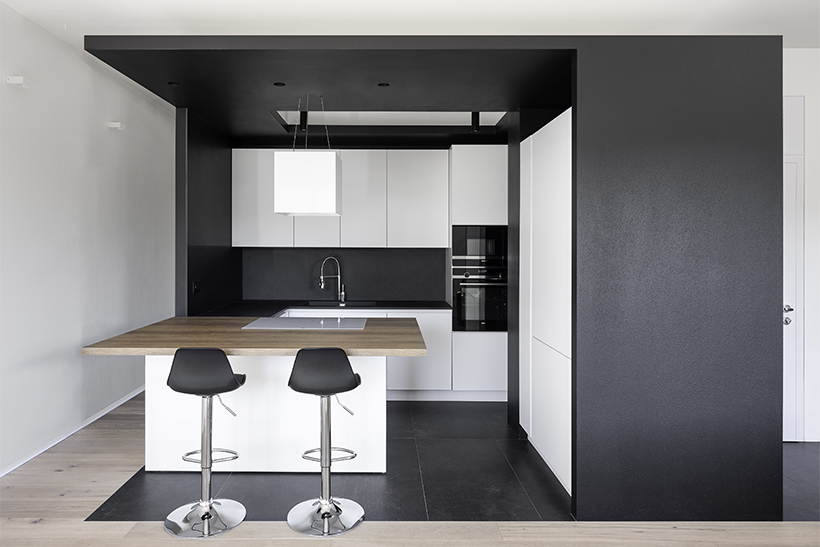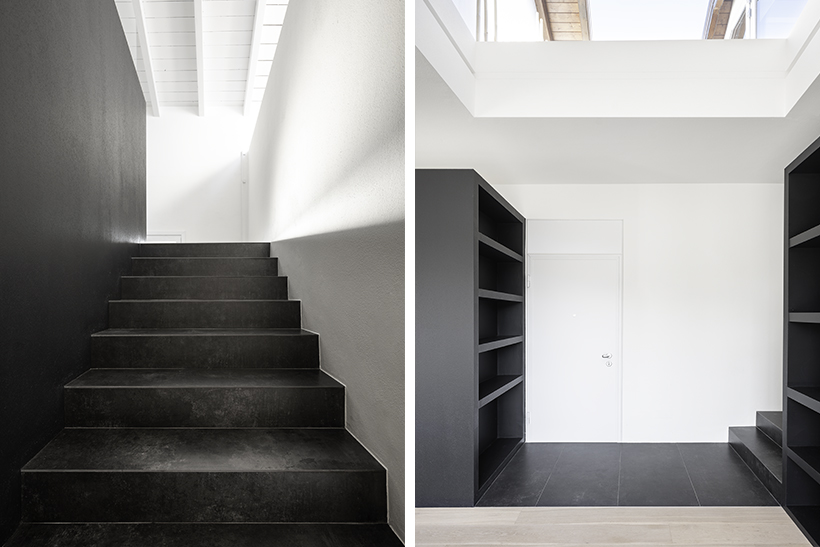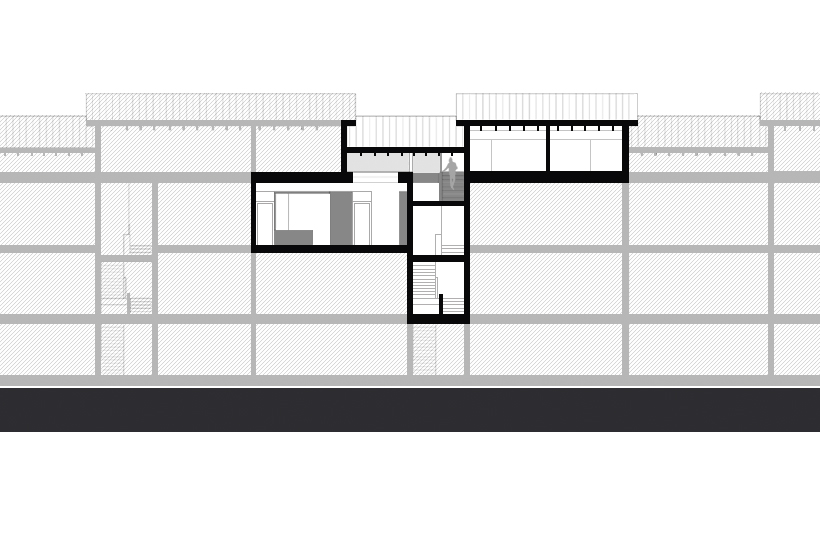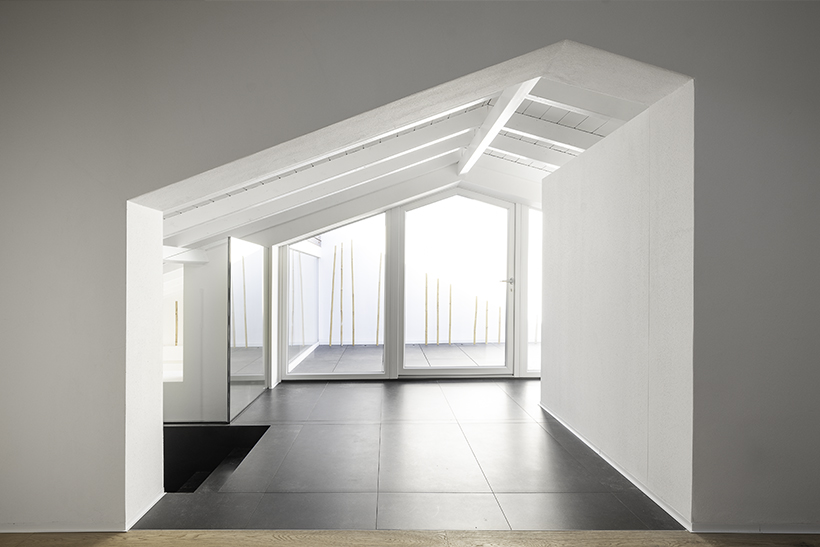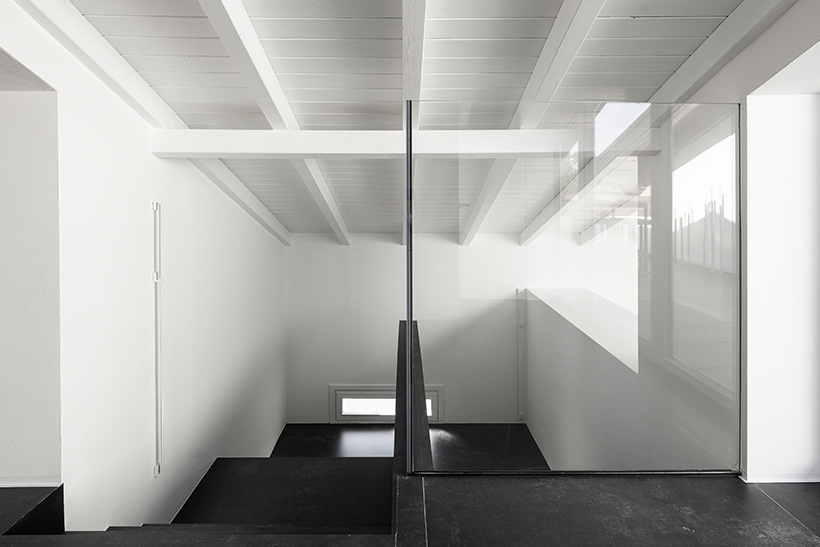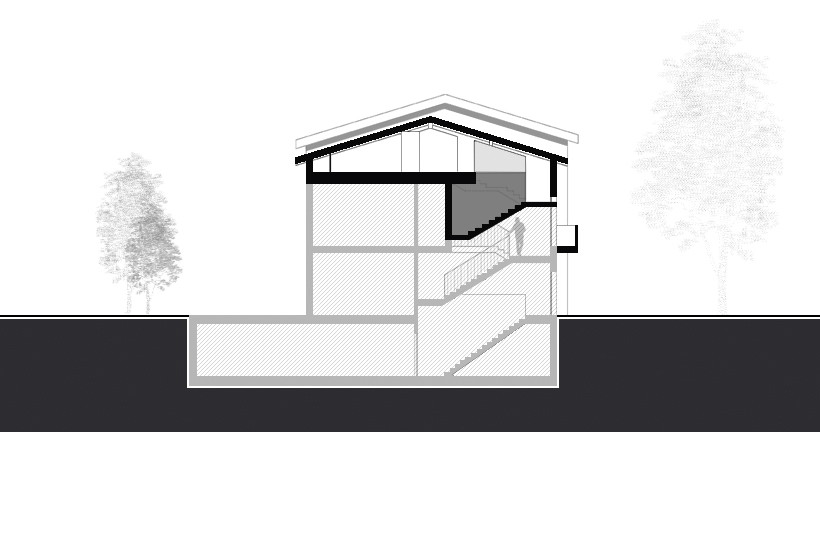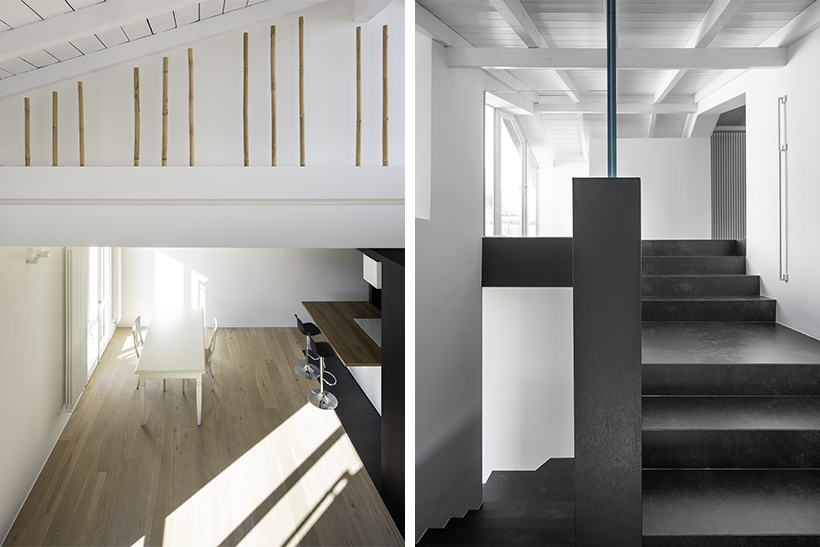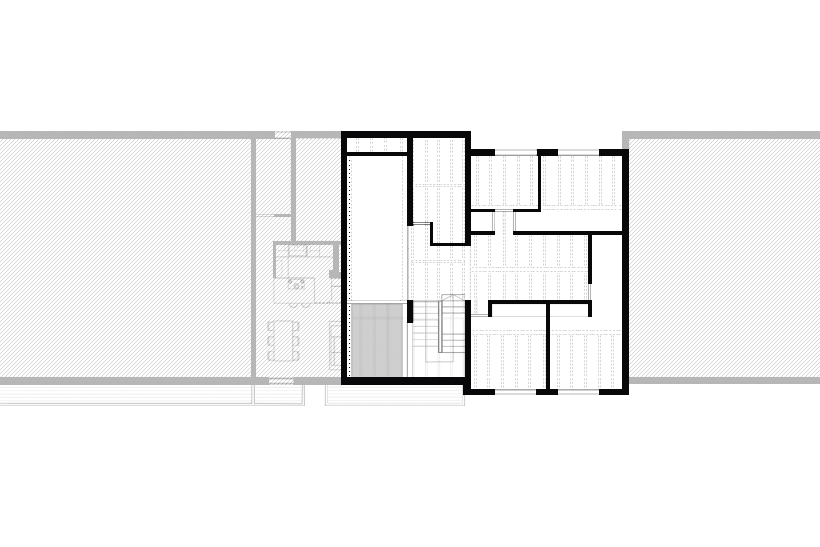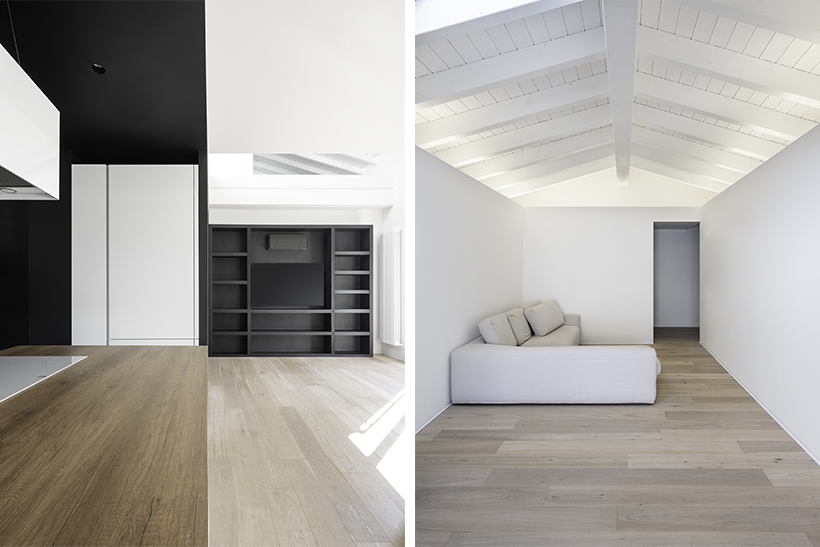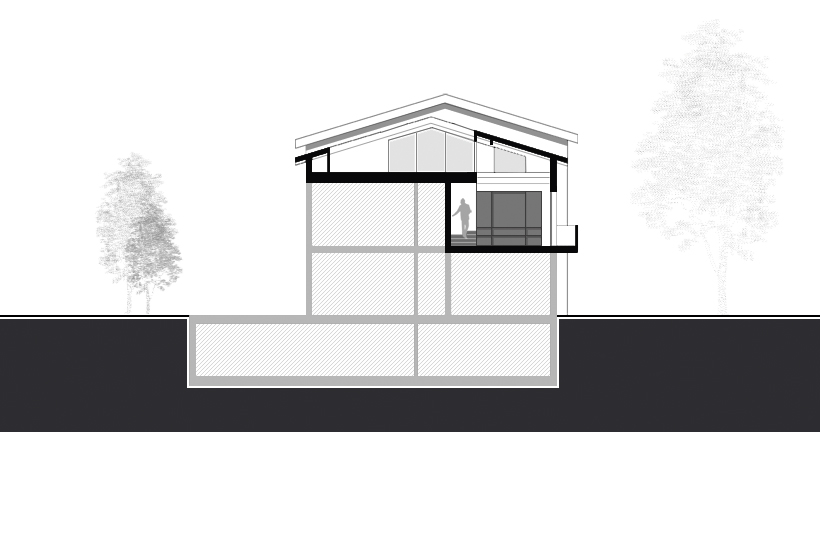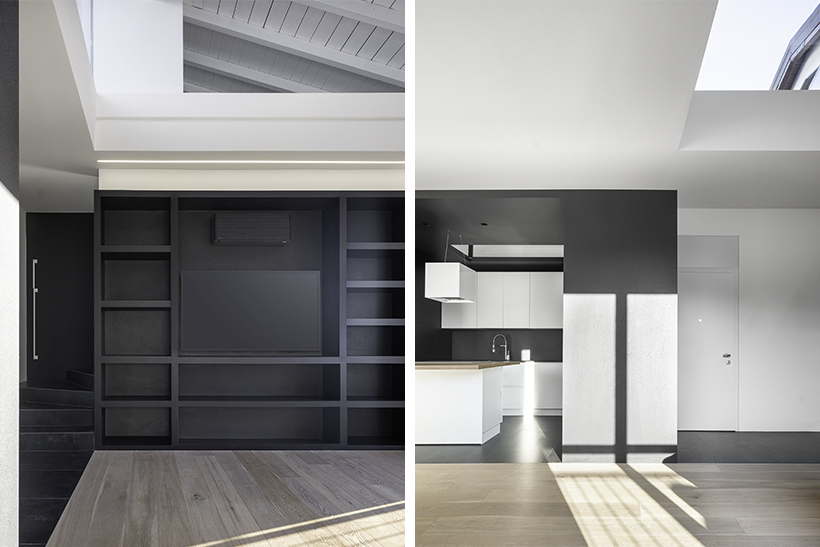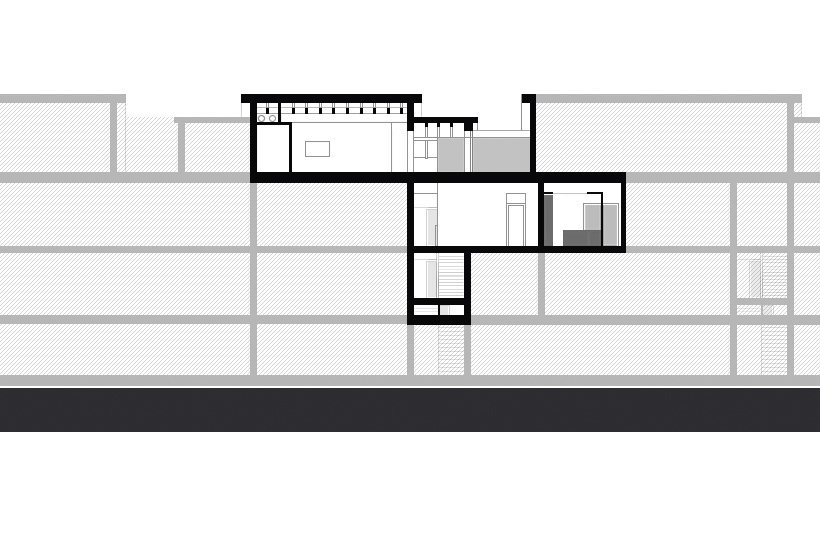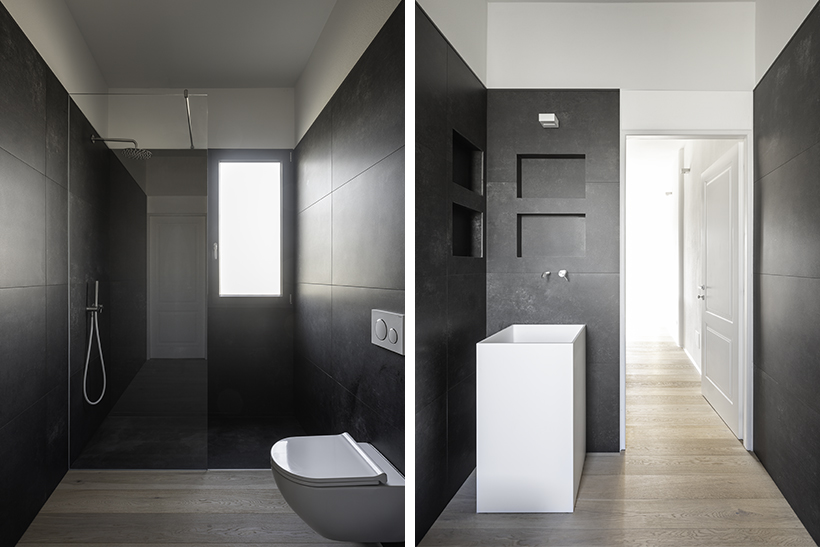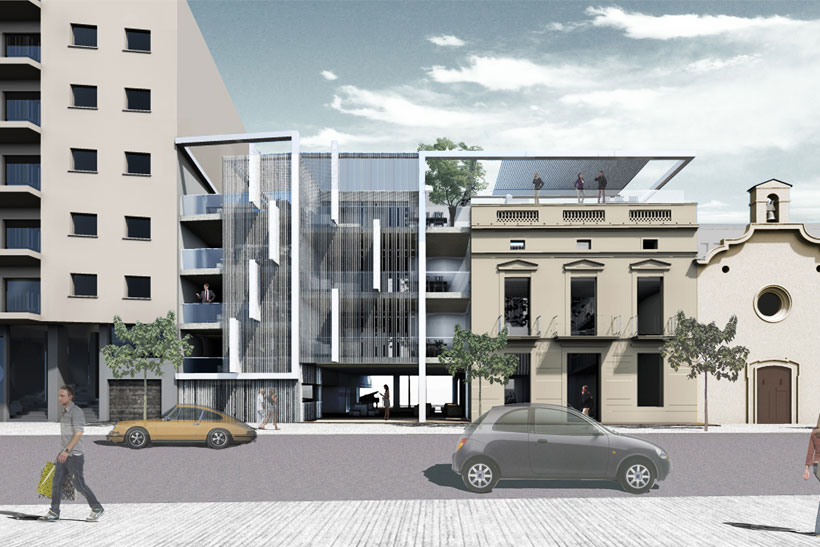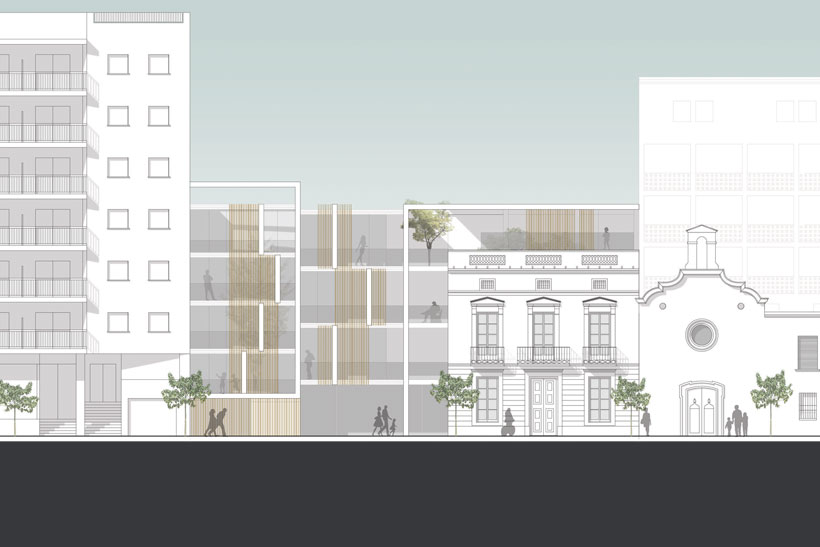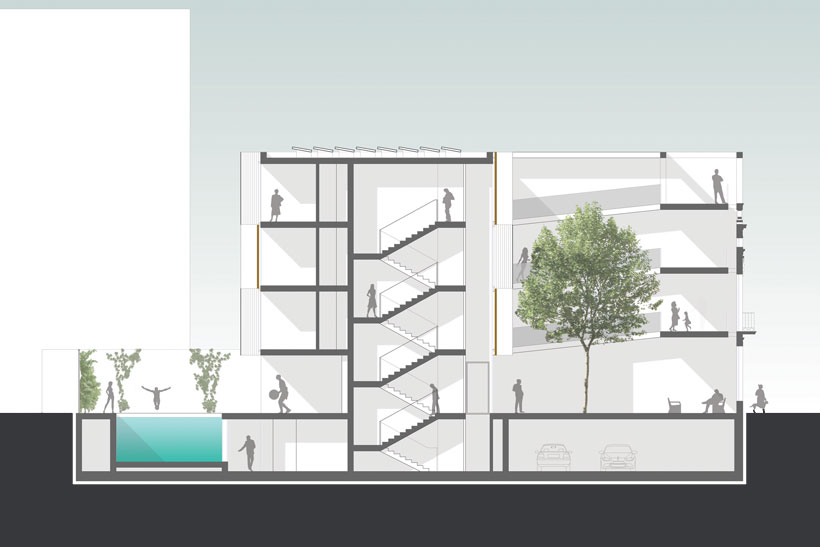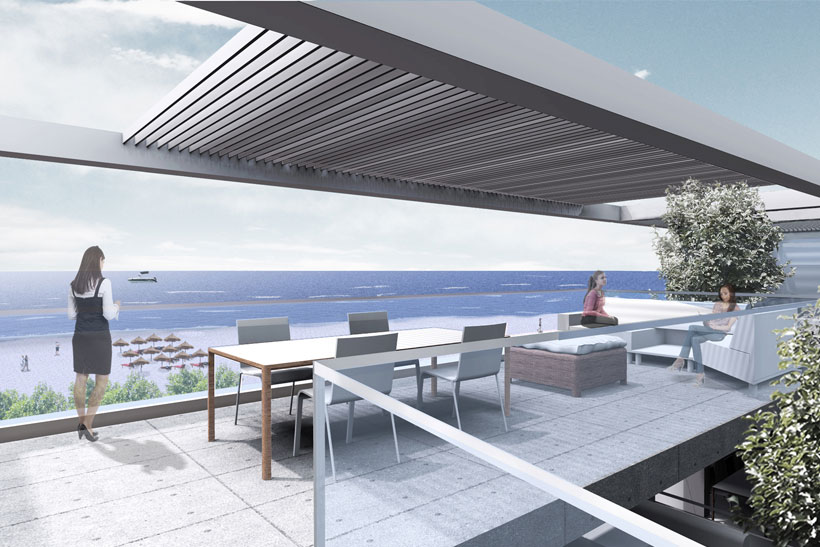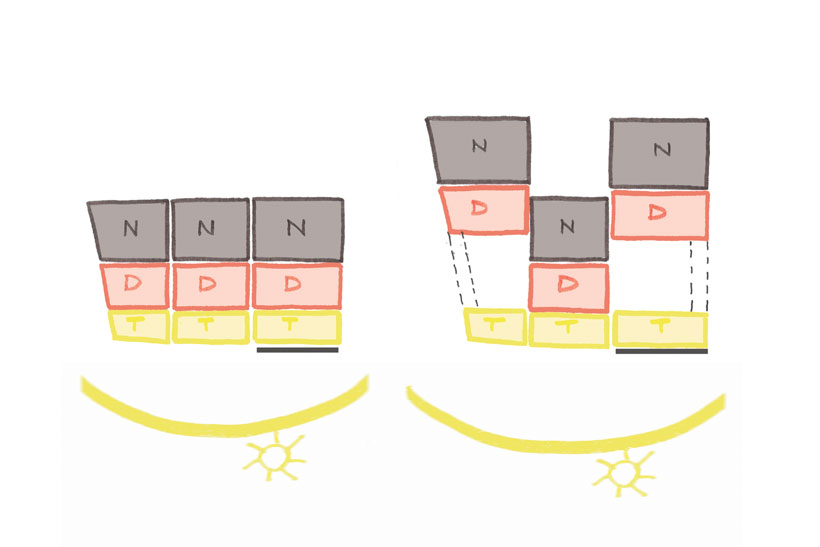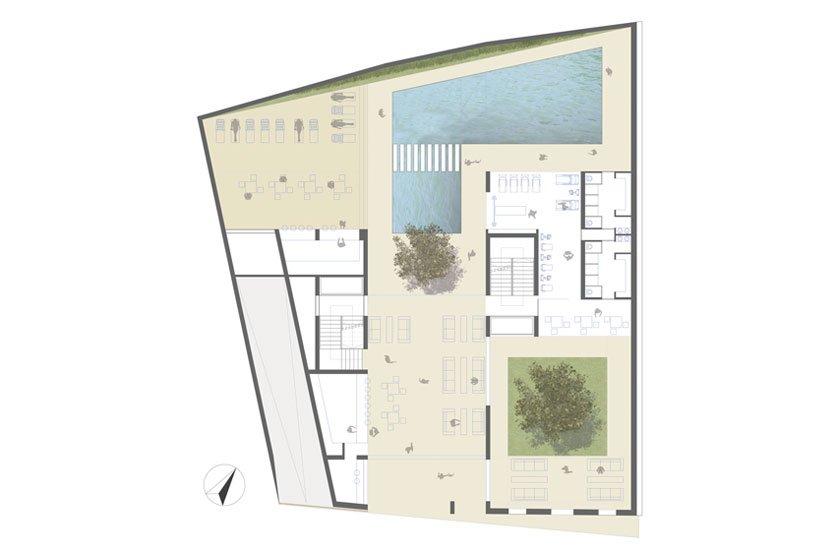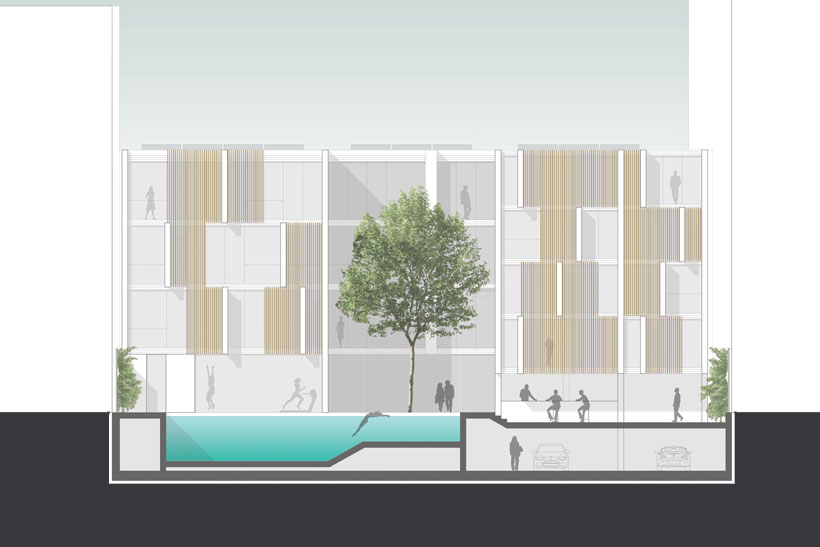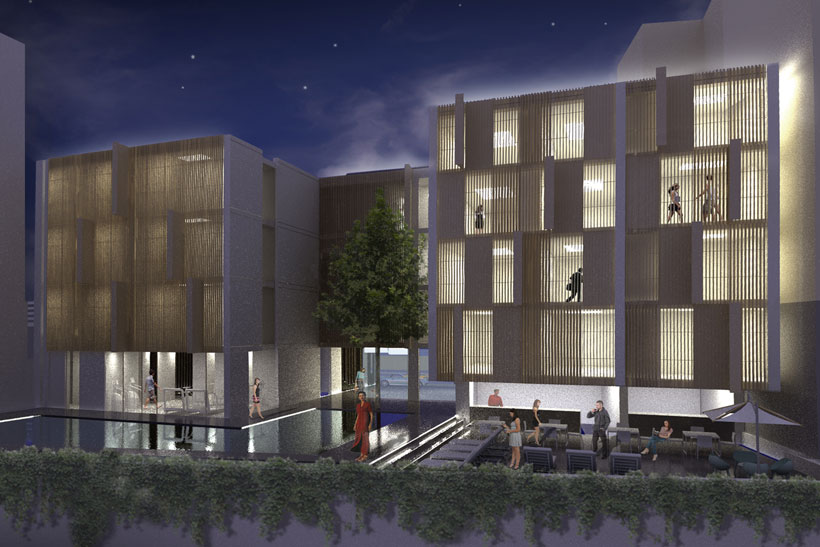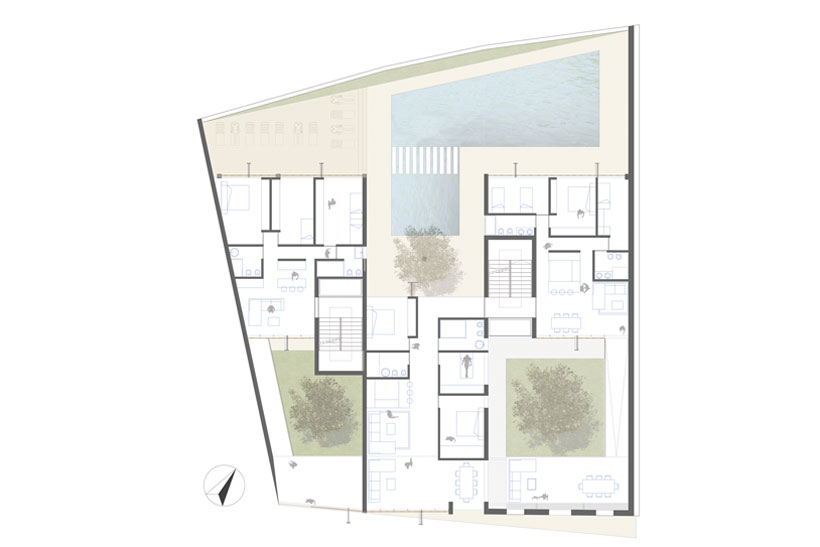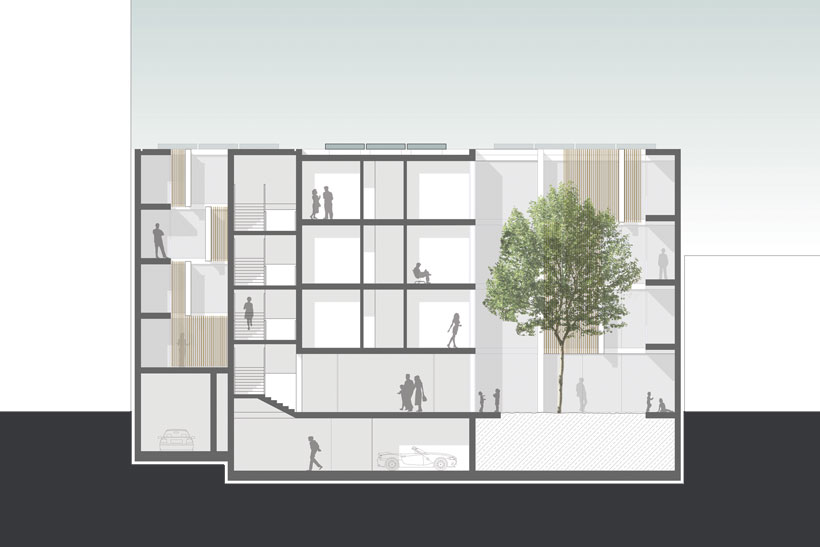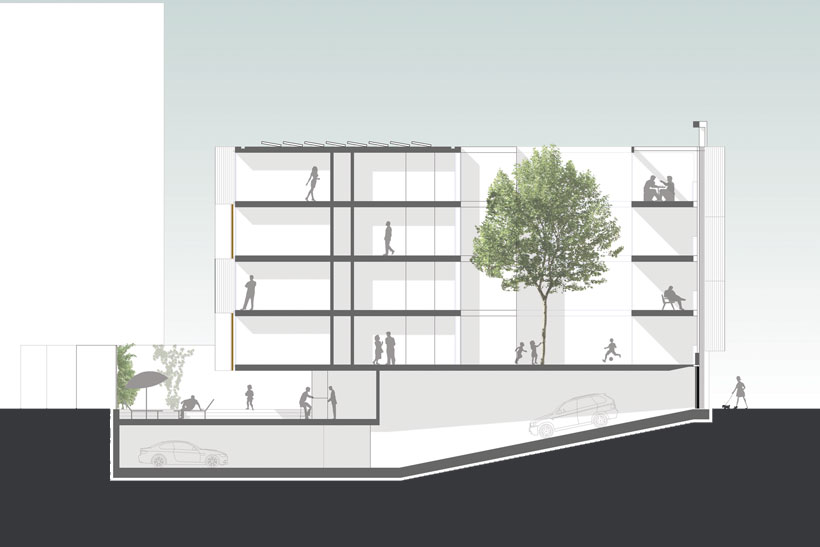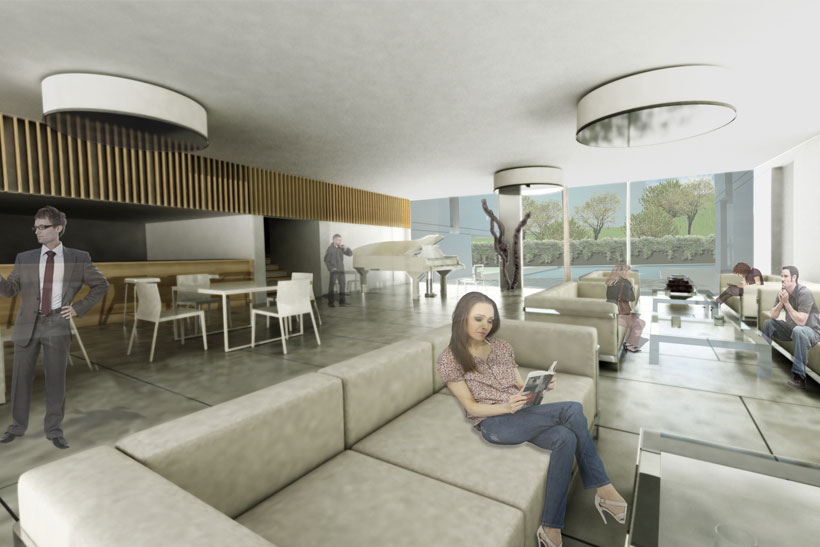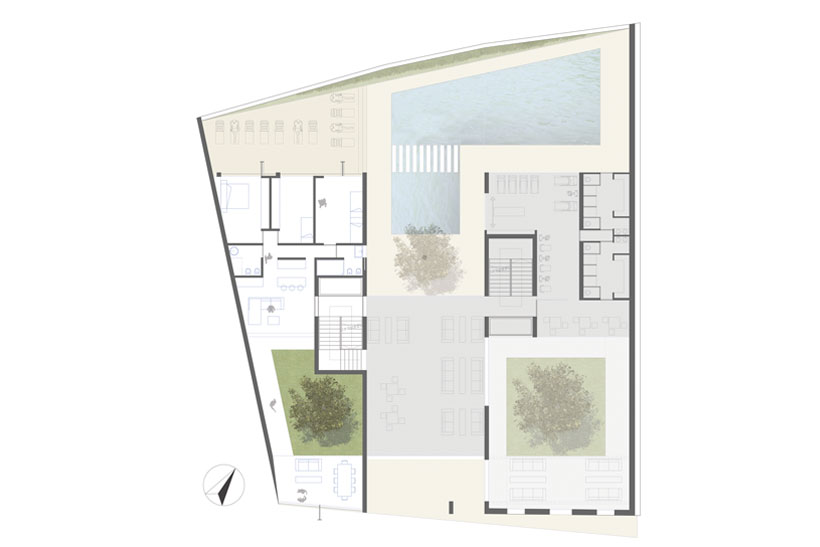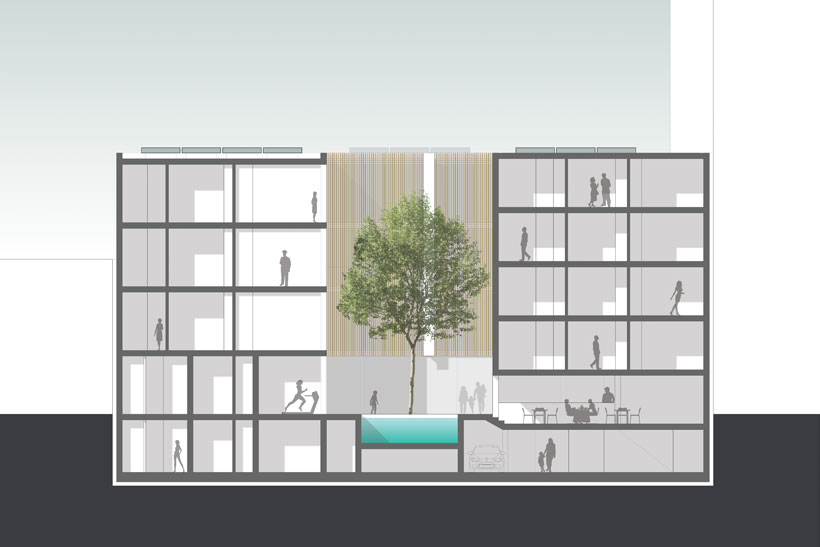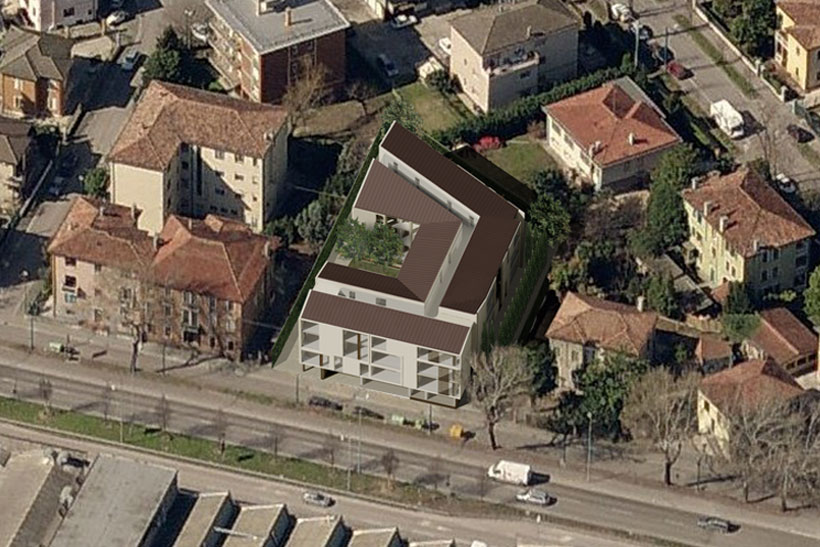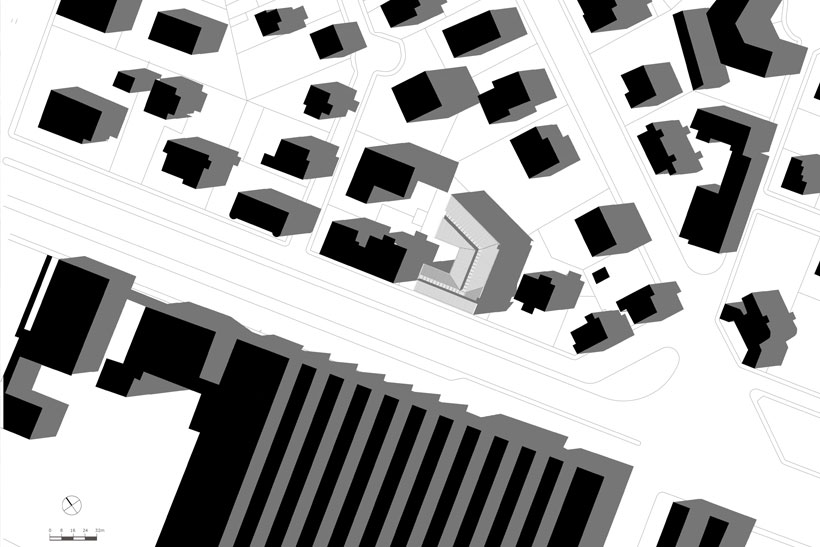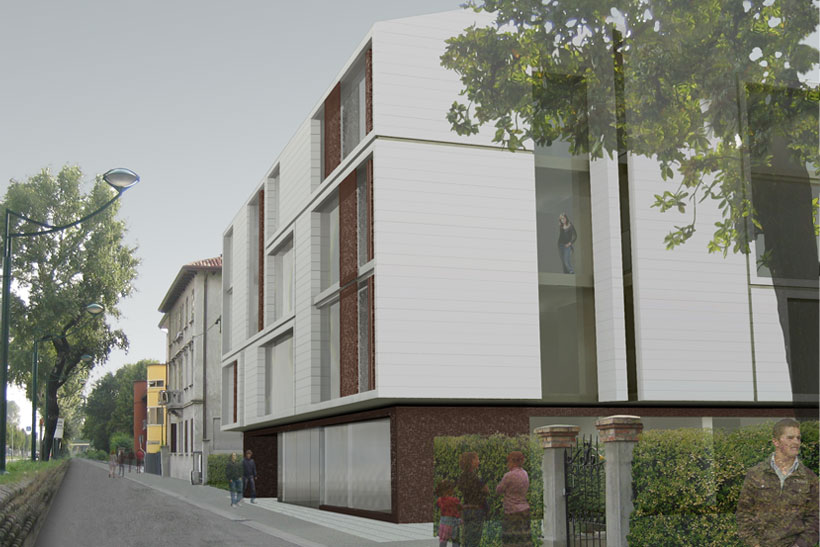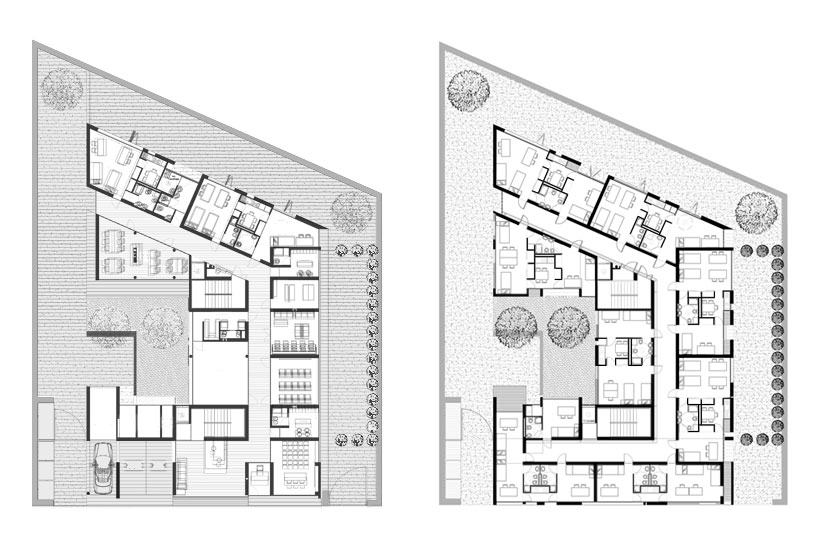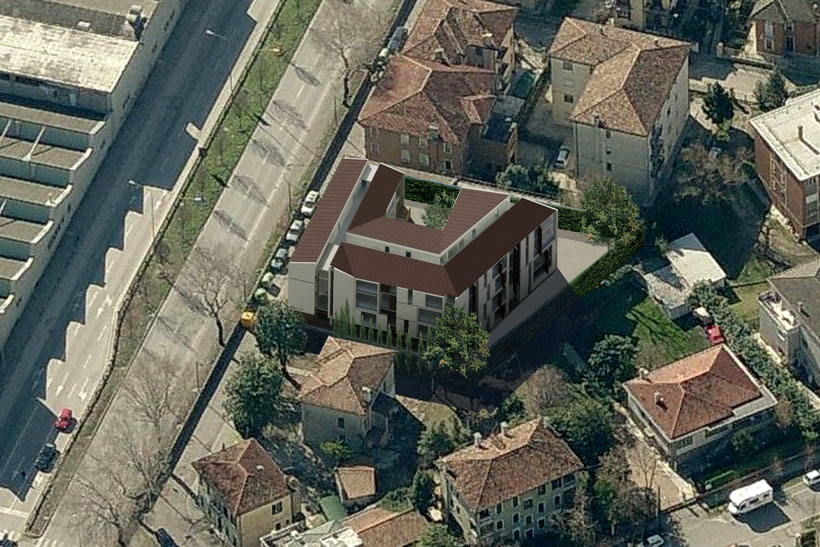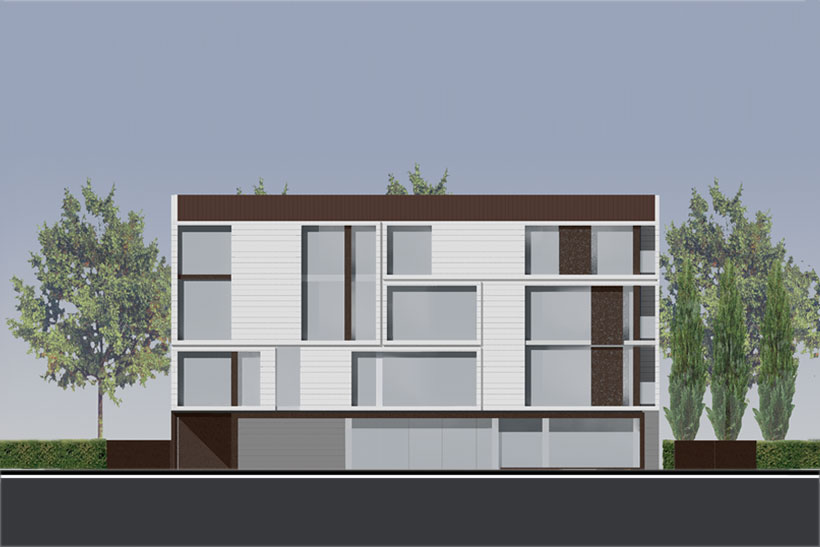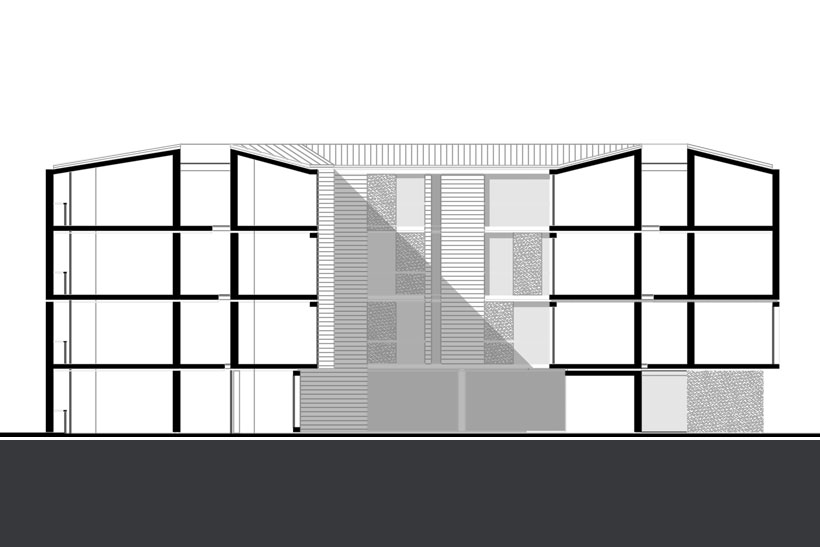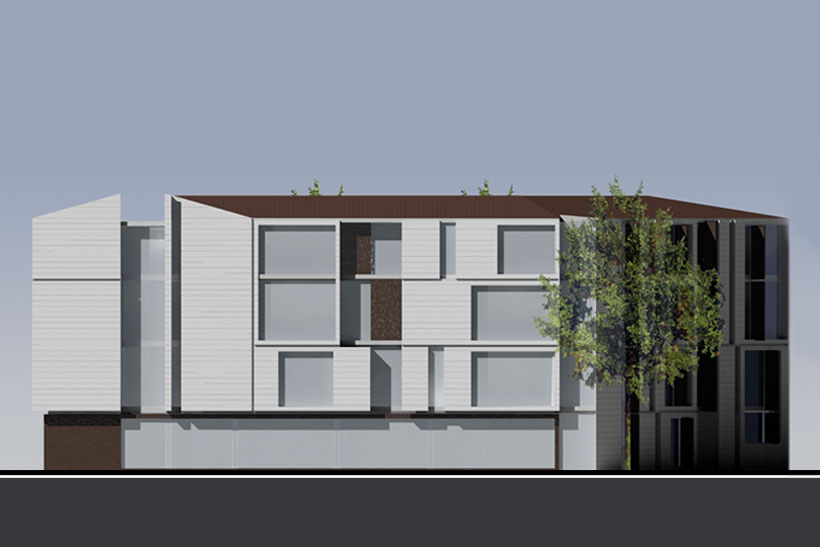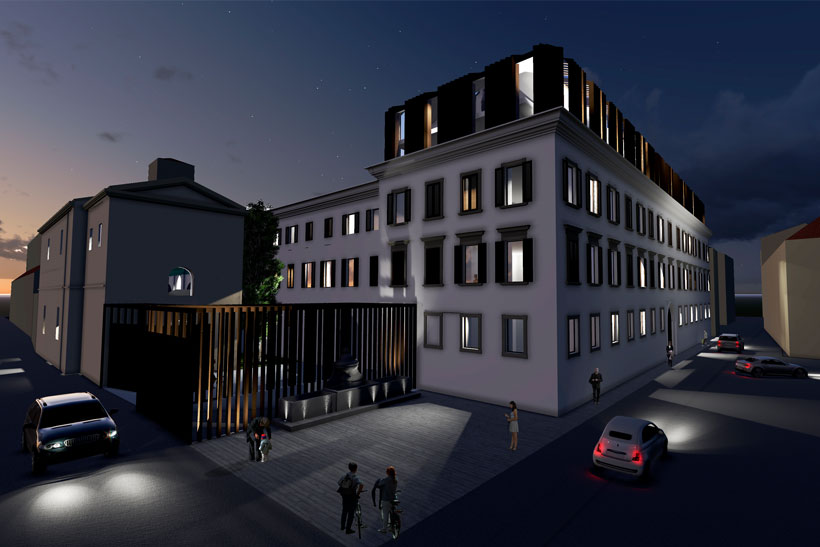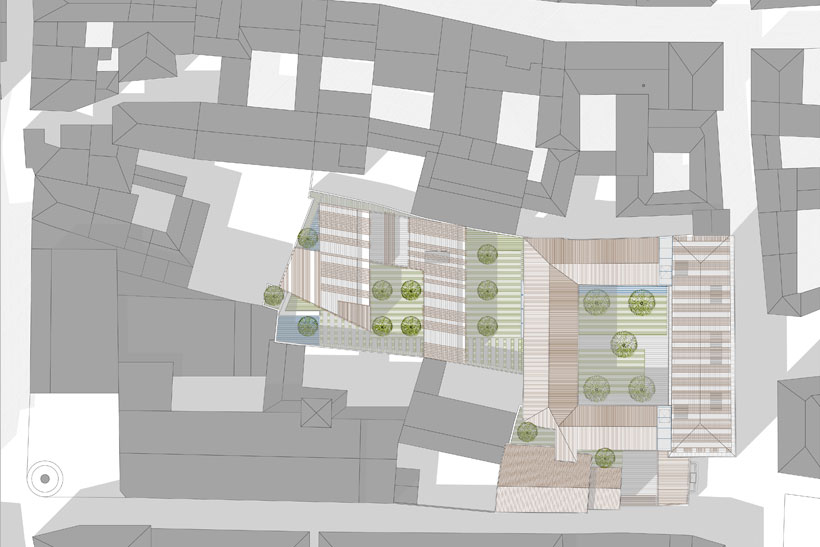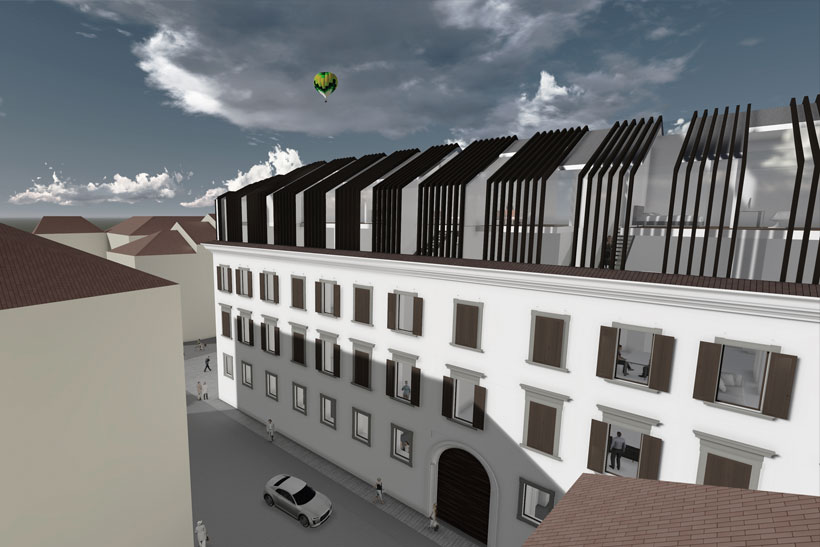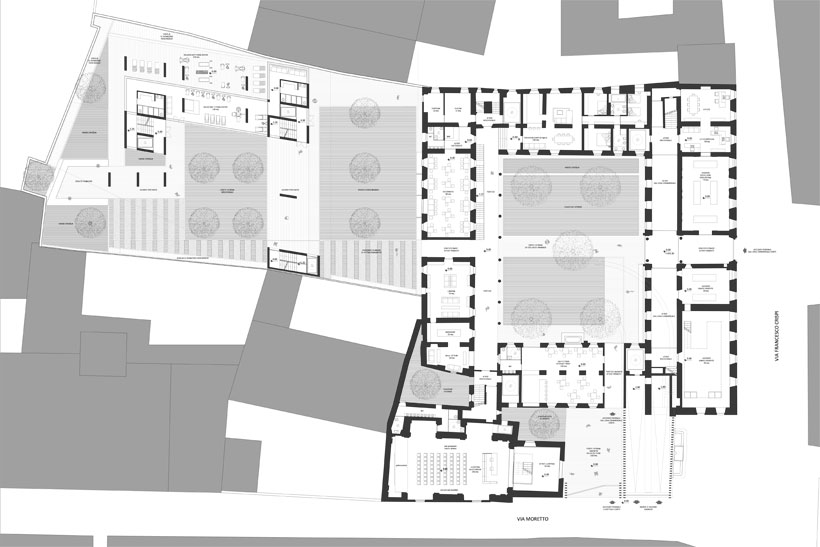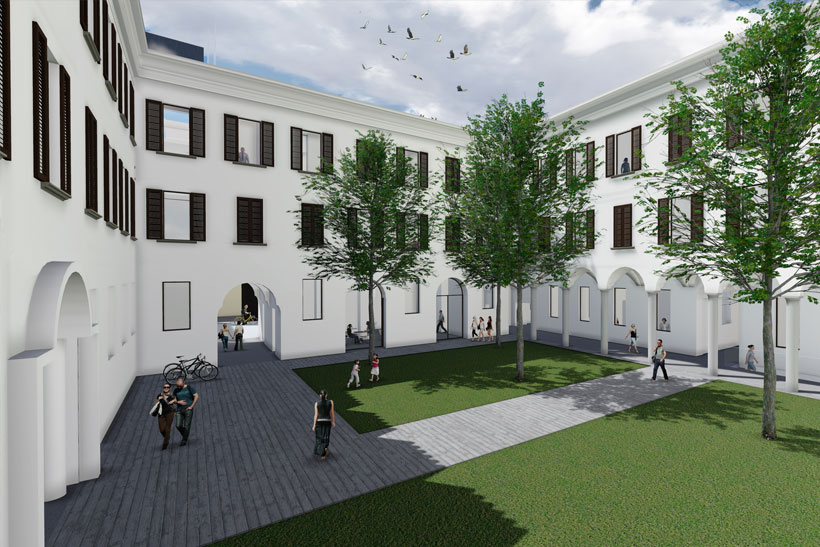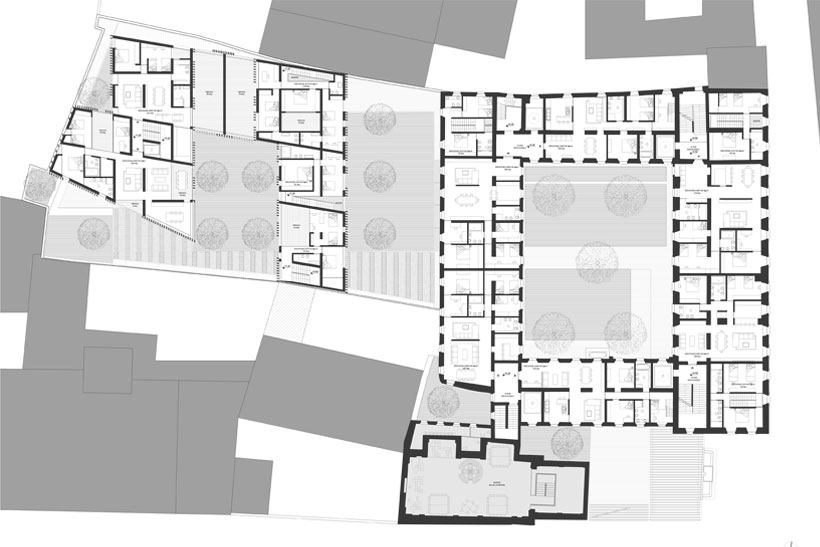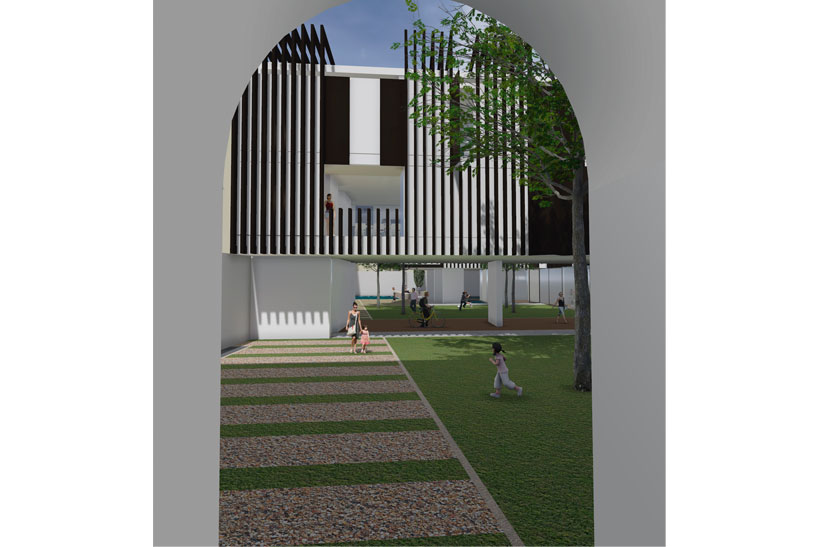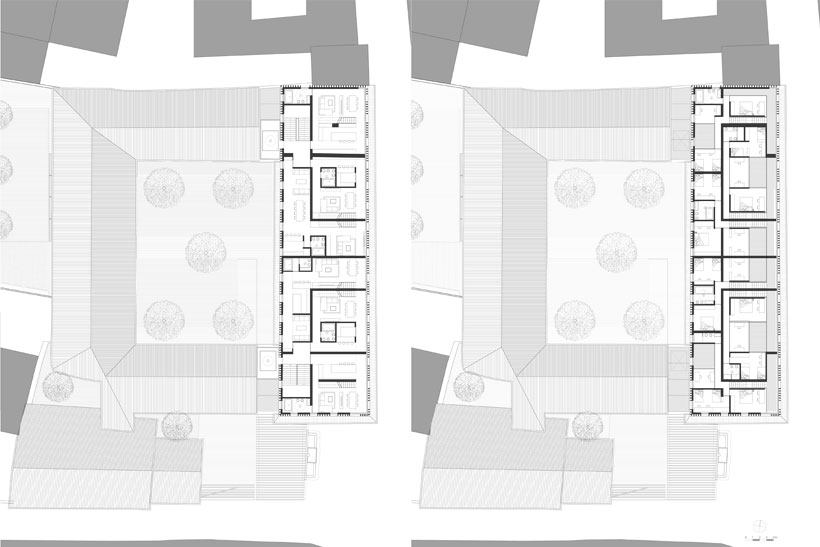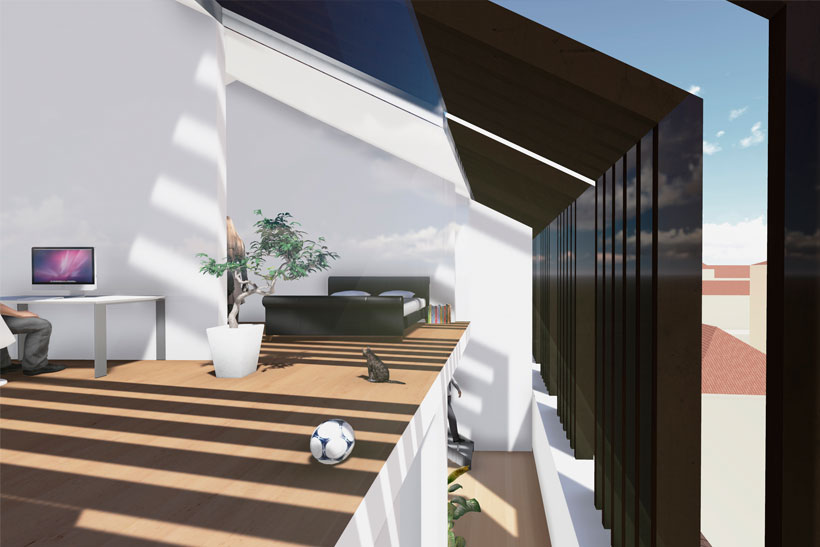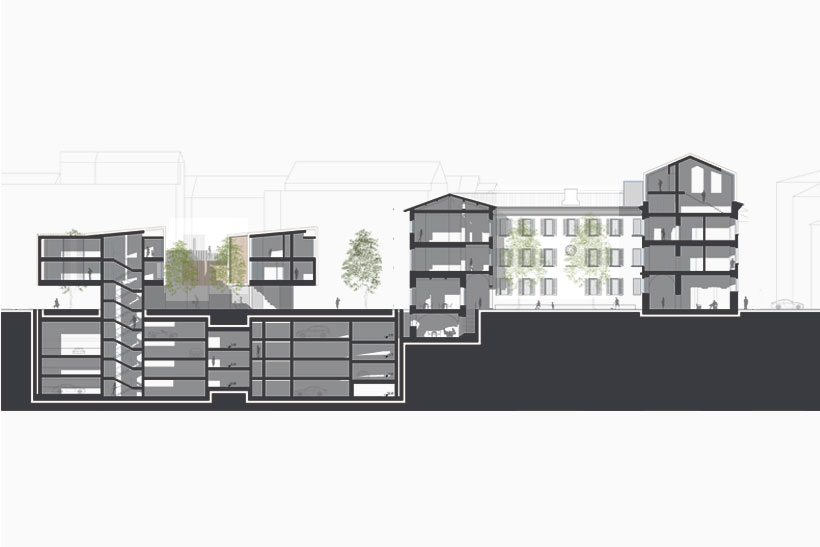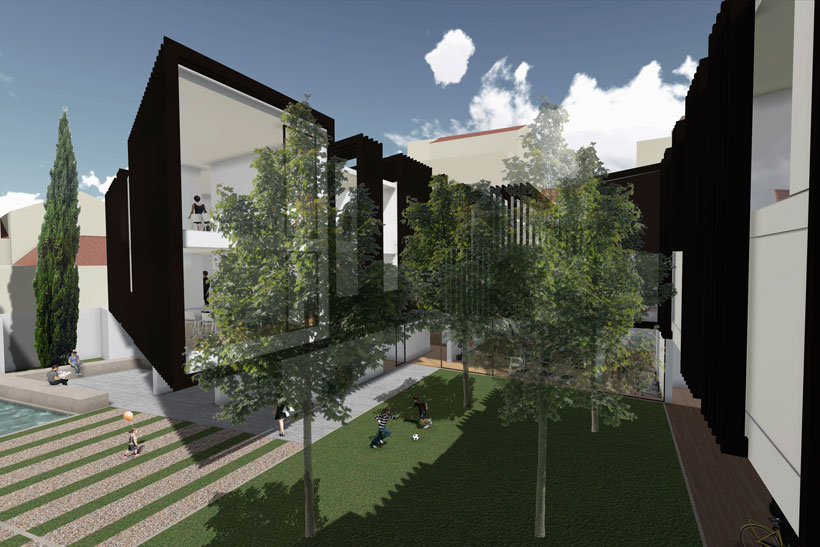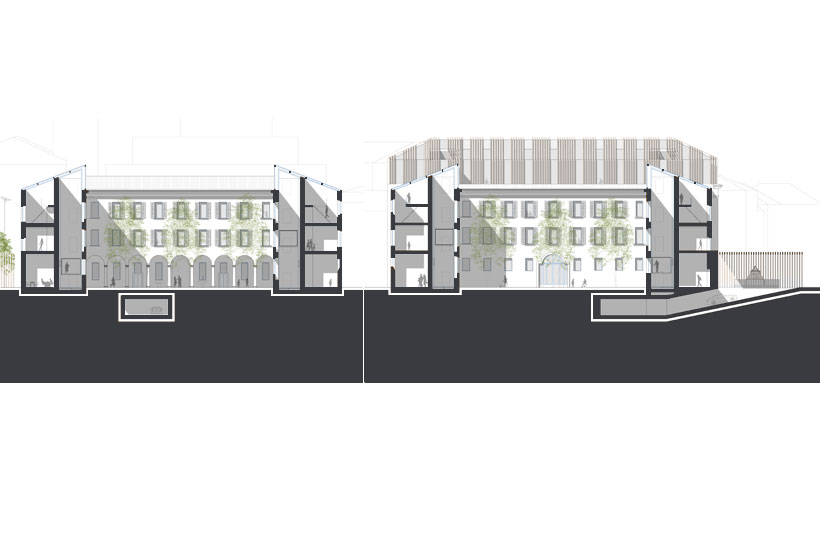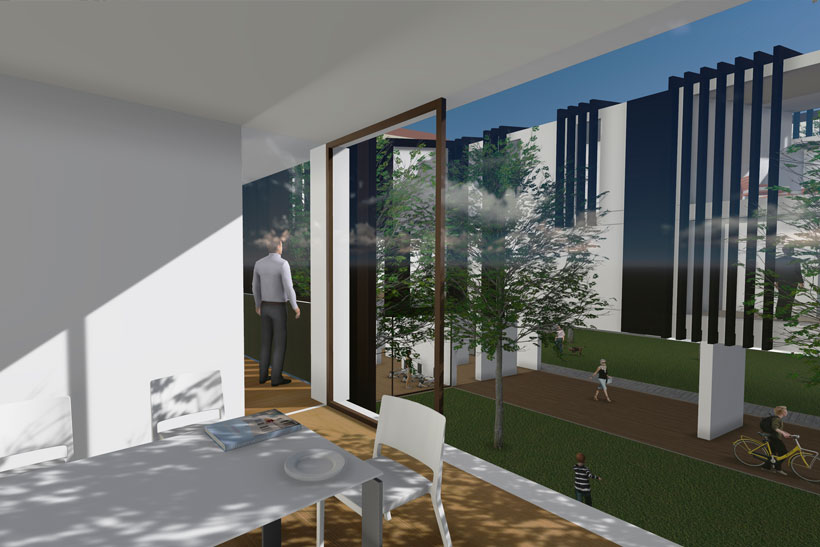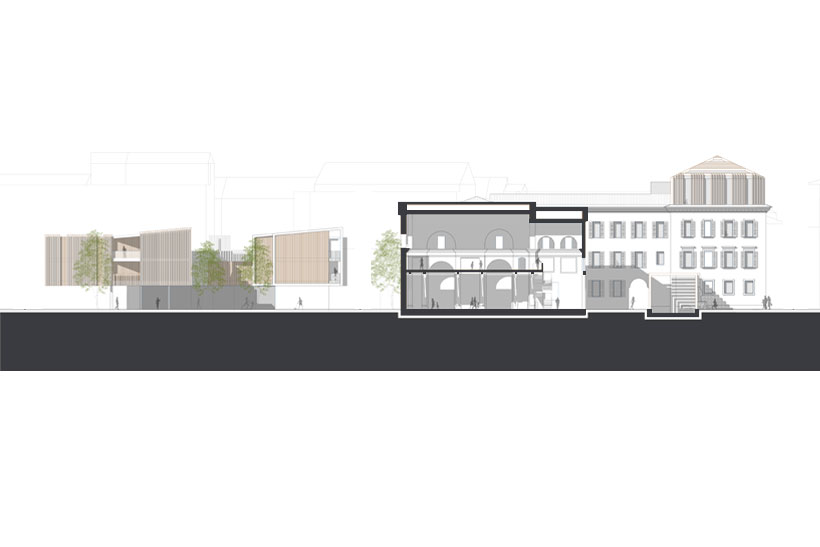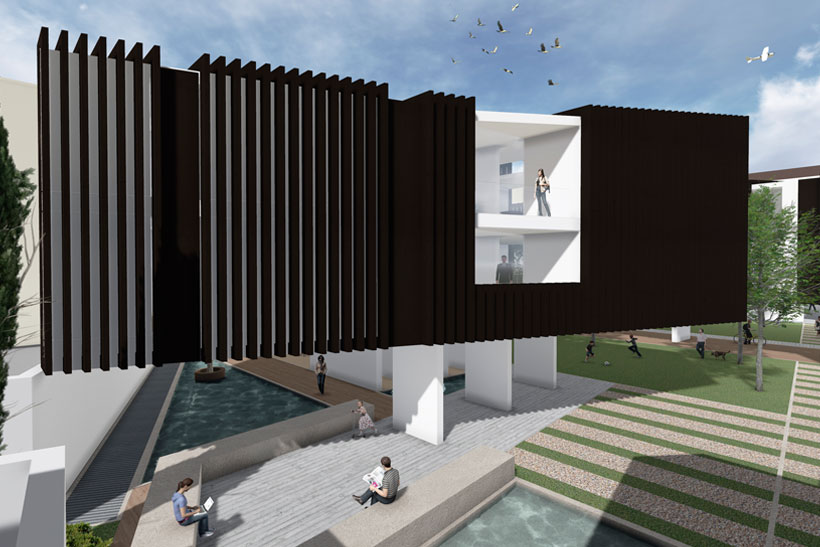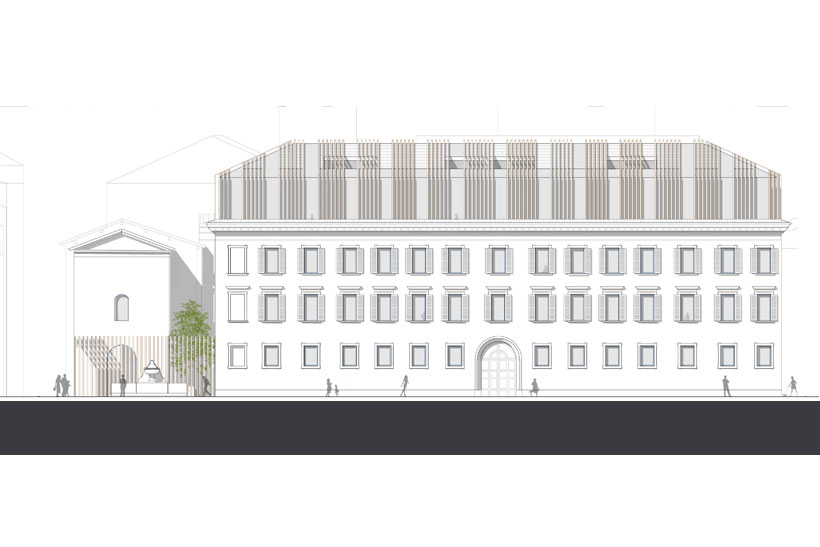PRIVATE ENGAGEMENT
the renovation and restoration project works on the idea of a new internal configuration, which renews most of the building, preserving the historic layout of the facades and eliminating surpluses and incongruous openings. the preservation of the facades composition’s characters is enhanced by an interpretation of the flush shutters on the facade and the figure of frame and sill, often forgotten in the contemporary restoration.
the entire building revolves indoor around the existing staircase, incongruous and not passable. the project maintains the centrality of the staircase, making it independent from the ground floor, through a new interpretation of the entrance hall that rises in its terminal part and constitutes a mezzanine on which to place the ramps. so on the ground floor emerges a single annex/apartment that revolves around the staircase, retrieving the cross-vaulted room as a library in continuity with the existing buildings.
the internal floors, affected by overlapping structures and superficies, are replaced, reconstructing the floors with new lighter and more functional wooden frames, so as to redistribute the levels inside the section.
the main apartment locates on the first floor living room, TV room, kitchen, services and a study room. the second floor outlines the spaces of the bedrooms and a large multipurpose space/playing room, ensuring, by a steel ramp, the landing at a mezzanine study room, that is like a bridge over the spaces of the sleeping area.
PRIVATE ENGAGEMENT
the country house is built in an osmotic relationship with the surrounding landscape. the existing building, possibly built in the seventies, has got no intention to establish a relationship with the landascape but it is a self existing object of ordinary construction and poor quality.
the idea at the base of the new project, vice versa, turns the building upside down starting up from the objective, material, structural and positioning data, thus alllowing the surrounding landscape within itself and redifining a building “box” taylored on the existing, but completely new in the phisical and perceptive dynamics established with the context.
the building was expanded by erecting a new shell which contains the previous one and that is elevated differently from the ground floor according to the different sides and it works adding or deducting in regard to the existing volumes. the main characteristic of the building is its volumetric doubleness, since it is generated by two opposit and slightly different volumes that point out, also on an internal levels point of view, two different parts maybe built in different ages.
all the indoor and outdoor, open and close, covered and uncovered spaces are developed according to the landscape in order to enter it from the house or to host the house itself in a neverending dialectic between outside and inside, thus creating a bioclimatic and sustainable system of volumes, transparencies, fronts, sunscreens and materials.
PRIVATE ENGAGEMENT
a country house is anchored to the horizon line, where the bank of the Tresinaro torrent stands as background and scene of the environmental field. the house reinterprets an historical countryside typology space named porta morta in contemporary terms, defining a hollow space that becomes the fulcrum of architecture.
two side wings that help to ground the house in the plot: they slide on each other by a transparent double height passing through which links and connects the spaces of the bedrooms / studio on the first floor through an hanging balcony. the porch as a solar diaphragm and jasmine canopy configures the open-air extension of the living room, while the first floor rooms extend the house towards the landscape.
the open space on the ground floor places the kitchen in the south-west corner in continuity with the staircase and the tv room in the north-east corner, leaving the double height living space as the core. on the opposite side the private entrance to the house is linked to the services (garage and dependance) through another hanging jasmine canopy.
INVITED DESIGN COMPETITION
1st Prize
an ancient and listed building, heritage of the past, becomes a new home/office, intertwining a dialog between indoor and outdoor, place and space, voids and levels, walls and glasses. the roof with terrace, skylight and pv panels becomes a fifth "facade". like in a Piranesi's work you can move in many directions through the space.
the architectural recovery of the historical listed settlement Casa Gualerzi is based on the preservation of the typological and morphological building’s characters.
the project works on existing indoor levels, reinterpreted contemporarily, whereas voids and full spaces of the historical facades and the typological elements such as the porch, don’t change but becomes key points to define free plans inside the volume, that slide on each other generating double and triple height cavities.
the staircase is studied on the columns original system of the barn. the spaces on the first floor underline the juxtaposition of the central body of the east wing through the introduction of a double flight stair that links all internal levels, appearing as trasparent cases hanging into the volume. this movement of leves originates new enclosed surfaces caring about privacy while, at the same time it allows the hayloft spaces to be read and looked up in their beauty.
PRIVATE ENGAGEMENT
the project tries to configure an idea of living conceived as fluid space, protected but at the same time interconnected with the surrounding landscape, able to grant privacy to the family but to project it perceptively in a wider spatiality, to connect it to the scale of the neighbourhood.
The house presents itself as a diaphragm of open and closed, built and natural spaces variously interlaced. Clearly defined volumetric structures are placed into the fluid space that connects the “inside” with the “outside”, the “built” with the natural, house and landscape.
The building is developed on two floors built on a single dimensional span that rules the relation of an empty and transparent space with volumes (the bedrooms – studios) that set themselves as asymmetrical lenses of an ideal telescope pointed towards the landscape and with aerial surfaces (free projected levels).
the coverings constitue a facing terraces system and pitched roofs with photovoltaic and solar panels, which provide energy sustainability of the project togheter with the system of geothermal probes of the basement.
PRIVATE ENGAGEMENT
a terrace house already configured as a duplex on two staggered levels is transformed by an architectural renovation, which rethinks the interior space. partial demolition of the internal floor allows the house to be flooded with natural light, while connecting the levels through the vacuum.
on the first floor, a double-height living room and a dining room define an open space in which the kitchen and the library-tv room stand out as a series of blocks.
these volumes are connected through a slate flooring up to the staircase, like a black ribbon that conveys to the private spaces and terrace in the attic, where a central hall dedicated to gathering and playing distributes the rooms and services.
on the other side, the completely glazed panoramic terrace becomes a kaleidoscope able to reverberate the sunlight inside. bamboo canes and embedded floor spotlights define a new interior scenography, that visually and perceptively links indoor and outdoor.
INTERNATIONAL 2 STAGE IDEAS COMPETITION
4th Prize
the project has to maintain a physical distance from the existing listed façade to preserve and appreciate the historical characters of the building. it’s interesting for us to create on the ground floor, in the free plot, the club areas and in the empty volume of the existing building a garden with trees, that could be the meeting place and private garden for the owners. the garden becomes the inner courtyard of the complex with different apartments per volumes, transparencies, facings. an outdoor swimming pool complete the basement and ground floor.
on the basement, side by side the parking lot development, the power equipment system for electrical and mechanical treatment, the water basin for the pool, is located the wellness center. the turkish bath faces towards the pool basin by a double glaze glass and on the other side the swimming pool becomes at the basement an aquarium to sight from turkish bath. these two double glass walls allow the natural light to get in the basement. on the ground floor the fitness center and gym are embedded within the common areas and face to the east courtyard. the project tries to build a dynamic fusion of living volumes, open spaces, visual perspectives and staggered floors, that allow to protect at the same time internal privacy and possibility to penetrate and identify the place, intended like sea city scape at urban scale and like green patio at the plot scale. the starting point is to envisage the dwellings’ building as an assembly of three spaces’ belts: the open space towards the sea (terrace as dining room and living room), the inner open space (living room, tv room and open kitchen) and the secluded space towards the rear front (bedrooms and baths). the facings result from the plot and its orientation, so to move the bedrooms to the north (in less warm and more private space facing towards the swimming pool) and the terraces towards the sea developing the levels in the plot side nearest to the multi-storey residential building to reach the 10 units required by the tender.
NATIONAL IDEAS COMPETITION
7th ranked
the project transfers to the building traces and signs highlighted by the context: the main element is the border conceived as a limit between the garden and industrial cities. the residence is built through compositions of borders not conceiving uncrossable
margins but as open frames of inner shapes (the rooms) facing on the city. the border is a connection - mediation between vertical and horizontal, thus re - shaping the rooms differently on each prospect.
it also constitutes a very neat distinction between the ground floor, open and horizontal and the upper levels that are more complex, matt and vertical in their totality.
the distinction reflects the definition mechanism of the program that places on the ground floor all the common and more public service spaces, fading (on the plan) from east to west the importance of the privacy, from the meetiong room, gym and fitness, tv room, relax and reading room, studying room and library up to the rooms. the border, then, builds the prospects as net, architectonic mesh (repurposing of a figure always modified) that correspond to an interpretation modality of the city. this modality is built again inside the building where the different typologies of housing change according to the partition flexibility and according to the future adaptability and accessibility for the disabled persons.
INTERNATIONAL 2 STAGE IDEAS COMPETITION
3rd Prize
the first step in the construction process of the project was a critical approach to the existing complex, that determined the removal of all the incongrous superfetations of the building, in the courtyard area on west, the one of industrial spaces of the XIX century related to the weapon factory and the barracks. these spaces, that have anyway an historical-architectonical appeal, are not the complex constituent elements and in a residential oriented renovation they become unlikely divisible and reusable.
furthermore the multi-storey underground parking can be realised only under the courtyard, without operating on the monumental courtyard’s foundations. from the historic analysis appears that the western courtyard was the garden of the “collegio somasco”, the former college lodged in the building. the project explain again the complex history, redefining a new garden for the building, with a residential use, where is possible to insert a new building that uses the existing surfaces removed, that researches the insertion into the existing building texture, both from the functional point of view and from the visual-aesthetic one, overlapping to the different architectures of the surroundings through a mechanism of interferences for continuity and inclusion.
the dialectic between innovation and tradition includes both the manifestly incongrous volumes on the top floor of the historic building, and the new suspended residential court, almost a wintergarden, an offshoot of the inner court, more private and protected, where a series of structural walls supporting a “contemporary” residential court, immerse into the green and juxaposed to the perimetral walls of the surrounding buildings, often built on the property line.
